Casting out Intrusions
Posted October 2020 in Color Photography, Documentary Photography, New Additions
On this first day of November, the words of American photographer Frederick Britton Hodges, who wrote the following lines about the month in 1915, seem an appropriate tonic for the constant upheaval of the present:
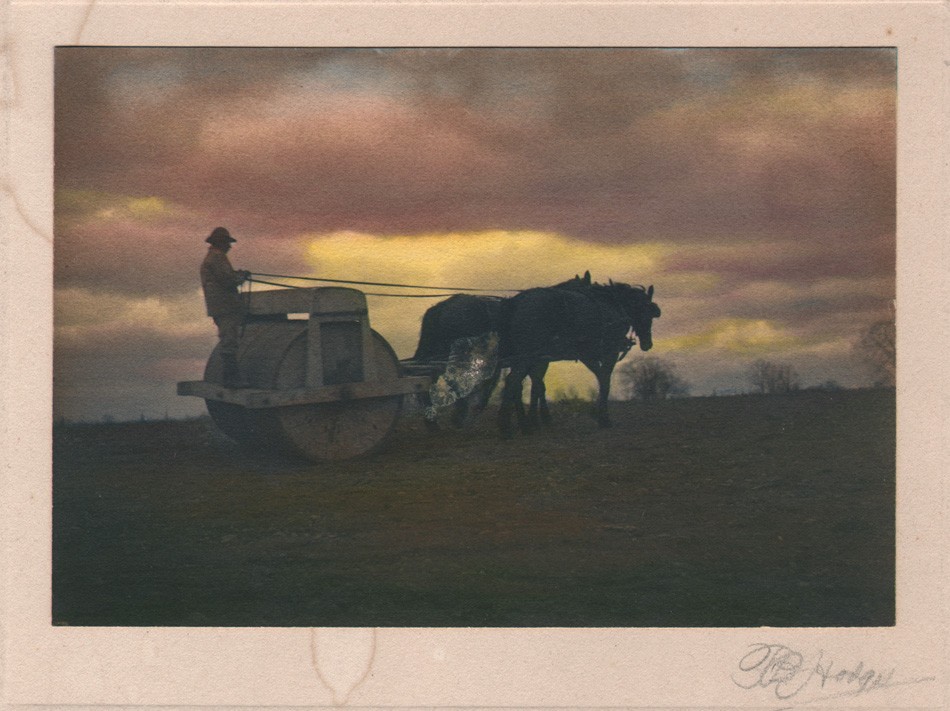 “November Skies”: Frederick Britton Hodges, American: 1868-1955. Vintage platinum print with applied watercolors, ca. 1915: 11.5 x 16.7 cm tipped onto 17.0 x 21.3 cm mount, signed by the artist in graphite at lower right corner. (slight water damage) Born in Rome, New York and spending his entire life there, Hodges was not only a prolific photographer, but a journalist, poet, and naturalist who spent his waking days wandering off the beaten paths of Oneida County New York while documenting the delights of nature with his pen and camera. These often personal and lengthy observations illustrated with his own photographs reached a national audience in photographic journals as well as his local newspaper, the Daily Sentinel of Rome. There, his articles appeared as early as 1886, the year he purchased his first camera and continued until 1938, when his own weekly column was launched. This lasted until 1955, the year of his passing. From: PhotoSeed Archive
“November Skies”: Frederick Britton Hodges, American: 1868-1955. Vintage platinum print with applied watercolors, ca. 1915: 11.5 x 16.7 cm tipped onto 17.0 x 21.3 cm mount, signed by the artist in graphite at lower right corner. (slight water damage) Born in Rome, New York and spending his entire life there, Hodges was not only a prolific photographer, but a journalist, poet, and naturalist who spent his waking days wandering off the beaten paths of Oneida County New York while documenting the delights of nature with his pen and camera. These often personal and lengthy observations illustrated with his own photographs reached a national audience in photographic journals as well as his local newspaper, the Daily Sentinel of Rome. There, his articles appeared as early as 1886, the year he purchased his first camera and continued until 1938, when his own weekly column was launched. This lasted until 1955, the year of his passing. From: PhotoSeed Archive
“The years’ end in November, after all the glorious riot of summer verdure, brings opportunities to observe how full of inspiring force are the more subtle phases of Nature. We are shown to what an extent we are charmed by the variety of form. …
Let us call November the broadening month, the month in which we cast out the selfish intrusions that will creep in and occupy some of the valuable space in our minds, and look with clear, sane eyes. Our ideas are not large enough—no, it is hard to make them so. It takes us a long time to discover good in the work of others, that we disdained, at first, to give a second glance.” (1.)
1. Excerpt: F.B. Hodges: “November”, The Camera, (The Camera Publishing Company): November, 1915. pp. 641-42.
19th Century Game Theory
Posted October 2020 in Alternate Processes, Cameras, Engraving, Games, History of Photography, New Additions, Publishing
19th Century amateur photographers faced trials and tribulations in mastering their new found craft, put into the spotlight after photography itself became a growing mass medium with the marketing of Kodak’s #1 box camera in late 1888.
In 1889, taking advantage of this new large audience-by giving them a fun diversion- the Milton Bradley company of Springfield, Massachusetts produced what is believed to be the world’s first card game on photography, one they called “The Amateur Photographer”. So now, the agony and ecstasy experienced by those dedicated amateurs who owned more advanced cameras and maintained wet darkrooms while embracing art and science could be enjoyed by all. PhotoSeed recently acquired 24 cards of this game from the original set of 36.
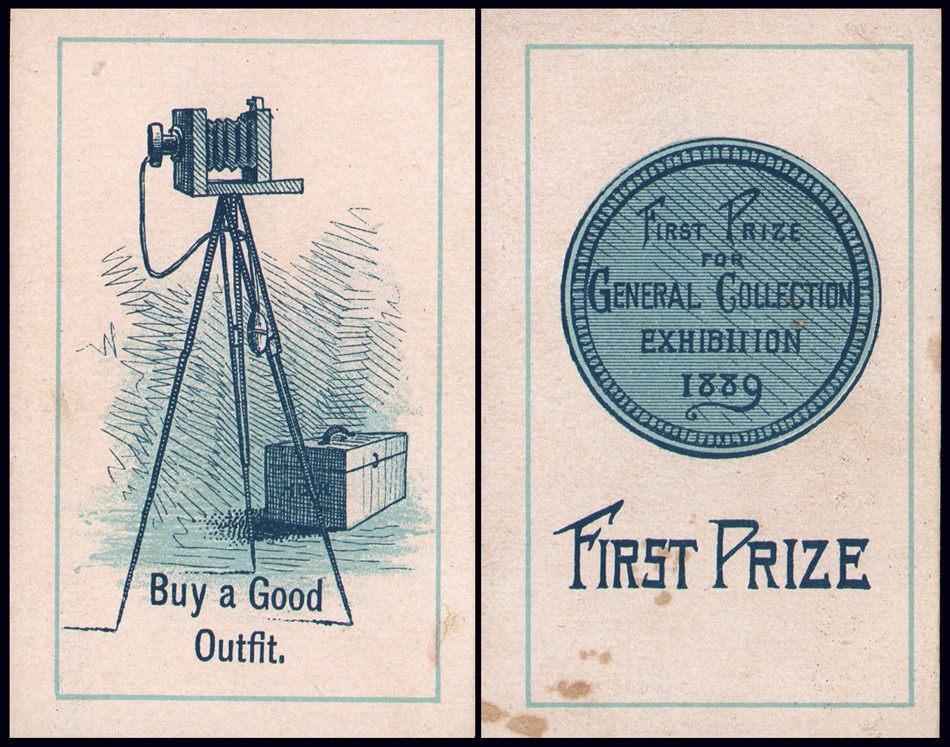 Left: “Buy a Good Outfit” : Right: “First Prize”. 1889. Individual coated-paper lithographic playing cards measuring 8.9 x 5.6 cm (3.5 x 2.25”). Milton Bradley Company, Springfield, MA. The cards making up the game “The Amateur Photographer” were illustrated to show “the triumphs and “hard luck” of an amateur photographer in a way that no member of the craft can fail to appreciate”. From: PhotoSeed Archive
Left: “Buy a Good Outfit” : Right: “First Prize”. 1889. Individual coated-paper lithographic playing cards measuring 8.9 x 5.6 cm (3.5 x 2.25”). Milton Bradley Company, Springfield, MA. The cards making up the game “The Amateur Photographer” were illustrated to show “the triumphs and “hard luck” of an amateur photographer in a way that no member of the craft can fail to appreciate”. From: PhotoSeed Archive
The directions for this Victorian card game can be seen printed below in a vintage advertisement for the 1889-90 Milton Bradley Company “Catalogue of Games, Sectional Pictures, Toys, Puzzles, Blocks and Novelties”.
For the most part up to the present day, physical card ⌘ and board games have never featured the character of the photographer, although video games beginning in the 1990’s have included many, including: “Polaroid Pete” (1992), “Pokémon Snap” (1999), “Dead Rising” (2006): excerpt: “gamers play photojournalist Frank West, who somehow got stuck in a shopping mall in Colorado during the zombie apocalypse. Frank has to fight his way out through hoardes of zombies and uncover the truth with his camera.” and “Spiderman 3” (2007).
Instead, popular culture has taken the lead, with the larger than life character of the photographer (for good and bad) celebrated in films taking hold in our collective imaginations. Some that come to mind by this writer include James Stewart’s character spying out his apartment window using a telephoto camera lens in Alfred Hitchcock’s masterful film “Rear Window”, (1954) and Peter Parker’s more recent alter-ego occupation sans Spiderman suit. Enjoy the following select game cards from this surviving set.
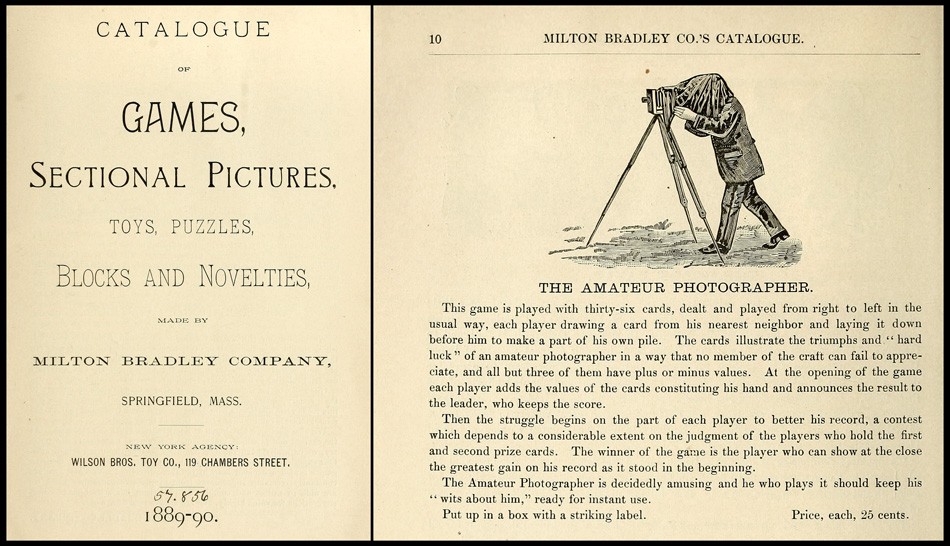 Left: Title Page from “Catalogue of Games, Sectional Pictures, Toys, Puzzles, Blocks and Novelties Made by Milton Bradley Company”. Right: Catalogue listing for card game “The Amateur Photographer” in same volume, 1889-90. (p. 10) Courtesy: Internet Archive
Left: Title Page from “Catalogue of Games, Sectional Pictures, Toys, Puzzles, Blocks and Novelties Made by Milton Bradley Company”. Right: Catalogue listing for card game “The Amateur Photographer” in same volume, 1889-90. (p. 10) Courtesy: Internet Archive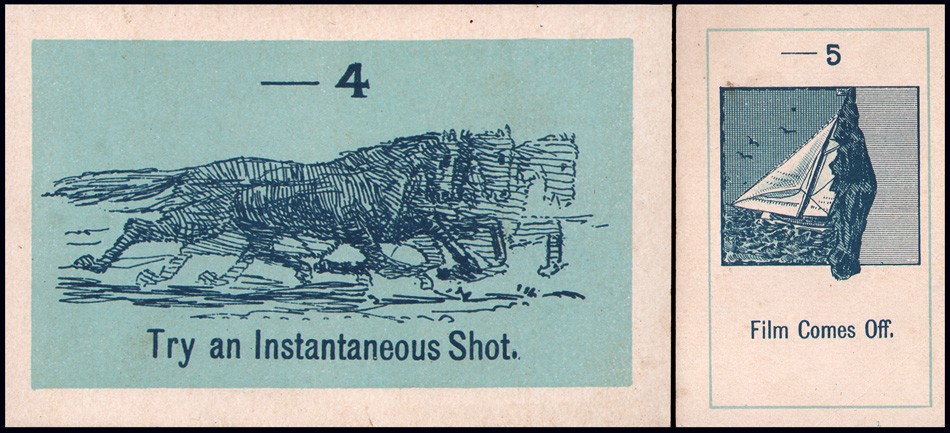 Left: “Try an Instantaneous Shot” : Right: “Film Comes Off”. 1889. Individual coated-paper lithographic playing cards measuring 8.9 x 5.6 cm (3.5 x 2.25”). Milton Bradley Company, Springfield, MA. The cards making up the game “The Amateur Photographer” were illustrated to show “the triumphs and “hard luck” of an amateur photographer in a way that no member of the craft can fail to appreciate”. These two negative value cards show two common problems: film emulsion sensitivity or improper camera settings on left card reveals the amateur’s error of not being able to “stop” the action of a race horse while the chemical darkroom problem of a peeling film emulsion (washing too vigorously perhaps?) ruining the masterwork of a sailboat photograph at right. From: PhotoSeed Archive
Left: “Try an Instantaneous Shot” : Right: “Film Comes Off”. 1889. Individual coated-paper lithographic playing cards measuring 8.9 x 5.6 cm (3.5 x 2.25”). Milton Bradley Company, Springfield, MA. The cards making up the game “The Amateur Photographer” were illustrated to show “the triumphs and “hard luck” of an amateur photographer in a way that no member of the craft can fail to appreciate”. These two negative value cards show two common problems: film emulsion sensitivity or improper camera settings on left card reveals the amateur’s error of not being able to “stop” the action of a race horse while the chemical darkroom problem of a peeling film emulsion (washing too vigorously perhaps?) ruining the masterwork of a sailboat photograph at right. From: PhotoSeed Archive
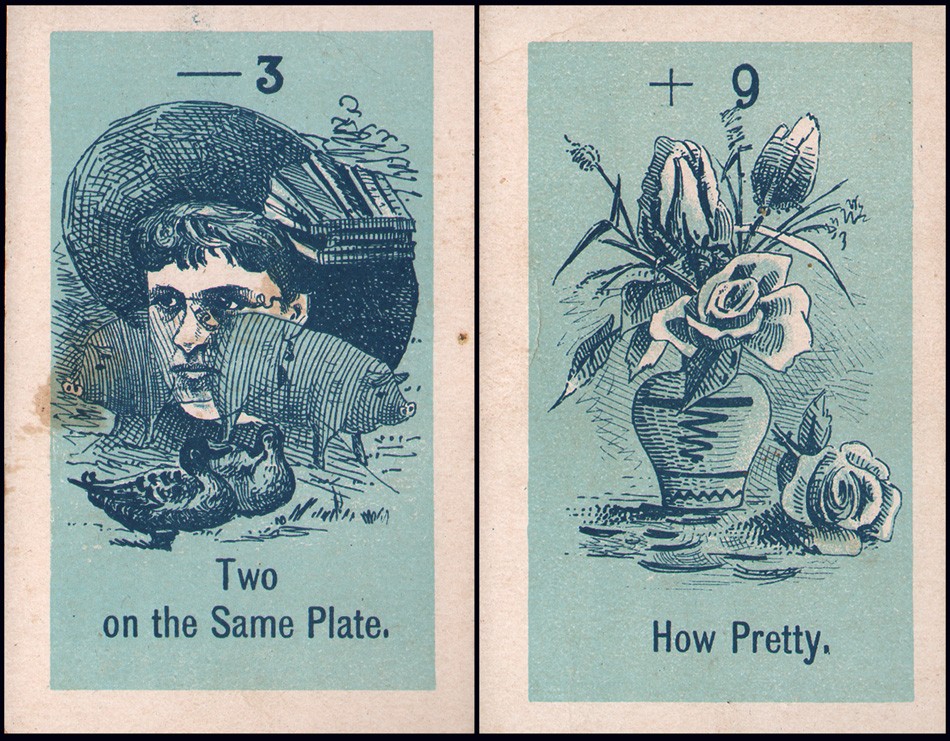 Left: “Two on the Same Plate” : Right: “How Pretty”. 1889. Individual coated-paper lithographic playing cards measuring 8.9 x 5.6 cm (3.5 x 2.25”). Milton Bradley Company, Springfield, MA. The cards making up the game “The Amateur Photographer” were illustrated to show “the triumphs and “hard luck” of an amateur photographer in a way that no member of the craft can fail to appreciate”. The negative value card at left shows the common problem of exposing the same photographic plate twice for two different scenes while at right, a positive value card shows a seemingly perfect picture of a bouquet of flowers. From: PhotoSeed Archive
Left: “Two on the Same Plate” : Right: “How Pretty”. 1889. Individual coated-paper lithographic playing cards measuring 8.9 x 5.6 cm (3.5 x 2.25”). Milton Bradley Company, Springfield, MA. The cards making up the game “The Amateur Photographer” were illustrated to show “the triumphs and “hard luck” of an amateur photographer in a way that no member of the craft can fail to appreciate”. The negative value card at left shows the common problem of exposing the same photographic plate twice for two different scenes while at right, a positive value card shows a seemingly perfect picture of a bouquet of flowers. From: PhotoSeed Archive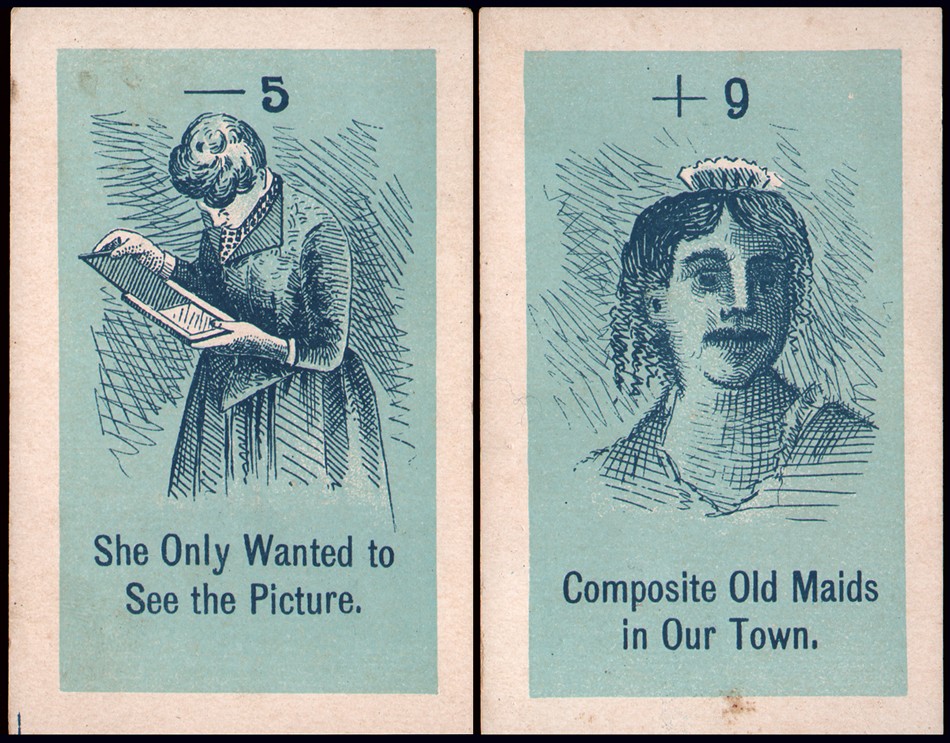 Left: “She Only Wanted to See the Picture” : Right: “Composite Old Maids in Our Town”. 1889. Individual coated-paper lithographic playing cards measuring 8.9 x 5.6 cm (3.5 x 2.25”). Milton Bradley Company, Springfield, MA. The cards making up the game “The Amateur Photographer” were illustrated to show “the triumphs and “hard luck” of an amateur photographer in a way that no member of the craft can fail to appreciate”. Gender sexism depicting the foibles of the female sex was alive and well when Amateur Photography first came into fashion- evidenced by the negative value card at left of a woman peeking at the results of an exposed photographic plate before the negative was properly fixed in the darkroom. Owing to the fact Photography was then a very expensive hobby and career opportunities for women in general were completely lacking, the majority of practitioners were men. But this would soon change, particularly after the dawn of the 20th Century, when Photography actually became one of the few occupations women were encouraged to pursue outside the home. At right, in a twist of this same gender sexism, a positive value card reveals itself in the form of this photographic portrait of an “old maid”, complete with mustache and tiara? or hair comb- with comparisons to later portraits of Queen Victoria by the card artist possibly being the so-called “humorous” intent. From: PhotoSeed Archive
Left: “She Only Wanted to See the Picture” : Right: “Composite Old Maids in Our Town”. 1889. Individual coated-paper lithographic playing cards measuring 8.9 x 5.6 cm (3.5 x 2.25”). Milton Bradley Company, Springfield, MA. The cards making up the game “The Amateur Photographer” were illustrated to show “the triumphs and “hard luck” of an amateur photographer in a way that no member of the craft can fail to appreciate”. Gender sexism depicting the foibles of the female sex was alive and well when Amateur Photography first came into fashion- evidenced by the negative value card at left of a woman peeking at the results of an exposed photographic plate before the negative was properly fixed in the darkroom. Owing to the fact Photography was then a very expensive hobby and career opportunities for women in general were completely lacking, the majority of practitioners were men. But this would soon change, particularly after the dawn of the 20th Century, when Photography actually became one of the few occupations women were encouraged to pursue outside the home. At right, in a twist of this same gender sexism, a positive value card reveals itself in the form of this photographic portrait of an “old maid”, complete with mustache and tiara? or hair comb- with comparisons to later portraits of Queen Victoria by the card artist possibly being the so-called “humorous” intent. From: PhotoSeed Archive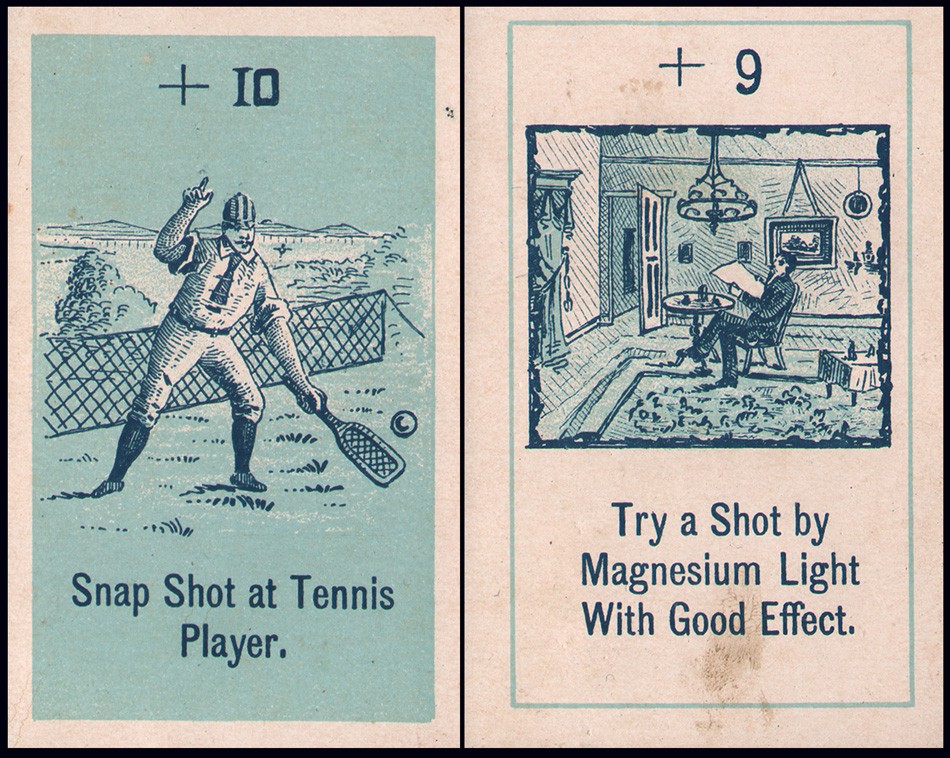 Left: “Snap Shot at Tennis Player” : Right: “Try a Shot by Magnesium Light With Good Effect”. 1889. Individual coated-paper lithographic playing cards measuring 8.9 x 5.6 cm (3.5 x 2.25”). Milton Bradley Company, Springfield, MA. The cards making up the game “The Amateur Photographer” were illustrated to show “the triumphs and “hard luck” of an amateur photographer in a way that no member of the craft can fail to appreciate”. These two high value cards reveal the very tricky technical goal of freezing sports action at left- something rarely attempted at the time- and at right, the undertaking of a so-called “flashlight” photograph. This was achieved on a photographic plate through the intense illumination given off during the ignition of flash powder made up of a mixture of nitrate and magnesium held off camera by the photographer. From: PhotoSeed Archive
Left: “Snap Shot at Tennis Player” : Right: “Try a Shot by Magnesium Light With Good Effect”. 1889. Individual coated-paper lithographic playing cards measuring 8.9 x 5.6 cm (3.5 x 2.25”). Milton Bradley Company, Springfield, MA. The cards making up the game “The Amateur Photographer” were illustrated to show “the triumphs and “hard luck” of an amateur photographer in a way that no member of the craft can fail to appreciate”. These two high value cards reveal the very tricky technical goal of freezing sports action at left- something rarely attempted at the time- and at right, the undertaking of a so-called “flashlight” photograph. This was achieved on a photographic plate through the intense illumination given off during the ignition of flash powder made up of a mixture of nitrate and magnesium held off camera by the photographer. From: PhotoSeed Archive
⌘ One exception found online by this website is the 2016 Japanese card game “Wind the Film!”, a half-frame camera photography themed card game for 2-4 players.
Henry Ravell: Embracing Art & Photography
Posted August 2020 in Alternate Processes, Cameras, Color Photography, Documentary Photography, Framing, History of Photography, New Additions, Painters|Photographers, Photography, Scientific Photography, Significant Photographers
“Coburnesque”, or, in the style of American master pictorialist Alvin Langdon Coburn, (1882-1966) was how the work of now forgotten American photographer Henry Ravell (1864-1930) was described in 1908 by London’s Amateur Photographer & Photographic News.
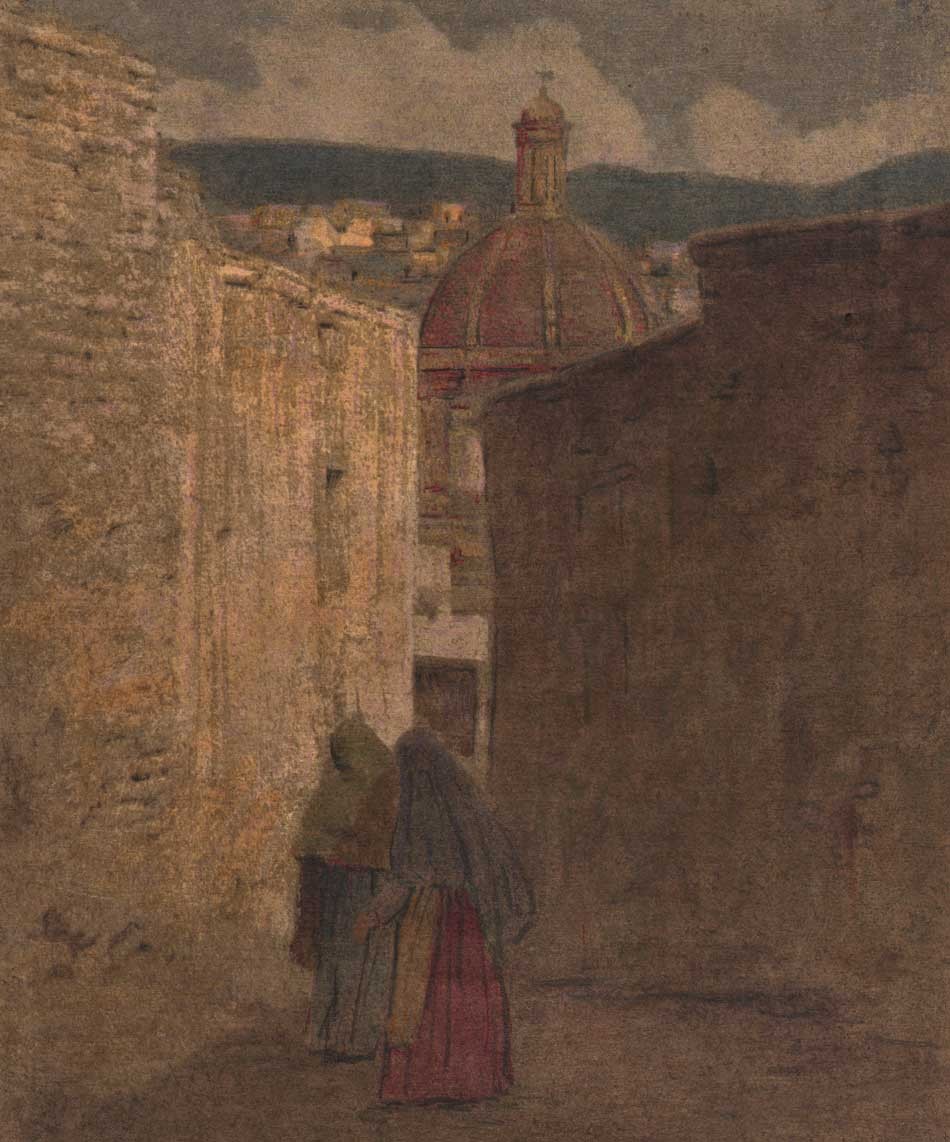 Detail: “A Narrow Street-Guanajuato”: Henry Ravell, American: 1864-1930. Vintage multiple color gum print c. 1907-14. Image: 33.1 x 23.5 presented loose within brown paper folder with overall support dimensions of 39.8 x 58.8 cm. In central Mexico, with the dome of a church framing the skyline at center in background, two native women make their way along one of Guanajuato’s narrow streets. Henry Ravell perfected the gum bichromate process to a very high level. Probably in 1906-07, he began experimenting in multiple color gum. In Germany, around this same time, similar examples were being done by the brothers Theodor (1868-1943) and Oscar Hofmeister, (1871-1937) as well as Heinrich Wilhelm Müller. (1859-1933) From: PhotoSeed Archive
Detail: “A Narrow Street-Guanajuato”: Henry Ravell, American: 1864-1930. Vintage multiple color gum print c. 1907-14. Image: 33.1 x 23.5 presented loose within brown paper folder with overall support dimensions of 39.8 x 58.8 cm. In central Mexico, with the dome of a church framing the skyline at center in background, two native women make their way along one of Guanajuato’s narrow streets. Henry Ravell perfected the gum bichromate process to a very high level. Probably in 1906-07, he began experimenting in multiple color gum. In Germany, around this same time, similar examples were being done by the brothers Theodor (1868-1943) and Oscar Hofmeister, (1871-1937) as well as Heinrich Wilhelm Müller. (1859-1933) From: PhotoSeed Archive
Under the headline “Local Colour.” by journal critic “The Magpie”, a discussion of the merits around Ravell’s new color multiple gum printing process was considered for their large readership. Commenting on a series of his Mexican church photographs published in the May issue of the Century Magazine, “Magpie” writes:
“Who is this Mr. Ravell, and what is his wonderful colour process, which is not “on the negative”? Multiple-gum, one may surmise- and one may also venture to guess that Mr. “de Forest” (Lockwood de Forest- editor) has, notwithstanding this flourish of trumpets, nothing very much to tell us. The Ravell photographs, illustrating “Some Mexican Churches,” are Coburnesque, and the pictures are, in their very Yankee style, fine and strong- which is more than can be said for those in our English monthlies. Couldn’t Mr. Ravell be induced to send some examples of his work to the R.P.S. or Salon? We badly need some new American exhibitors.” (June 16, p. 600)
A reassessment of Ravell’s output is long overdue in elevating him back to his rightful position as one of the more important practitioners of pictorialism in the early 20th Century canon of American artistic photographers.
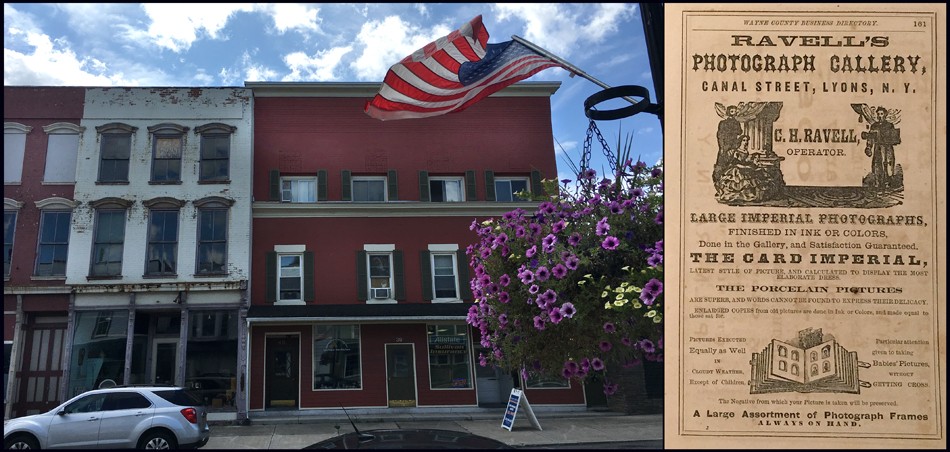 Left: Henry Ravell was only a toddler when his father Charles Henry Ravell (1833-1917) opened a skylight photographic studio on the third floor of this brick building painted red located on Canal Street in Lyons, New York around 1865-66. Shown here in the summer of 2019, the entrance was at the present day 36 Canal street (on the far right of the photo-presently an insurance office) but was numbered #30 Canal before the turn of the 20th Century. It was here that Henry was “brought up in photography from childhood and became an expert in all processes before he was twelve years old”. Right: A full-page advertisement for “Ravell’s Photograph Gallery” operated by C.H. Ravell at the Canal street building appeared in the 1867-68 Wayne County (New York) Business Directory. At the time, Charles Ravell would have been using the wet-plate process, and the ad highlights “Large Imperial Photographs finished in Ink or Colors”… “Pictures Executed Equally as Well in Cloudy Weather Except of Children”… “Particular attention given to taking Babies’ Pictures, without Getting Cross”. Left: David Spencer for PhotoSeed Archive; Right: courtesy Museum of Wayne County History.
Left: Henry Ravell was only a toddler when his father Charles Henry Ravell (1833-1917) opened a skylight photographic studio on the third floor of this brick building painted red located on Canal Street in Lyons, New York around 1865-66. Shown here in the summer of 2019, the entrance was at the present day 36 Canal street (on the far right of the photo-presently an insurance office) but was numbered #30 Canal before the turn of the 20th Century. It was here that Henry was “brought up in photography from childhood and became an expert in all processes before he was twelve years old”. Right: A full-page advertisement for “Ravell’s Photograph Gallery” operated by C.H. Ravell at the Canal street building appeared in the 1867-68 Wayne County (New York) Business Directory. At the time, Charles Ravell would have been using the wet-plate process, and the ad highlights “Large Imperial Photographs finished in Ink or Colors”… “Pictures Executed Equally as Well in Cloudy Weather Except of Children”… “Particular attention given to taking Babies’ Pictures, without Getting Cross”. Left: David Spencer for PhotoSeed Archive; Right: courtesy Museum of Wayne County History.
Undoubtedly, “Magpie” would have been pleased to know Henry Ravell sprung from fine English photographic stock. His father Charles Henry Ravell (1833-1917) emigrated to the U.S. from Boston, England and was known to have been active as a Daguerreotypist as early as 1857, (1.) his trade shingle set up early in the New York state village of Chittenango. By 1860, U.S. Census records show he had moved to Wolcott, New York, where he was a commercial photographer. Surviving cdv photographs from here bearing his C.H. Ravell back-stamp reveal some of his clients were young men heading off to fight in the American Civil War.
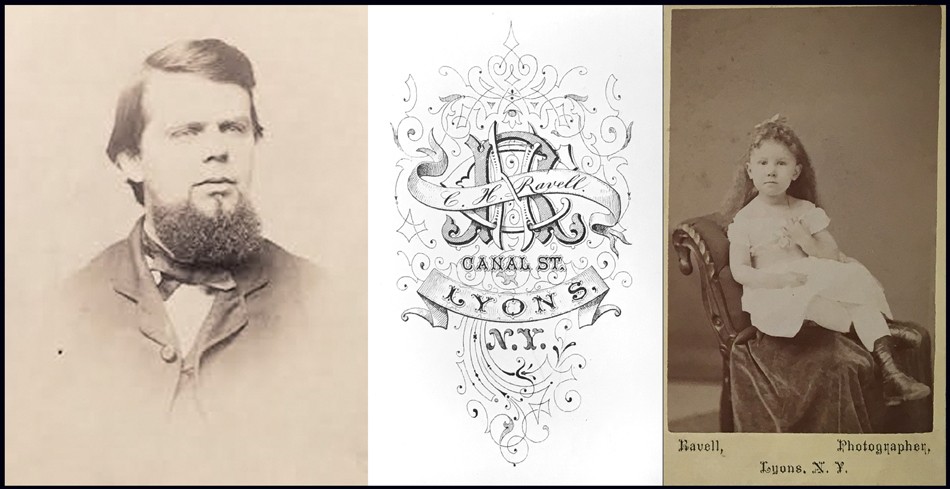 Left: This is the only known portrait of commercial portrait photographer Charles Henry Ravell, father of Henry Ravell. The carte de visite albumen portrait shows him most likely in his early 30’s, after he had settled in Lyons, New York. Born Charles Herring Ravel in Boston, England, he emigrated to the U.S. as a young man, with an early notice of his Daguerreotypist skills from 1857 showing he was living in Chittenango, New York State. By 1860, he had settled in Wolcott, where son Henry was born in early 1864. By 1867 or earlier, he and wife Cornelia Dudley Ravell (1840-1908) and Henry had moved permanently to nearby Lyons. Middle & Right: This elaborate backstamp engraving for C.H. Ravell’s Canal Street skylight studio in Lyons is ca. 1865-80, with the albumen portrait subject (Right) a young girl posing on a commercially available chair. Both: courtesy Museum of Wayne County History
Left: This is the only known portrait of commercial portrait photographer Charles Henry Ravell, father of Henry Ravell. The carte de visite albumen portrait shows him most likely in his early 30’s, after he had settled in Lyons, New York. Born Charles Herring Ravel in Boston, England, he emigrated to the U.S. as a young man, with an early notice of his Daguerreotypist skills from 1857 showing he was living in Chittenango, New York State. By 1860, he had settled in Wolcott, where son Henry was born in early 1864. By 1867 or earlier, he and wife Cornelia Dudley Ravell (1840-1908) and Henry had moved permanently to nearby Lyons. Middle & Right: This elaborate backstamp engraving for C.H. Ravell’s Canal Street skylight studio in Lyons is ca. 1865-80, with the albumen portrait subject (Right) a young girl posing on a commercially available chair. Both: courtesy Museum of Wayne County History
Born in early January of 1864 in Wolcott, Henry Ravell is known to have embraced photography from a very young age. As a boy, he became his father’s apprentice. Lockwood de Forest, (1850-1932) an important influence on Henry for the rest of his life in the 20th Century and important American painter and furniture designer, wrote in 1908 that Henry:
“was born and brought up in photography from childhood and became an expert in all processes before he was twelve years old.” Through a fascinating confluence of sons starting out in their father’s professions, Henry Ravell graduated to having an interest in art, and he studied water-color painting with the noted American artist and Tonalist Henry Ward Ranger, (1858-1916) probably in his late teens or early 20’s. The artist and student had much in common. Like Charles Henry Ravell, who had established his own Canal Street photo studio in Lyons, N.Y. by 1867, (Wayne County Business Directory) Ranger’s father Ward Valencourt Ranger (1835–1905) had opened his own commercial studio in 1868 in Syracuse, N.Y., 55 miles east of Lyons, almost at the same time. Like Henry Ravell working for his father at an early age, Henry Ranger was also known to have worked in his father’s establishment as a young man.
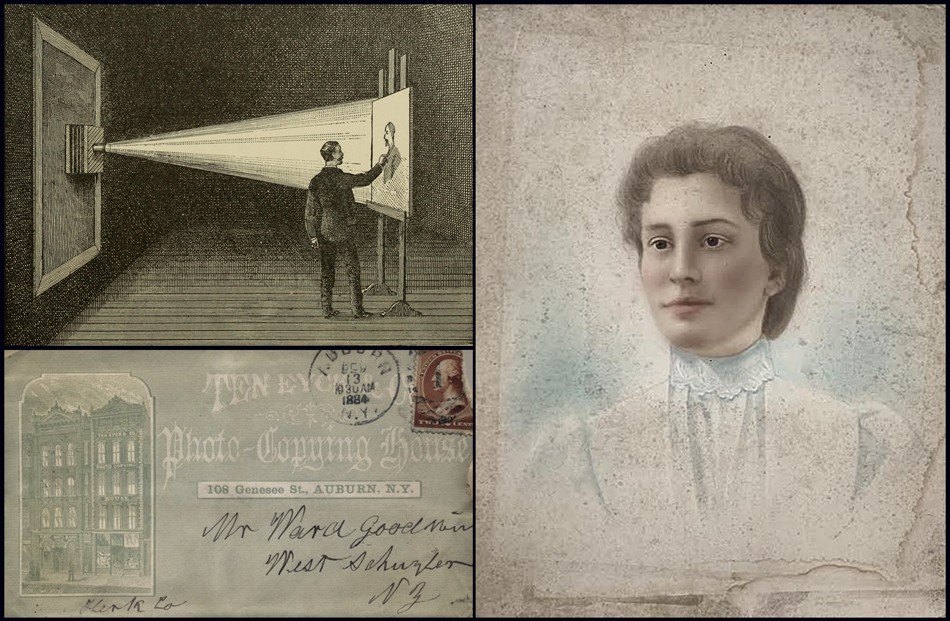 Upper Left: “Negative Outline-Dark Chamber”: woodcut from 1892 volume “Crayon Portraiture: Complete Instructions for making Crayon Portraits on Crayon Paper and on Platinum, Silver, and Bromide Enlargements” by J.A. Barhydt. In the early 1880’s, Henry Ravell worked in a similar capacity as the artist shown here for the Photo-Copying House Ten Eyck & Co. of Auburn, New York. Woodcut shows an enlarged and enhanced crayon portrait being made freehand on the easel at right. A photographic negative from a sitter has been placed inside a large box camera at left while mounted in front of a scrimmed-off window. This provides the light source for the projection within a darkened room while the artist goes over the outline and shadow lines of the projection in a first step. Other variations of crayon portraits began with an artist working in a lighted studio with charcoal and pastels after the initial projected outline on crayon, gelatin, bromide, etc. papers had been chemically fixed. Ten Eyck advertised on cover stationary from 1884: “Fine Portraits in India Ink, Water Colors and Crayon, By the Association of Celebrated Portrait Artists…” (From: Internet Archive) Lower Left: December, 1884 postmarked cover (envelope) from Ten Eyck & Co. Portraits located at 108 Genesee St., Auburn, N.Y. (8.5 x 15.0 cm-right margin perished) Ravell worked at the firm about this time, making a living combining his skill of photography and art. In the late 1880’s to early 1890’s, he became an agent for Ten Eyck after moving to Mexico. From: PhotoSeed Archive. Right: “Crayon-style Portrait” ca. 1890-5: (50.9 x 40.5 cm) enhanced water-color or India inks applied by hand to unknown (bromide?) photographic emulsion fixed onto light grade cardboard matrix. Henry Ravell produced similar crayon-style portraits for Ten Eyck, with this example from an unknown artist featuring Mary Carruthers Tucker (1877-1940) as subject, then living in Provo-City Utah. She was the spouse of C.R. Tucker, whose work is featured at PhotoSeed. From: PhotoSeed Archive
Upper Left: “Negative Outline-Dark Chamber”: woodcut from 1892 volume “Crayon Portraiture: Complete Instructions for making Crayon Portraits on Crayon Paper and on Platinum, Silver, and Bromide Enlargements” by J.A. Barhydt. In the early 1880’s, Henry Ravell worked in a similar capacity as the artist shown here for the Photo-Copying House Ten Eyck & Co. of Auburn, New York. Woodcut shows an enlarged and enhanced crayon portrait being made freehand on the easel at right. A photographic negative from a sitter has been placed inside a large box camera at left while mounted in front of a scrimmed-off window. This provides the light source for the projection within a darkened room while the artist goes over the outline and shadow lines of the projection in a first step. Other variations of crayon portraits began with an artist working in a lighted studio with charcoal and pastels after the initial projected outline on crayon, gelatin, bromide, etc. papers had been chemically fixed. Ten Eyck advertised on cover stationary from 1884: “Fine Portraits in India Ink, Water Colors and Crayon, By the Association of Celebrated Portrait Artists…” (From: Internet Archive) Lower Left: December, 1884 postmarked cover (envelope) from Ten Eyck & Co. Portraits located at 108 Genesee St., Auburn, N.Y. (8.5 x 15.0 cm-right margin perished) Ravell worked at the firm about this time, making a living combining his skill of photography and art. In the late 1880’s to early 1890’s, he became an agent for Ten Eyck after moving to Mexico. From: PhotoSeed Archive. Right: “Crayon-style Portrait” ca. 1890-5: (50.9 x 40.5 cm) enhanced water-color or India inks applied by hand to unknown (bromide?) photographic emulsion fixed onto light grade cardboard matrix. Henry Ravell produced similar crayon-style portraits for Ten Eyck, with this example from an unknown artist featuring Mary Carruthers Tucker (1877-1940) as subject, then living in Provo-City Utah. She was the spouse of C.R. Tucker, whose work is featured at PhotoSeed. From: PhotoSeed Archive
Sometime in the early 1880’s after Henry had finished this “apprenticeship”, he moved to nearby Auburn, New York, about halfway to Syracuse from Lyons, to a job crafting Crayon and Pastel portrait photographic enlargements for Ten Eyck & Co. At the time, this firm is said to have been the largest of its’ type in the world. This gave Henry additional artistic skills, combining his interest in photography and art, an important and influential confluence indeed. He kept at this profession until either 1883, according to Lockwood de Forest, or as late as 1892, in a posthumous biography of Henry by sister Florence.
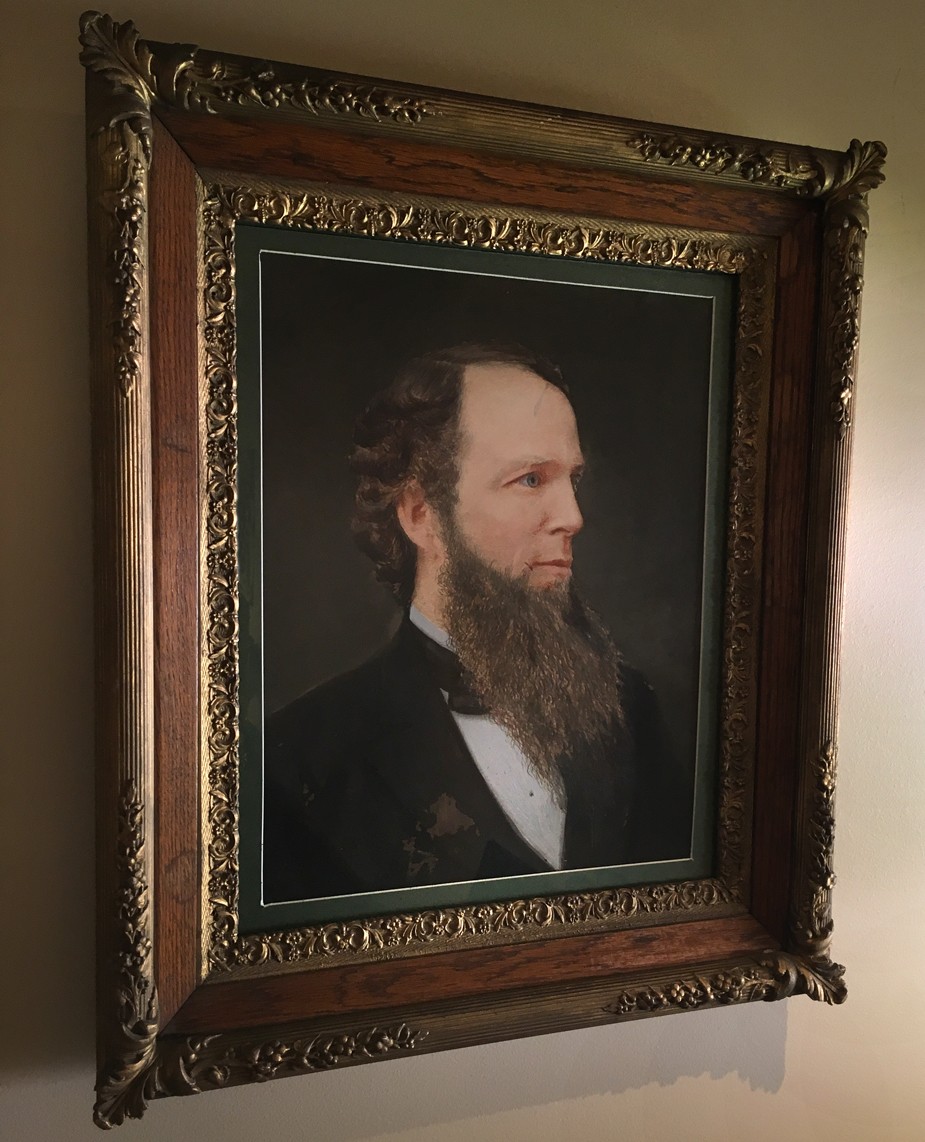 “Portrait of John Lee Cole”: Henry Ravell, American: 1864-1930. Ca. 1885 Gouache and or Oil? on paper, mounted within period wood frame bearing inscription “John L. Cole to Jason Parker, 1918”. This very rare example of a surviving painting by photographer Henry Ravell is now owned by the Museum of Wayne County History in Lyons, New York. Cole was a 1859 graduate of Yale and grandson of the Rev. John Cole, a founder with John Wesley of the Methodist Church in the U.S.. In 1862 he was admitted to the bar and later became a banker in Lyons for Mirick & Cole. An earlier 1882 notice of Henry’s artistic pursuits was published in The Democrat and Chronicle newspaper of Rochester, New York: “Henry Ravell, of Lyons, was in this city last night, on his return from Medina, (New York-editor) where he disposed of two of his latest paintings for $70.” (November 26) Photo by David Spencer for PhotoSeed Archive- artwork courtesy Museum of Wayne County History, Lyons N.Y.
“Portrait of John Lee Cole”: Henry Ravell, American: 1864-1930. Ca. 1885 Gouache and or Oil? on paper, mounted within period wood frame bearing inscription “John L. Cole to Jason Parker, 1918”. This very rare example of a surviving painting by photographer Henry Ravell is now owned by the Museum of Wayne County History in Lyons, New York. Cole was a 1859 graduate of Yale and grandson of the Rev. John Cole, a founder with John Wesley of the Methodist Church in the U.S.. In 1862 he was admitted to the bar and later became a banker in Lyons for Mirick & Cole. An earlier 1882 notice of Henry’s artistic pursuits was published in The Democrat and Chronicle newspaper of Rochester, New York: “Henry Ravell, of Lyons, was in this city last night, on his return from Medina, (New York-editor) where he disposed of two of his latest paintings for $70.” (November 26) Photo by David Spencer for PhotoSeed Archive- artwork courtesy Museum of Wayne County History, Lyons N.Y.
At this time, Henry is said to have moved to Cuernavava Mexico, south of Mexico City, where he became a far-flung agent for the Ten Eyck & Co. firm, although a certain amount of traveling back and forth to the U.S. and the family home was probably the reality. To wit, the Minnesota State Census for 1895 lists his occupation as “artist”, claiming an American residence while living with his father, mother and younger brother, Charles Ravell Jr. in the city of St. Paul. Here his father finished out his career running a photo studio on Western Ave. from 1890-92.
During the mid 1880’s back in Lyons, a fascinating yet presently unsubstantiated account of Henry’s involvement with the development of the first Kodak camera is relevant for background on his future career as a master photographer who became a striver with his own agenda. This event is worthy of historical contemplation in the present from reminisces provided in the aforementioned posthumous biography published in 1940:
“George Eastman of Rochester, New York, was a family friend. During a visit of three or four weeks, Mr. Eastman worked on and developed his famous Kodak, with the help of my father and brother.” “Their workshop was the basement of our former home at 70 Broad Street, Lyons. Mr. Eastman offered my father stock in the Kodak Company, which he often regretted not accepting.” (2.)
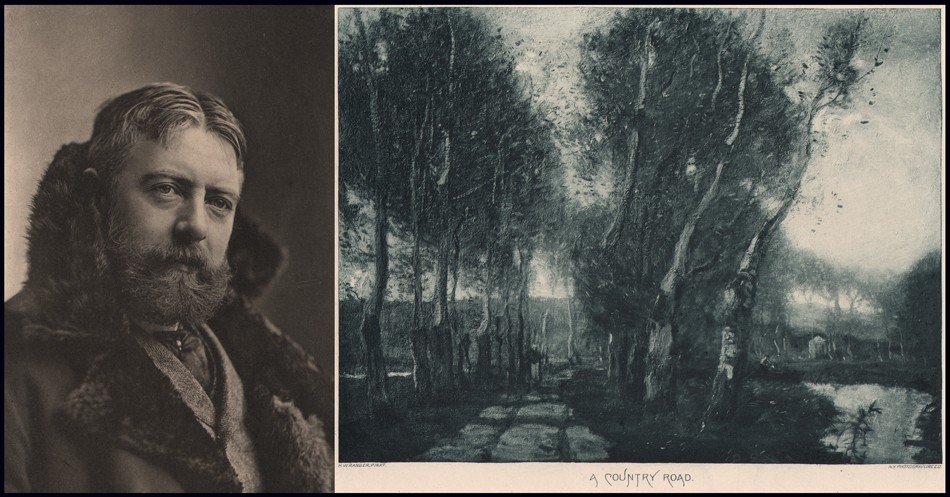 Left: “H.W. Ranger” (Henry Ward Ranger): Napoleon Sarony, American: born Quebec. (1821-1896) Photogravure published in periodical "Sun & Shade": New York: May, 1894: whole #69: N.Y. Photo-Gravure Co.: 22.4 x 15.2 | 34.9 x 27.6 cm. Like Henry Ravell assisting in his father’s studio, American artist and Tonalist Henry Ward Ranger (1858-1916) worked in his own father’s studio as a young man. Later, Ranger taught Henry water-color painting, probably when Ravell was in his late teens or early 20’s. The “Sun & Shade” periodical noting of Ranger: “His work in Lower Canada won him great repute, and as a water-color painter, before taking to oil-painting, he was undeniably excellent.” Right: “A Country Road”: Henry Ward Ranger, American. (1858-1916) Photogravure published in periodical "Sun & Shade": New York: May, 1894: whole #69: N.Y. Photo-Gravure Co.: 17.1 x 22.7 | 27.6 x 34.9 cm. Ranger’s bucolic painting style reveals itself in this simple country scene of a roadway lined with trees, probably done in Holland. Scenes like this would have undoubtedly made an impression on Henry the fledgling art student, assuming he had access to reproductions or the originals of his teacher’s work. On Ranger in the periodical: “He is an admirer and follower of the best Dutch school of art, and has made it his pleasure and his duty to pay many visits to Holland, in order to be perfectly au fait with the excellencies of its best masters.” On “A Country Road”: “It is seldom that so simple a subject becomes so important in form and color-so full of air and freedom, and so admirably harmonious in its proportions.” Both from: PhotoSeed Archive
Left: “H.W. Ranger” (Henry Ward Ranger): Napoleon Sarony, American: born Quebec. (1821-1896) Photogravure published in periodical "Sun & Shade": New York: May, 1894: whole #69: N.Y. Photo-Gravure Co.: 22.4 x 15.2 | 34.9 x 27.6 cm. Like Henry Ravell assisting in his father’s studio, American artist and Tonalist Henry Ward Ranger (1858-1916) worked in his own father’s studio as a young man. Later, Ranger taught Henry water-color painting, probably when Ravell was in his late teens or early 20’s. The “Sun & Shade” periodical noting of Ranger: “His work in Lower Canada won him great repute, and as a water-color painter, before taking to oil-painting, he was undeniably excellent.” Right: “A Country Road”: Henry Ward Ranger, American. (1858-1916) Photogravure published in periodical "Sun & Shade": New York: May, 1894: whole #69: N.Y. Photo-Gravure Co.: 17.1 x 22.7 | 27.6 x 34.9 cm. Ranger’s bucolic painting style reveals itself in this simple country scene of a roadway lined with trees, probably done in Holland. Scenes like this would have undoubtedly made an impression on Henry the fledgling art student, assuming he had access to reproductions or the originals of his teacher’s work. On Ranger in the periodical: “He is an admirer and follower of the best Dutch school of art, and has made it his pleasure and his duty to pay many visits to Holland, in order to be perfectly au fait with the excellencies of its best masters.” On “A Country Road”: “It is seldom that so simple a subject becomes so important in form and color-so full of air and freedom, and so admirably harmonious in its proportions.” Both from: PhotoSeed Archive
Memories can sometimes be suspect, but several details of Florence’s biography are important and worth following up on, with this website happy to accept the challenge. By tracking down old street addresses, the Ravell family home as published in the 1886-87 Lyons residential directory was actually found to be located as 40 Broad Street. (William Smith, whose occupation was Express Transfer Agent, lived at 70 Broad St. as published in the same directory) Coupled with the knowledge that Lyons street addresses had been renumbered, probably in the early 20th Century, and cross-referencing with a 1904 Sanborn Fire Insurance Company map found online at the Library of Congress, the former and still standing Ravell home built in 1850 revealed itself to be the present day 64 Broad Street. All of this effort, if somehow confirming a claim George Eastman had actually spent time in Lyons was true, could result in a potentially fascinating footnote to the development of one of the most important inventions of the 19th Century- The Kodak No. 1 Camera which debuted in 1888: “By far the most significant event in the history of amateur photography”, according to the Met Museum in New York City.
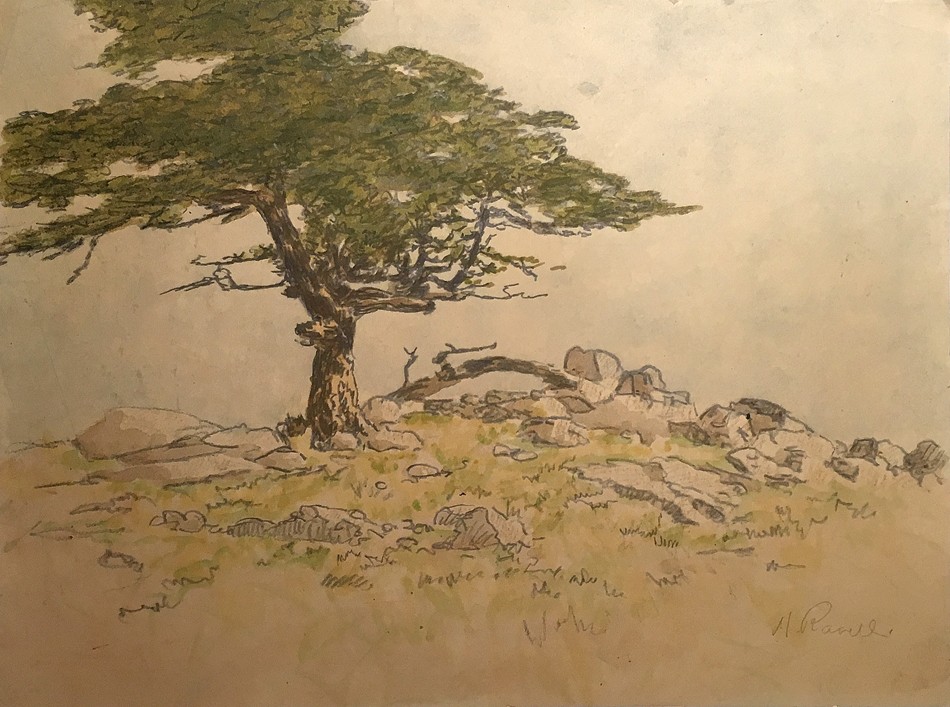 “Cypress Tree -Pebble Beach”: Henry Ravell, American: 1864-1930. Vintage watercolor drawing on paper: ca. 1915-20. (Museum of Wayne County History accession #Pi 176f with verso sticker additionally listing number 148 and $30.00) One of the few known examples of a watercolor drawing by Ravell is this delicate landscape featuring a lone cypress tree springing from a rock outcropping in Pebble Beach on California’s Monterey Peninsula. It may depict the world famous “Lone Cypress”, an approximately 250 year-old Monterey Cypress standing today on a granite hillside off the famed 17-Mile Drive. Courtesy: Museum of Wayne County History, Lyons N.Y.
“Cypress Tree -Pebble Beach”: Henry Ravell, American: 1864-1930. Vintage watercolor drawing on paper: ca. 1915-20. (Museum of Wayne County History accession #Pi 176f with verso sticker additionally listing number 148 and $30.00) One of the few known examples of a watercolor drawing by Ravell is this delicate landscape featuring a lone cypress tree springing from a rock outcropping in Pebble Beach on California’s Monterey Peninsula. It may depict the world famous “Lone Cypress”, an approximately 250 year-old Monterey Cypress standing today on a granite hillside off the famed 17-Mile Drive. Courtesy: Museum of Wayne County History, Lyons N.Y.
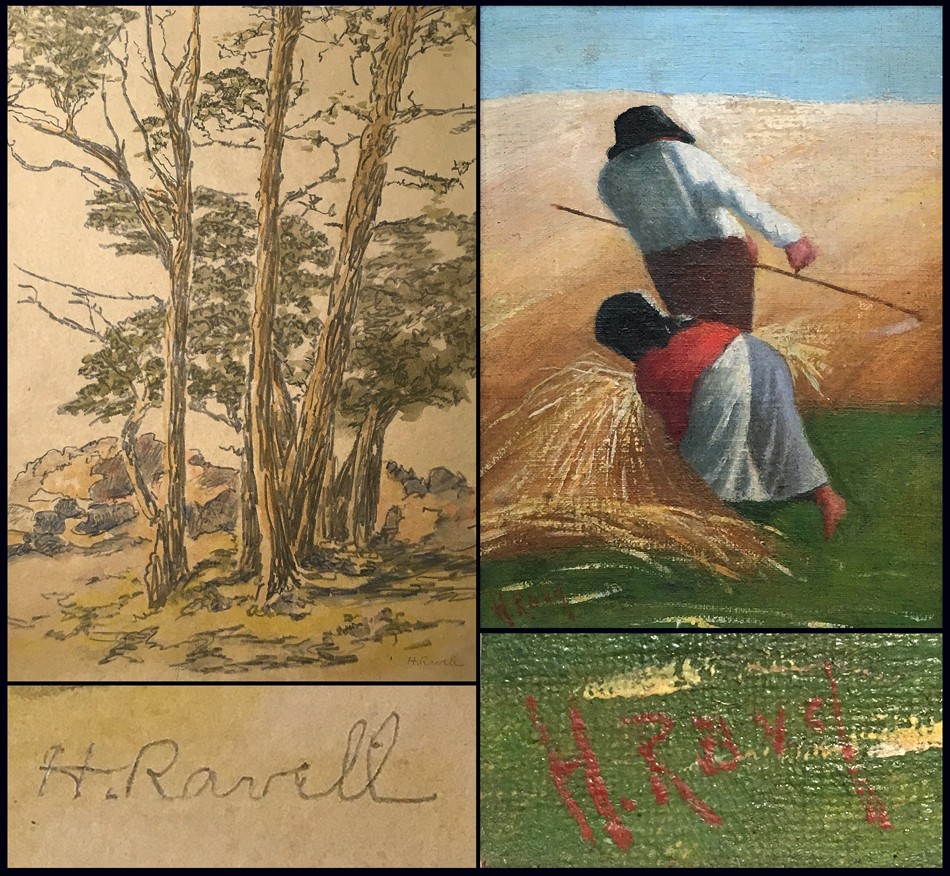 This panel reveals the artistic styles of two distinct artists signing their work nearly identically. It’s presented with the hope a distinction can be made for a larger audience. The reality at present: nearly every painting returned on web searches is misattributed to being by photographer/artist Henry Ravell. Left Diptych: Top: “Cypress Trees at Pebble Beach”: Henry Ravell, American: 1864-1930. Vintage watercolor drawing on paper: ca. 1915-20. (Museum of Wayne County History accession #Pi 176e with verso sticker additionally listing number 147 and $20.00) This is one of three rare watercolor drawings by Ravell. Showing a stand of cypress trees in Pebble Beach on California’s Monterey Peninsula, the signature of “H.Ravell” in graphite has been enlarged in separate bottom panel. Courtesy: Museum of Wayne County History. Right Diptych: Top: “The Ripers” (The Reapers): Henry Etienne Ravel, American, born Naples Italy to French citizens. (1872-1962) Oil on artists board: ca. 1946: 20.5 x 15.4 presented within wood frame (not shown) 24.5 x 19.4 x 2.0 cm. Two field workers harvest wheat, a small landscape most likely depicting the Italian countryside. Henry Ravel immigrated to America in 1906 and became a naturalized US citizen in 1920. A transportation clerk by trade in the early 1920’s, his paintings- many done in Europe- date from ca. 1930’s-1950’s. Enlarged signature at bottom panel: “H. Ravel”. From: PhotoSeed Archive
This panel reveals the artistic styles of two distinct artists signing their work nearly identically. It’s presented with the hope a distinction can be made for a larger audience. The reality at present: nearly every painting returned on web searches is misattributed to being by photographer/artist Henry Ravell. Left Diptych: Top: “Cypress Trees at Pebble Beach”: Henry Ravell, American: 1864-1930. Vintage watercolor drawing on paper: ca. 1915-20. (Museum of Wayne County History accession #Pi 176e with verso sticker additionally listing number 147 and $20.00) This is one of three rare watercolor drawings by Ravell. Showing a stand of cypress trees in Pebble Beach on California’s Monterey Peninsula, the signature of “H.Ravell” in graphite has been enlarged in separate bottom panel. Courtesy: Museum of Wayne County History. Right Diptych: Top: “The Ripers” (The Reapers): Henry Etienne Ravel, American, born Naples Italy to French citizens. (1872-1962) Oil on artists board: ca. 1946: 20.5 x 15.4 presented within wood frame (not shown) 24.5 x 19.4 x 2.0 cm. Two field workers harvest wheat, a small landscape most likely depicting the Italian countryside. Henry Ravel immigrated to America in 1906 and became a naturalized US citizen in 1920. A transportation clerk by trade in the early 1920’s, his paintings- many done in Europe- date from ca. 1930’s-1950’s. Enlarged signature at bottom panel: “H. Ravel”. From: PhotoSeed Archive
The earliest published references to Ravell’s photographic work in the popular press is found around 1905, when Boston’s Photo-Era, writing for their December issue, pronounces him “A new star of the first magnitude”, although noting his two pictures: “Pleasant Valley” and “Viga Canal”, “do not represent him at his best.” This assessment also including listing him on the journal’s noteworthy list of exhibitors whose work had been accepted for the Second American Photographic Salon which ran from 1905-06.
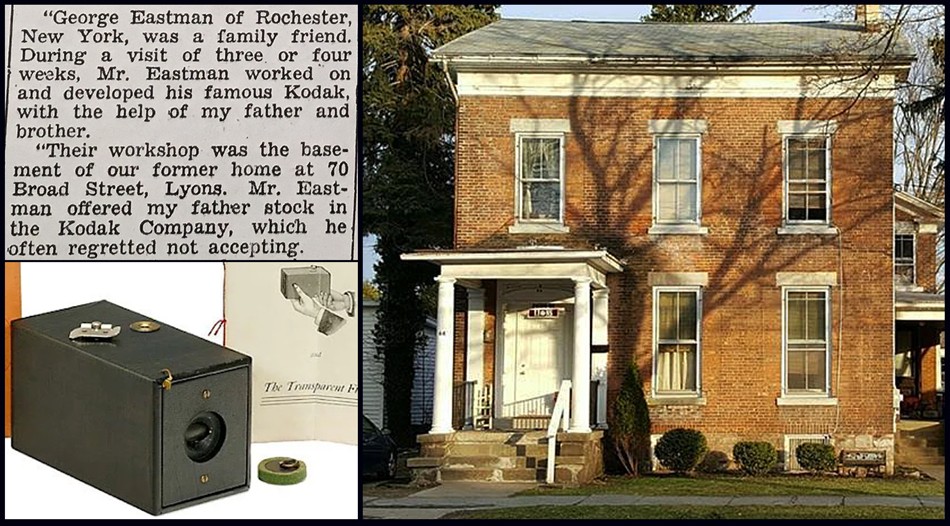 Upper Left: This quote by Henry Ravell’s older sister Florence Ravell Lothrop appeared in The Lyons Republican & Clyde Times on March 21, 1940 stating Henry and their father Charles Henry Ravell had worked with a young George Eastman in developing the world’s first Kodak camera from 1888 in the basement workshop of their Lyons home. Clipping courtesy Museum of Wayne County History. Lower Left: An original Kodak No. 1 camera from 1888 shown with its lens cap and original documents appeared as Lot 0238 and sold by Auction Team Breker of Cologne, Germany on September 30, 2006. The Metropolitan Museum of Art in New York states: “By far the most significant event in the history of amateur photography was the introduction of the Kodak #1 camera in 1888. Invented and marketed by George Eastman (1854–1932), a former bank clerk from Rochester, New York, the Kodak was a simple box camera that came loaded with a 100-exposure roll of film”. Courtesy Auction Team Breker. Far Right: Built in 1850, the former Ravell family home in Lyons, New York was actually located at 64 Broad Street-seen here: not 70 Broad Street as stated in the clipping. The actual address was confirmed by this website using Sanborn fire insurance maps and a Lyons residential street directory from 1886-7. Home exterior courtesy 2018 online real estate sales listing.
Upper Left: This quote by Henry Ravell’s older sister Florence Ravell Lothrop appeared in The Lyons Republican & Clyde Times on March 21, 1940 stating Henry and their father Charles Henry Ravell had worked with a young George Eastman in developing the world’s first Kodak camera from 1888 in the basement workshop of their Lyons home. Clipping courtesy Museum of Wayne County History. Lower Left: An original Kodak No. 1 camera from 1888 shown with its lens cap and original documents appeared as Lot 0238 and sold by Auction Team Breker of Cologne, Germany on September 30, 2006. The Metropolitan Museum of Art in New York states: “By far the most significant event in the history of amateur photography was the introduction of the Kodak #1 camera in 1888. Invented and marketed by George Eastman (1854–1932), a former bank clerk from Rochester, New York, the Kodak was a simple box camera that came loaded with a 100-exposure roll of film”. Courtesy Auction Team Breker. Far Right: Built in 1850, the former Ravell family home in Lyons, New York was actually located at 64 Broad Street-seen here: not 70 Broad Street as stated in the clipping. The actual address was confirmed by this website using Sanborn fire insurance maps and a Lyons residential street directory from 1886-7. Home exterior courtesy 2018 online real estate sales listing.
Florence Ravell, quoting Lockwood de Forest for her 1940 article on Henry, expanded on her brothers new found respect in the profession, particularly in his mastery of the gum print, which would soon establish him as a major talent:
“Henry Ravell was recognized as one of the leading artists in his profession, both in this country and in Europe where he had exhibited, and has been a contributor to many of the photographic magazines, where a description of his technical processes are given. He succeeded in making a gum print in one printing with results far beyond the finest etchings and very similar in character.”
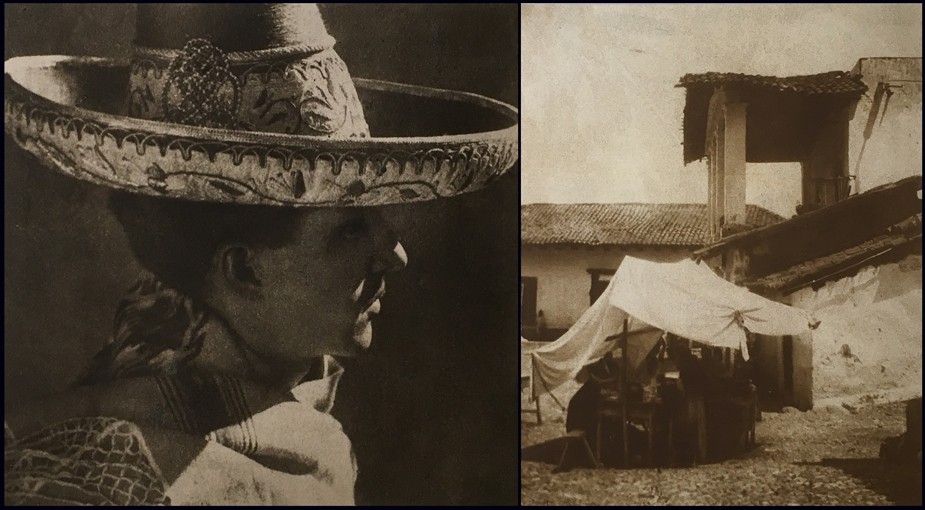 Left: “Mexican Peon”: Henry Ravell, American: 1864-1930. Vintage gum print ca. 1900-15. Alternately titled “A Mexican Peon” as listed in the catalogue of a 1978 retrospective of the artist at the Museum of Wayne County History, although an uncropped variant titled “Mexican Charro” (Mexican Cowboy)- is a more accurate description based on his fancily embroidered sombrero- is held by the California Museum of Photography, Riverside. Right: “Eating Tent-Taxco, Mexico”: Henry Ravell, American: 1864-1930. Vintage gum print ca. 1900-15. These photographs are part of a grouping of 18 singular gum prints featuring Mexican scenes and subjects held in the collection of the Museum of Wayne County History, Lyons N.Y.
Left: “Mexican Peon”: Henry Ravell, American: 1864-1930. Vintage gum print ca. 1900-15. Alternately titled “A Mexican Peon” as listed in the catalogue of a 1978 retrospective of the artist at the Museum of Wayne County History, although an uncropped variant titled “Mexican Charro” (Mexican Cowboy)- is a more accurate description based on his fancily embroidered sombrero- is held by the California Museum of Photography, Riverside. Right: “Eating Tent-Taxco, Mexico”: Henry Ravell, American: 1864-1930. Vintage gum print ca. 1900-15. These photographs are part of a grouping of 18 singular gum prints featuring Mexican scenes and subjects held in the collection of the Museum of Wayne County History, Lyons N.Y.
Henry perfected the gum bichromate process to a very high level. Probably in 1906-07, he began experimenting in multiple color gum. In Germany, around this same time, similar examples were being done by the brothers Theodor (1868-1943) and Oscar Hofmeister, (1871-1937) as well as Heinrich Wilhelm Müller (1859-1933) (3.) The following quote in the December,1908 issue of Boston’s Photo-Era encapsulates the admiration these gum prints received:
“It will be remembered that last summer Henry Ravell, of Mexico, exhibited in New York and Boston his results in multiple gum-bichromate printing in color. They excited considerable interest at the time, especially among our painters, who were very cordial in their praise of Mr. Ravell’s beautiful work, for it showed, in an eminent degree, the artistic possibilities of the gum-process.” (p. 300)
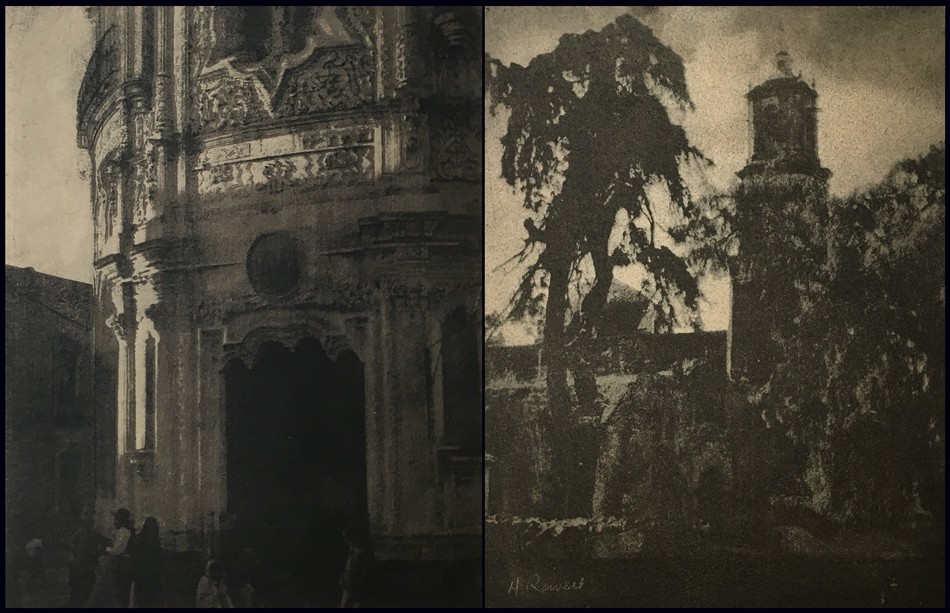 Left: “Chapel of the Holy Well near Mexico City”: Henry Ravell, American: 1864-1930. Vintage gum print ca. 1900-15. Right: “Church, Mexico”: Henry Ravell, American: 1864-1930. Vintage gum print ca. 1900-15. Museum of Wayne County History accession #Pi 176p with verso sticker additionally listing number 2 and $5.00) Featuring church architecture, these are part of a grouping of 18 singular gum prints of Mexican scenes and subjects held in the collection of the Museum of Wayne County History, Lyons N.Y.
Left: “Chapel of the Holy Well near Mexico City”: Henry Ravell, American: 1864-1930. Vintage gum print ca. 1900-15. Right: “Church, Mexico”: Henry Ravell, American: 1864-1930. Vintage gum print ca. 1900-15. Museum of Wayne County History accession #Pi 176p with verso sticker additionally listing number 2 and $5.00) Featuring church architecture, these are part of a grouping of 18 singular gum prints of Mexican scenes and subjects held in the collection of the Museum of Wayne County History, Lyons N.Y.
Again writing in 1940, Florence wrote of her younger brother: “but his favorite work was photography, and the gum print process. This process was original with an Austrian who refused to make it known, but Henry experimented until he developed it, and later gave the formula to the world.” The conjecture of this website is the possibility Henry originally gleaned and modified his own multiple gum color process from the earlier work of Austrian photographer Heinrich Kühn. (1866-1944) An 1897 example of a three-color gum print by him can be found in the collection of the Museum für Kunst und Gewerbe in Hamburg Germany.
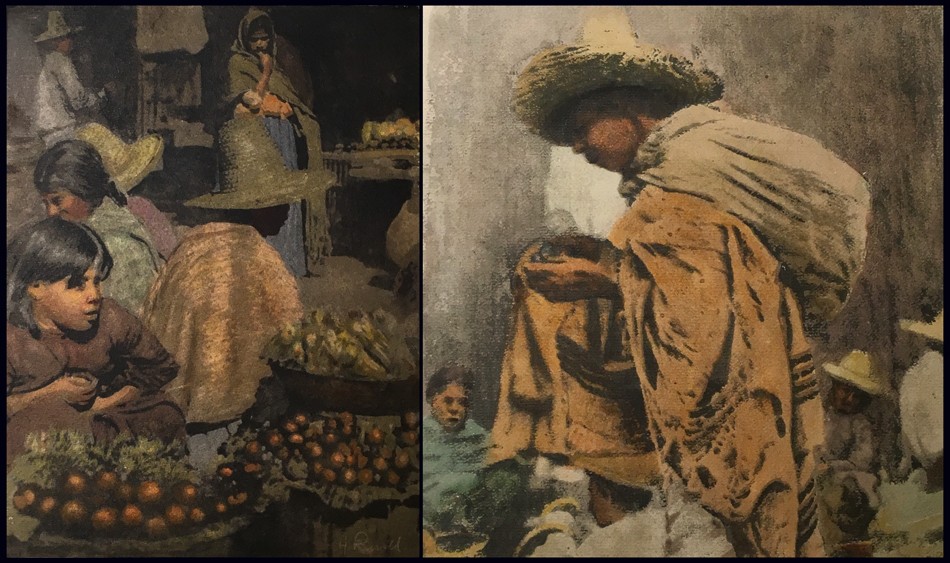 Left: “Mexican Vegetable Seller”: Henry Ravell, American: 1864-1930. Vintage multiple color gum print c. 1907-14. Right: “Mexican Youth”: Henry Ravell, American: 1864-1930. Vintage multiple color gum print c. 1907-14. These are two of the three rare multiple color gum prints by Henry Ravell held in the collection of the Museum of Wayne County History, Lyons N.Y.
Left: “Mexican Vegetable Seller”: Henry Ravell, American: 1864-1930. Vintage multiple color gum print c. 1907-14. Right: “Mexican Youth”: Henry Ravell, American: 1864-1930. Vintage multiple color gum print c. 1907-14. These are two of the three rare multiple color gum prints by Henry Ravell held in the collection of the Museum of Wayne County History, Lyons N.Y.
In 1908, Henry’s champion Lockwood de Forest gave a fuller explanation of the technical details for this color process, as part of copy included with a series of Mexican Church studies published in the May issue of the Century Illustrated Monthly Magazine:
“Last summer he started experiments in color-printing. His process is simple. Instead of introducing colors on the negatives, as in the lumière process, he is using the colors in the sensitizer of the printing paper. The specimens he has sent me are printed in three or four colors. Each print is finished, recoated all over with the sensitizer with the next color, and again printed. This is done for each color separately, the black print coming last, as in the regular color-printing process.”
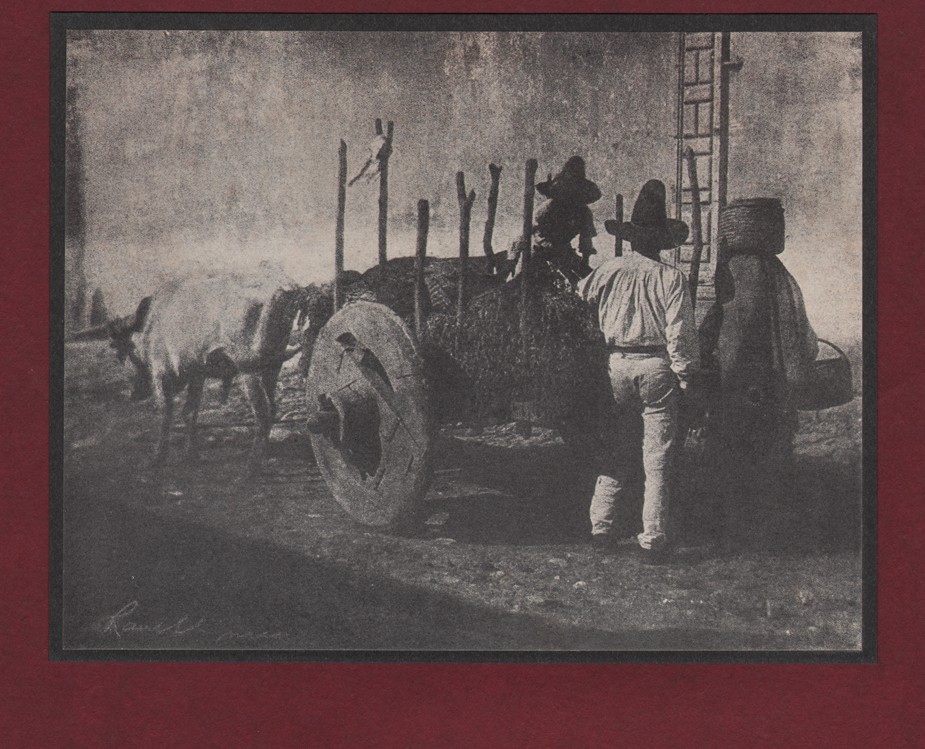 “An Ox Cart” (Mexico): Henry Ravell, American: 1864-1930. 1905: Vintage halftone tipped to mount: 16.6 x 21.4 | 17.4 x 22.2 | 45.0 x 30.5 cm “This mount is Sultan Bokhara and Royal Melton Egyptine Made by the Niagara Paper Mills”. Taken in Mexico ca. 1900-05, this is one of the earliest published examples of a Ravell photograph to appear in the popular press. It was included in the luxury portfolio publication “Art in Photography” issued by the Photo Era Publishing Company of Boston. From: PhotoSeed Archive
“An Ox Cart” (Mexico): Henry Ravell, American: 1864-1930. 1905: Vintage halftone tipped to mount: 16.6 x 21.4 | 17.4 x 22.2 | 45.0 x 30.5 cm “This mount is Sultan Bokhara and Royal Melton Egyptine Made by the Niagara Paper Mills”. Taken in Mexico ca. 1900-05, this is one of the earliest published examples of a Ravell photograph to appear in the popular press. It was included in the luxury portfolio publication “Art in Photography” issued by the Photo Era Publishing Company of Boston. From: PhotoSeed Archive
Ravell continued to work in Mexico until about 1914, when it is believed he moved back to the Los Angeles area of California in order to escape the Civil War (Mexican Revolution) then engulfing the country. A short biography included in the 1978 volume Pictorial Photography in Britain 1900-1920 gives 1916 as a slightly later date, although it was likely he was traveling back and forth from Mexico to the U.S. several times during this tumultuous time:
“In 1916 an article entitled “Cathedrals of Mexico”, illustrated by his work, was published in Harper’s magazine. About this time he left Mexico, almost as a refugee. His studio in Cuernavaca was destroyed by rebels. He moved to California where he began to photograph near Carmel and settled at Santa Barbara.”
Now that this American born “refugee” was back in his home country for good, he immediately set out photographing the beauty of the southern California coastline, with an emphasis on capturing the numerous entanglements of old cypress trees set against the landscape and Pacific Ocean. Conveniently, and perhaps not coincidentally, Lockwood de Forest had moved permanently to Santa Barbara in 1915 after wintering in the area since 1902, with his professional connections to the world of art giving Henry and his work credibility and entrance to a larger audience. These included retrospective exhibitions of nearly 100 framed works of his Mexican and California subjects at major American institutions. These began in October, 1918 at the Pratt Institute Art Gallery in Brooklyn and continued into 1919 at the Albright Art Gallery in Buffalo, New York followed by shows the same year at the newly opened Cleveland Museum of Art and then at the Chicago Art Institute.
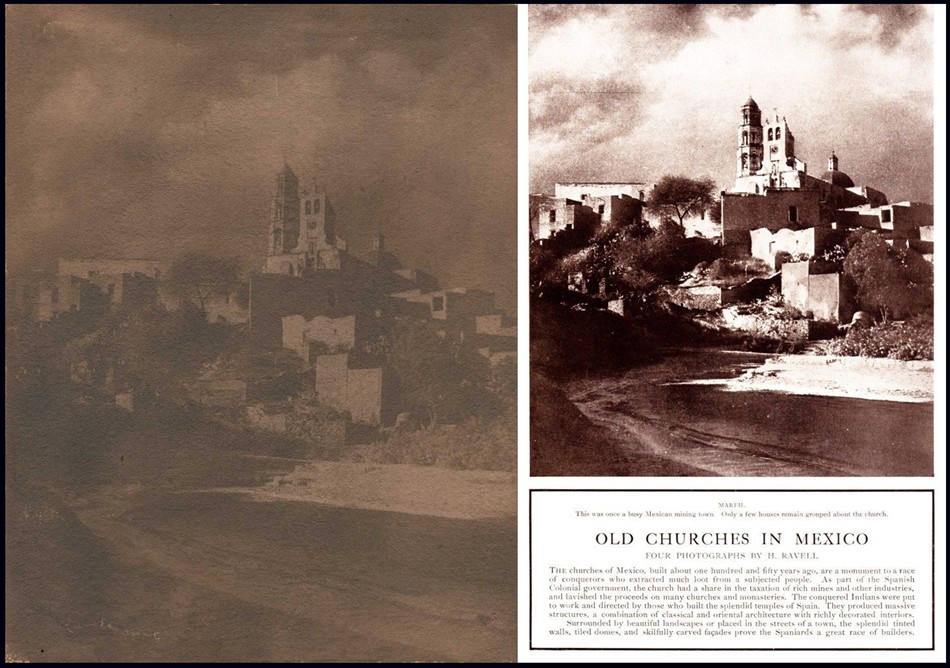 Left: “Marfil: Templo De Marfil De Arriba”: Henry Ravell, American: 1864-1930. Vintage gum print c. 1900-10: 37.4 x 29.0 cm. Still standing today, this church constructed in the Baroque style is located in Marfil, a suburb of the central Mexican city of Guanajuato. The church is colloquially known as “La Iglesia de Arriba”, or the “Church up Top”. From: PhotoSeed Archive Right: Four photographs of Mexican churches by Henry Ravell, including the Templo De Marfil De Arriba photograph, were published in the February, 1914 issue of Century Magazine for a picture spread titled “Old Churches in Mexico”: “The churches of Mexico, built about one hundred and fifty years ago, are a monument to a race of conquerors who extracted much loot from a subjected people. As part of the Spanish Colonial government, the church had a share in the taxation of rich mines and other industries, and lavished the proceeds on many churches and monasteries. The conquered Indians were put to work and directed by those who built the splendid temples of Spain. They produced massive structures, a combination of classical and oriental architecture with richly decorated interiors. Surrounded by beautiful landscapes or placed in the streets of a town, the splendid tinted walls, tiled domes, and skilfully carved facades prove the Spaniards a great race of builders.” From: Internet Archive
Left: “Marfil: Templo De Marfil De Arriba”: Henry Ravell, American: 1864-1930. Vintage gum print c. 1900-10: 37.4 x 29.0 cm. Still standing today, this church constructed in the Baroque style is located in Marfil, a suburb of the central Mexican city of Guanajuato. The church is colloquially known as “La Iglesia de Arriba”, or the “Church up Top”. From: PhotoSeed Archive Right: Four photographs of Mexican churches by Henry Ravell, including the Templo De Marfil De Arriba photograph, were published in the February, 1914 issue of Century Magazine for a picture spread titled “Old Churches in Mexico”: “The churches of Mexico, built about one hundred and fifty years ago, are a monument to a race of conquerors who extracted much loot from a subjected people. As part of the Spanish Colonial government, the church had a share in the taxation of rich mines and other industries, and lavished the proceeds on many churches and monasteries. The conquered Indians were put to work and directed by those who built the splendid temples of Spain. They produced massive structures, a combination of classical and oriental architecture with richly decorated interiors. Surrounded by beautiful landscapes or placed in the streets of a town, the splendid tinted walls, tiled domes, and skilfully carved facades prove the Spaniards a great race of builders.” From: Internet Archive
Henry Ravell would continue to exhibit his work late into the 1920’s at smaller venues, one example being a tri-colored gum print titled “Mexican Peon Boy” shown at the 1927 Los Angeles Salon and remarked on by Camera Craft, his gum prints deemed “for which he has gained a warranted renown”. Gum printing was indeed so important to the artist that he listed “Gum Printer” as his occupation for the 1920 U.S. Census.
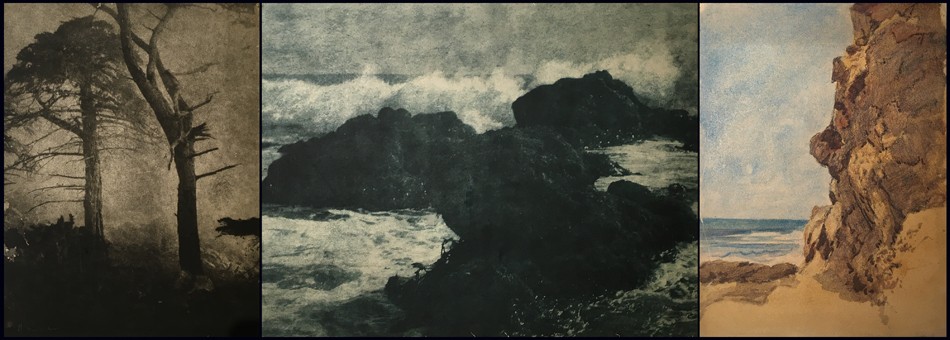 Left: “Pine and Cypress, Pebble Beach”: Henry Ravell, American: 1864-1930. Vintage gum print ca. 1915-20. (Museum of Wayne County History accession #Pi 176a with verso sticker additionally listing number 17 and $3.00) Middle: “Big Splash” (California coastline) Henry Ravell, American: 1864-1930. Vintage gum print ca. 1915-20. (Museum of Wayne County History accession #Pi 176m with verso sticker additionally listing number 122 and $12.00) Right: “Untitled Marine Landscape” (Mexico or California): Henry Ravell, American: 1864-1930. Vintage multiple colored gum print ca. 1907-1920. (Museum of Wayne County History accession #Pi 176n with verso sticker additionally listing number 156 ) All: Courtesy Museum of Wayne County History, Lyons N.Y.
Left: “Pine and Cypress, Pebble Beach”: Henry Ravell, American: 1864-1930. Vintage gum print ca. 1915-20. (Museum of Wayne County History accession #Pi 176a with verso sticker additionally listing number 17 and $3.00) Middle: “Big Splash” (California coastline) Henry Ravell, American: 1864-1930. Vintage gum print ca. 1915-20. (Museum of Wayne County History accession #Pi 176m with verso sticker additionally listing number 122 and $12.00) Right: “Untitled Marine Landscape” (Mexico or California): Henry Ravell, American: 1864-1930. Vintage multiple colored gum print ca. 1907-1920. (Museum of Wayne County History accession #Pi 176n with verso sticker additionally listing number 156 ) All: Courtesy Museum of Wayne County History, Lyons N.Y.
The Albright Art Gallery was an important venue for Ravell’s work, considering the groundbreaking exhibition it previously hosted in November, 1910: the International Exhibition of Pictorial Photography. Organized by the Photo-Secession under the direction of Alfred Stieglitz, it was “the first exhibition held at an American museum that aimed to elevate photography’s stature from a purely scientific pursuit to a visual form of artistic expression.” Even nine years later, in 1919, at a time when museum shows devoted to the work of a singular photographer anywhere in the world were still few and far between and remained so decades later, it’s refreshing in the present to read observations by one curator remarking on Ravell’s 93 framed photographs displayed at the Albright gallery for Academy Notes, the mouthpiece for The Buffalo Fine Arts Academy:
“THE collection of photographs by H. Ravell—which was on view in the gallery during the last week in February and all of March—is very unique and valuable. These photographs are technically known as gum-prints and have all the painter’s quality in their execution. They do not impress one as photographs but rather as work directly from the artist’s brush. The photographs were made by H. Ravell who is now in Santa Barbara. Many of the pictures were taken near Carmel, California, a seashore of much variety where the fantastic cypress trees with their twisted dramatic forms produce wonderful compositions against sea and sky.” …This is but a short description of the remarkable exhibition of photographs shown at the Albright Art Gallery. It was seen by many art lovers and appreciated especially by all of those interested in artistic photography.” (4.)
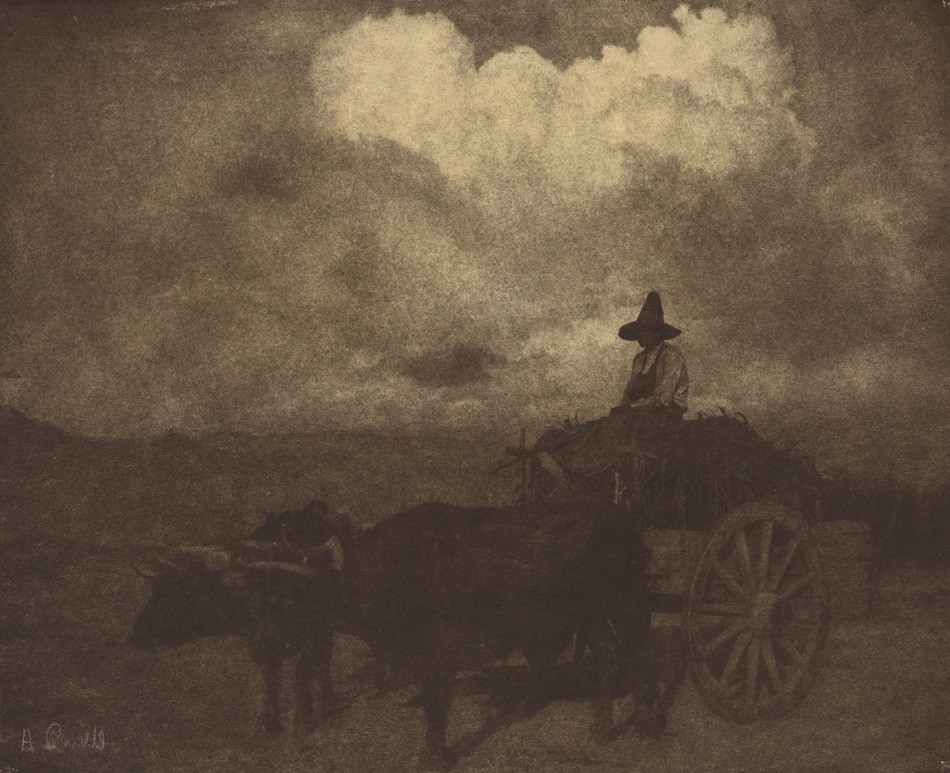 “Ox Cart- Sunset”: Henry Ravell, American: 1864-1930. Vintage gum print ca. 1900-10. Image: 27.0 x 32.6 cm presented loose within dark brown paper folder with overall support dimensions of 58.8 x 36.7 cm. Wearing a traditional sombrero hat, (Sombrero de charro) the driver of this ox or bullock cart pauses atop a full load of what looks like hay or silage. This Mexican scene may date to around 1905-consistent with a different view by the artist of an ox cart published that year in “Art in Photography” by the the Photo Era Publishing Company of Boston. From: PhotoSeed Archive
“Ox Cart- Sunset”: Henry Ravell, American: 1864-1930. Vintage gum print ca. 1900-10. Image: 27.0 x 32.6 cm presented loose within dark brown paper folder with overall support dimensions of 58.8 x 36.7 cm. Wearing a traditional sombrero hat, (Sombrero de charro) the driver of this ox or bullock cart pauses atop a full load of what looks like hay or silage. This Mexican scene may date to around 1905-consistent with a different view by the artist of an ox cart published that year in “Art in Photography” by the the Photo Era Publishing Company of Boston. From: PhotoSeed Archive
A reevaluation of Henry Ravell’s body of work is important to consider in the present given the broad acknowledgement of his talent by major institutions and the popular press for the benefit of many large audiences over 100 years ago. An important pictorialist photographer who was also a painter, Henry Ravell was a striver and apprentice graduate inspired by his father’s steady trade in the New York state village of Lyons who embraced a love for craft and mastery of art. Together, these skills gave him the passion to embrace adventure in capturing the beauty in far-off Mexico and southern California for the ages.
Four original gum prints in the PhotoSeed Archive can be seen here, each listing an expanded biography, timeline and major institutional holdings for the artist.
Afterword | Notes
A conundrum on internet research into Henry Ravell’s artistic output reveals itself quickly. The bottom line is that most every painting on the web attributed to Henry Ravell the photographer is not by him. Instead, through PhotoSeed’s research and purchase of the small painting: “The Ripers”, (The Reapers) the true identity of this artist can now be revealed as Henry Etienne Ravel. (1872-1962) Born in Naples Italy to French citizens, Henry Ravel immigrated to America in 1906 and became a naturalized US citizen in 1920. A transportation clerk by trade in the early 1920’s, his paintings- many done in Europe- date from ca. 1930’s-1950’s. What causes the confusion is that like Henry Ravell the photographer, who signed his photographs “H. Ravell”, Henry Ravel the painter also signed his work similarly, but as “H. Ravel” Numerous examples of his paintings show up on Google searches-unlike the real and quite rare examples of watercolors done by Ravell the photographer. I’ve included links to some of these paintings on the page showing “The Ripers”. As always- buyer beware and do your homework!
1. C. Ravel won a $3.00 premium for “Best Daguerreotypes” during the Annual Fair of the Madison County Agricultural Society held at Morrisville, (N.Y.) on the 15th, 16th and 17th days of September,1857 according to a newspaper account in the Cazenovia Republican. Shout out to the Pioneer American Photographers 1839-1860 website. Langdon’s List of 19th & Early 20th Century Photographers additionally list Ravel working in Manlius, New York in the 1859 N.Y. State Business Directory.
2. See: The Lyons Republican & Clyde Times: Lyons, N.Y. Thursday, March 21, 1940. Article excerpts: HENRY RAVELL: “Resided in Lyons for twenty-eight years, died in Los Angeles California, January 20, 1930. This account was written by his sister, Mrs. Florence Ravell Lothrop, of 721 Fifth Street North, St. Petersburg, Florida.: “Henry had no special training in any school or under any masters except my father, Charles Herring Ravel, who was born in Boston, England, and became one of the first photographers in the United States. His forbears came over with William the Conqueror to England, which accounts for the one “L” in the name. My mother was annoyed because most people called her Mrs. Rav’-el and persuaded my father to add “L”, so the family adopted that spelling of our name.…Henry studied and experimented all his life. His photographic subjects were portraits, landscapes, street scenes, trees, cloud and moonlight effects. His Mexican Cathedrals were especially noteworthy. He used both oils and water colors, but his favorite work was photography, and the gum print process. This process was original with an Austrian who refused to make it known, but Henry experimented until he developed it, and later gave the formula to the world. I remember seeing around his studio, pans of water about three inches deep. The photo-print was put into the water and pigments of paint dropped on it, this gave the effect when completed of a soft beautiful painting. My description to an artist will seem crude but that is as I recall it.…Henry never taught, that is, acted as a teacher in any school, and I do not know what societies he belonged. He exhibited in the Pittsburgh, Pennsylvania, Salon about 1907. From the thousands of photographs submitted, three of his were among the 237 accepted. His work was exhibited at the Salmagundi Club, New York City; Thurber’s and Anderson’s Galleries in Chicago, Los Angeles, California, and many, many other places. Fifteen of his photographs are at the Metropolitan Museum, New York City. Seven are Mexican subjects and eight are California trees. These were selected by Forest Lockwood.(sic) After Henry’s death at Los Angeles, California, in 1930, a request came for him to send an exhibit to the Fifth International Photographic Salon of Japan held at Tokyo and Osaka in May, 1931.”
3. In the December, 1908 issue of Boston’s Photo-Era, a short article titled “Gum-Prints In Colors” appeared, linking Ravell’s gum prints as being similar to “a collection of prints by the same process, probably with modifications” to work done by the Hofmeister brothers and Müller. These German works were shown at the offices of The British Journal of Photography in London’s Strand from September 28- October 24, 1907.
4. See: Academy Notes: The Buffalo Fine Arts Academy: Albright Art Gallery: Buffalo, New York: vol. XIV: Jan.-Oct. 1919, p. 67
Heaven on Earth
Posted July 2020 in New Additions, Significant Photographers, Significant Photographs
America’s birthday is best defined by the natural beauty of her National Parks, undisturbed by man’s folly.
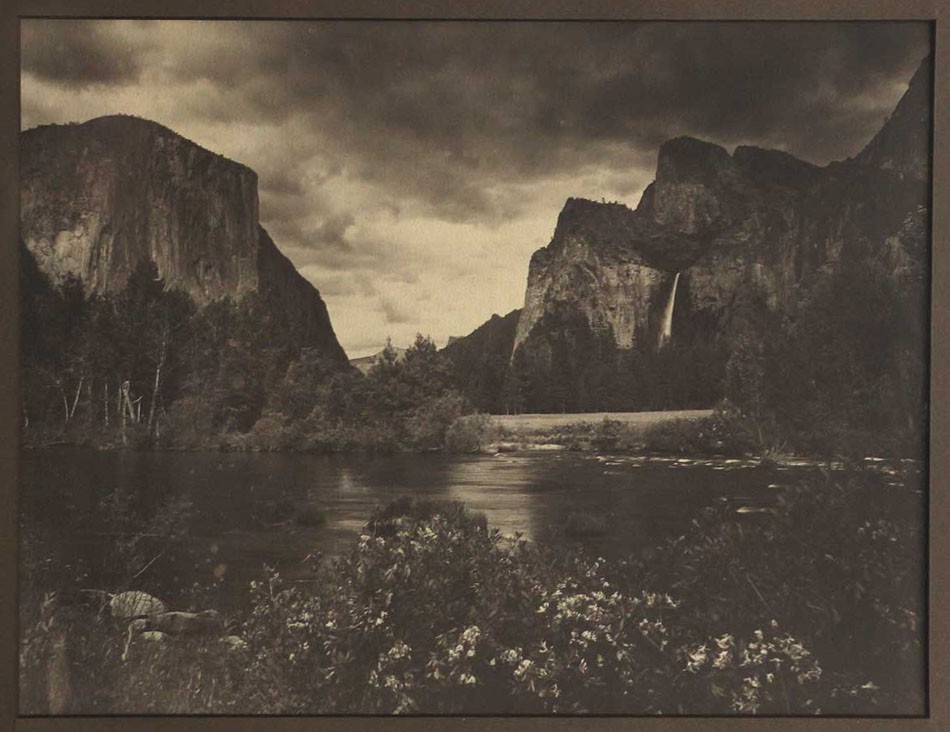 “The Gates of Yosemite”: Arthur C. Pillsbury, American: 1870-1946. Vintage bromide print c. 1915-20 (from original negative c. 1906-10) Image: 26.4 x 34.1 | 27.2 x 35.0 cm. Support: original framing: 37.9 x 45.8 hardboard primary mount | frame: stained hardwood: 40.7 x 48.5 x 1.5 cm. From the 1914 volume Yosemite and its High Sierra by John H. Williams, the following passage is reproduced along with this photograph “The Gates of Yosemite”: “Soon, quitting the narrow, cluttered wildness of the lower river, the newcomer is face to face with the ordered peace and glory of Yosemite itself. Gratefully, silently, he breathes the very magic of the Enchanted Valley. For here, fully spread before him, is that combination of sylvan charm with stupendous natural phenomena which makes Yosemite unique among Earth’s great pictures. He sees the cañon’s level floor, telling of an ancient glacial lake that has given place to wide, grassy meadows; fields of glad mountain flowers; forests of many greens and lavenders; the fascination of the winding Merced, and, gleaming high above this world of gentle loveliness, the amazing gray face of El Capitan, while Pohono drops from a ‘hanging valley’ superbly sculptured, and so beautiful that he may well deem it the noblest setting Nature has given to any of her famous waterfalls.” From: PhotoSeed Archive
“The Gates of Yosemite”: Arthur C. Pillsbury, American: 1870-1946. Vintage bromide print c. 1915-20 (from original negative c. 1906-10) Image: 26.4 x 34.1 | 27.2 x 35.0 cm. Support: original framing: 37.9 x 45.8 hardboard primary mount | frame: stained hardwood: 40.7 x 48.5 x 1.5 cm. From the 1914 volume Yosemite and its High Sierra by John H. Williams, the following passage is reproduced along with this photograph “The Gates of Yosemite”: “Soon, quitting the narrow, cluttered wildness of the lower river, the newcomer is face to face with the ordered peace and glory of Yosemite itself. Gratefully, silently, he breathes the very magic of the Enchanted Valley. For here, fully spread before him, is that combination of sylvan charm with stupendous natural phenomena which makes Yosemite unique among Earth’s great pictures. He sees the cañon’s level floor, telling of an ancient glacial lake that has given place to wide, grassy meadows; fields of glad mountain flowers; forests of many greens and lavenders; the fascination of the winding Merced, and, gleaming high above this world of gentle loveliness, the amazing gray face of El Capitan, while Pohono drops from a ‘hanging valley’ superbly sculptured, and so beautiful that he may well deem it the noblest setting Nature has given to any of her famous waterfalls.” From: PhotoSeed Archive
I am America
Posted June 2020 in Significant Photographers, Significant Photographs, Sports Photography
“I am America. I am the part you won’t recognize. But get used to me—black, confident, cocky; my name, not yours; my religion, not yours; my goals, my own. Get used to me.” ― Muhammad Ali
Remember his name: George Floyd
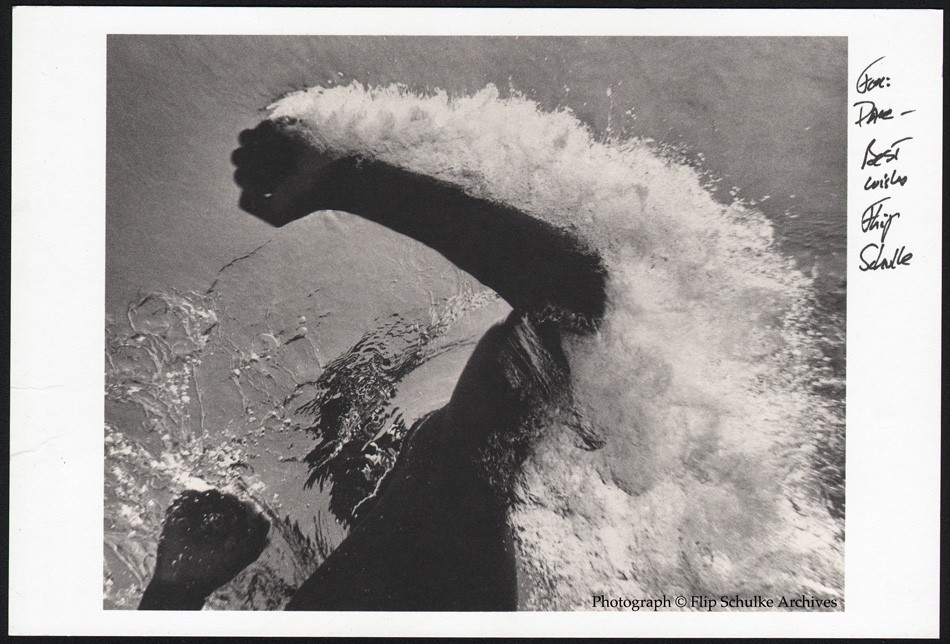 “Left Hook” (Muhammad Ali training underwater): Graeme Phelps "Flip" Schulke, American: 1930-2008: Fine Halftone ca. 1994 on manilla cardstock from original 1961 copy or source negative or print: 14.6 x 21.6 cm. (overall) Used here as a promotional gallery card for the New York City based James Danziger show: “Sport Stories: Sports photographs from 1900 to today”- February 18 - March 12, 1994. “Left Hook” was one of a series of photographs of boxer Muhammad Ali (then known as Cassius Clay) training underwater taken by American photojournalist Flip Schulke in the swimming pool of Miami’s Sir John Hotel in August, 1961. The photograph was first published of the then 19 year-old fighter in the September 8, 1961 weekly issue of Life magazine as part of a two-page spread titled “A Wet Way to Train for a Fight”. Schulke, an accomplished underwater photographer, donned Scuba gear and an underwater camera to make these photographs, learning three years later to his delight that Ali did not know how to swim at the time: “Boy, to con Life magazine! I never had an inkling that I had been taken. …To me, it shows his genius.” the photographer said for his volume “Muhammad Ali: the Birth of a Legend, Miami, 1961-1964” published in 2000. Photograph © Flip Schulke Archives. Gallery card from collection of PhotoSeed site owner signed by Schulke in 1999.
“Left Hook” (Muhammad Ali training underwater): Graeme Phelps "Flip" Schulke, American: 1930-2008: Fine Halftone ca. 1994 on manilla cardstock from original 1961 copy or source negative or print: 14.6 x 21.6 cm. (overall) Used here as a promotional gallery card for the New York City based James Danziger show: “Sport Stories: Sports photographs from 1900 to today”- February 18 - March 12, 1994. “Left Hook” was one of a series of photographs of boxer Muhammad Ali (then known as Cassius Clay) training underwater taken by American photojournalist Flip Schulke in the swimming pool of Miami’s Sir John Hotel in August, 1961. The photograph was first published of the then 19 year-old fighter in the September 8, 1961 weekly issue of Life magazine as part of a two-page spread titled “A Wet Way to Train for a Fight”. Schulke, an accomplished underwater photographer, donned Scuba gear and an underwater camera to make these photographs, learning three years later to his delight that Ali did not know how to swim at the time: “Boy, to con Life magazine! I never had an inkling that I had been taken. …To me, it shows his genius.” the photographer said for his volume “Muhammad Ali: the Birth of a Legend, Miami, 1961-1964” published in 2000. Photograph © Flip Schulke Archives. Gallery card from collection of PhotoSeed site owner signed by Schulke in 1999.
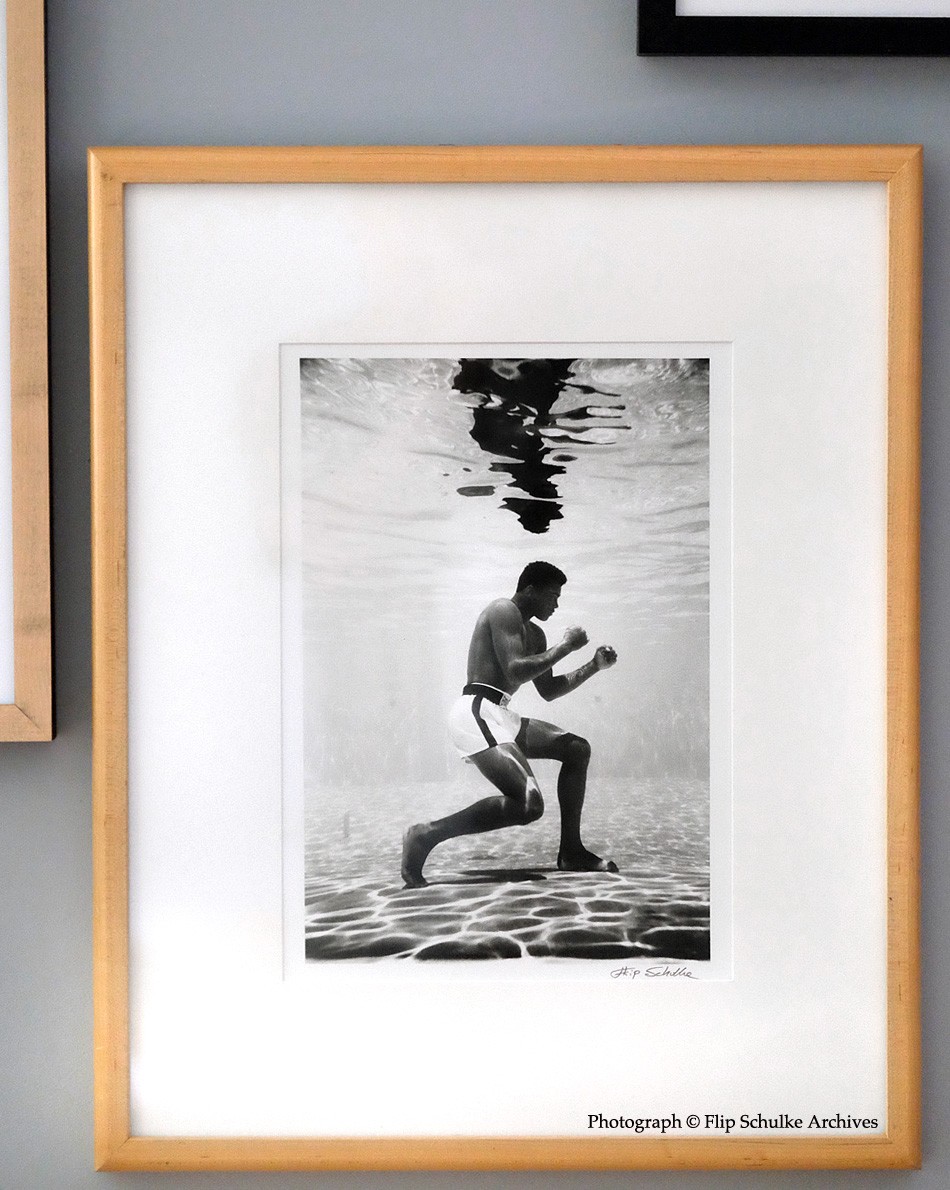 “Ali Underwater”: Graeme Phelps "Flip" Schulke, American: 1930-2008: Gelatin Silver print ca. 1999 from original 1961 source negative: 31.5 x 21.1 | 35.2 x 27.9 cm. Flip Schulke’s iconic photograph of boxer Muhammad Ali holding his breath while assuming a traditional boxing stance was one of a series of the world champion (then known as Cassius Clay) training underwater in the swimming pool of Miami’s Sir John Hotel in August, 1961. “For the picture of him standing on the bottom of the pool, he just sank down and stood on the bottom. It’s hard to do. I didn’t ask him to do it, I didn’t put any weights on him or anything. He exhaled all of his air-that’s the only way you can sink down.” the photographer said for his volume “Muhammad Ali: the Birth of a Legend, Miami, 1961-1964” published in 2000. Flip Schulke was a close friend of American Civil Rights icon Dr. Martin Luther King Jr. , and he spent more than a decade covering the movement for national magazines including Life, Time and Newsweek. These photographs were featured in three volumes by him: "Martin Luther King, Jr.: A Documentary, Montgomery to Memphis" (1976); "King Remembered" (1986); and "He Had A Dream" (1995). Other volumes by the photographer include "Underwater Photography for Everyone" (1979); "Your Future in Space: The U.S. Space Camp Training Program" (1986); "Muhammad Ali: the Birth of a Legend, Miami, 1961-1964" (2000); and "Witness to Our Times: My Life as a Photojournalist" (2003). Photograph © Flip Schulke Archives. Framed photograph from PhotoSeed Archive.
“Ali Underwater”: Graeme Phelps "Flip" Schulke, American: 1930-2008: Gelatin Silver print ca. 1999 from original 1961 source negative: 31.5 x 21.1 | 35.2 x 27.9 cm. Flip Schulke’s iconic photograph of boxer Muhammad Ali holding his breath while assuming a traditional boxing stance was one of a series of the world champion (then known as Cassius Clay) training underwater in the swimming pool of Miami’s Sir John Hotel in August, 1961. “For the picture of him standing on the bottom of the pool, he just sank down and stood on the bottom. It’s hard to do. I didn’t ask him to do it, I didn’t put any weights on him or anything. He exhaled all of his air-that’s the only way you can sink down.” the photographer said for his volume “Muhammad Ali: the Birth of a Legend, Miami, 1961-1964” published in 2000. Flip Schulke was a close friend of American Civil Rights icon Dr. Martin Luther King Jr. , and he spent more than a decade covering the movement for national magazines including Life, Time and Newsweek. These photographs were featured in three volumes by him: "Martin Luther King, Jr.: A Documentary, Montgomery to Memphis" (1976); "King Remembered" (1986); and "He Had A Dream" (1995). Other volumes by the photographer include "Underwater Photography for Everyone" (1979); "Your Future in Space: The U.S. Space Camp Training Program" (1986); "Muhammad Ali: the Birth of a Legend, Miami, 1961-1964" (2000); and "Witness to Our Times: My Life as a Photojournalist" (2003). Photograph © Flip Schulke Archives. Framed photograph from PhotoSeed Archive.Earth Bowl
Posted April 2020 in Color Photography, New Additions
If for a moment we could look down and imagine our Earth fitting within a fish bowl, could we then realize the importance our fragile world depends on us all in feeding and caring for its’ survival? Please try. Today, join us in celebrating 50 years of Earth Day.
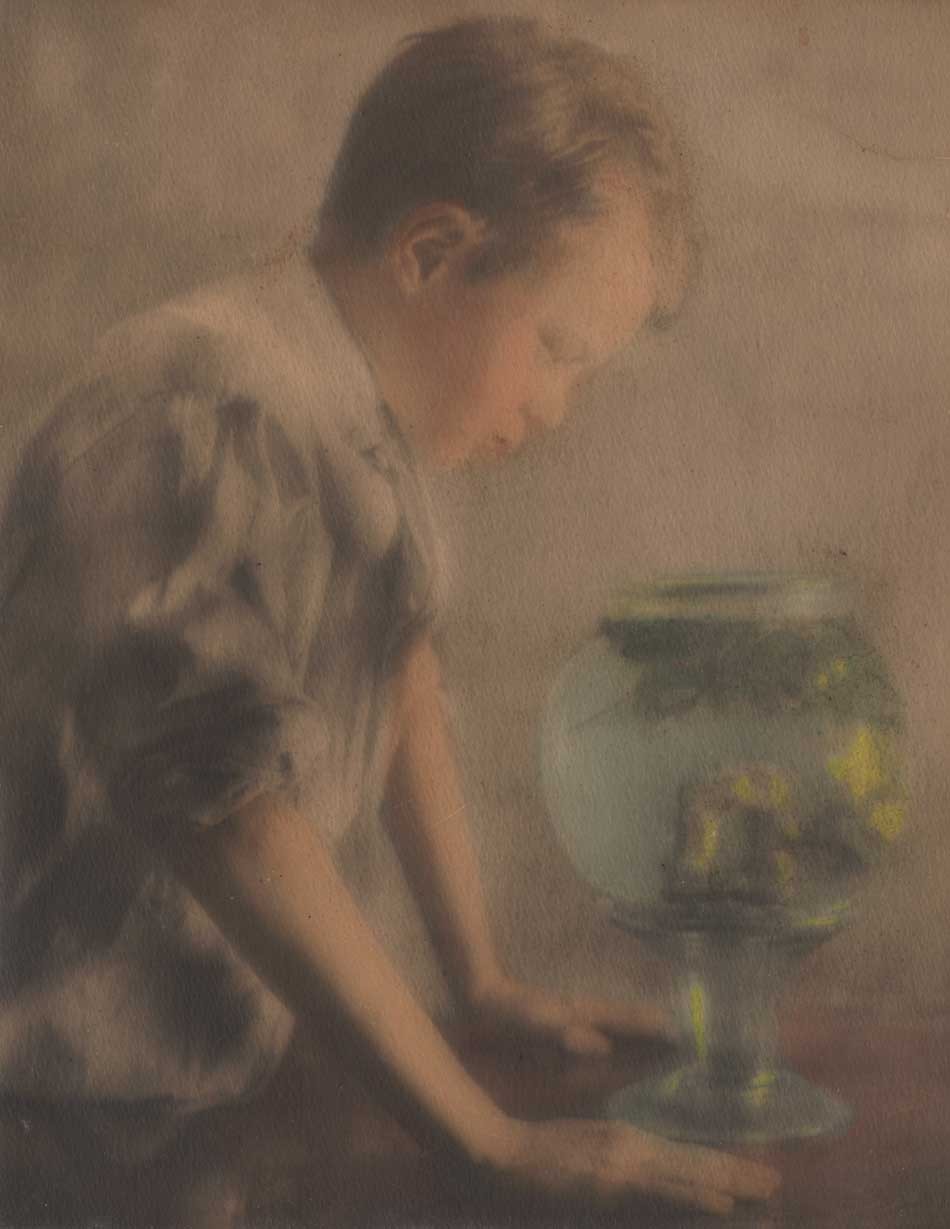 “Child Gazing in Fish Bowl”: attributed to Arthur Hammond, American: born England: 1880-1962: hand-colored gelatin silver print mounted to album leaf, ca. 1910-1920: 23.8 x 18.5 | 25.0 x 32.7 cm. From a personal album of nearly 100 photographs attributed to Hammond dating from around 1910-1940. Born in London, Hammond arrived in America at Ellis Island on July 31, 1909 and quickly established his own studio in Natick Massachusetts by 1912-joining and exhibiting with the nearby Boston Camera Club. By 1920, he had authored the foundational book "Pictorial Composition in Photography" and became a leading voice for pictorialism in America through his position as associate editor of American Photography magazine that lasted 30 years from 1918-1949. From: PhotoSeed Archive
“Child Gazing in Fish Bowl”: attributed to Arthur Hammond, American: born England: 1880-1962: hand-colored gelatin silver print mounted to album leaf, ca. 1910-1920: 23.8 x 18.5 | 25.0 x 32.7 cm. From a personal album of nearly 100 photographs attributed to Hammond dating from around 1910-1940. Born in London, Hammond arrived in America at Ellis Island on July 31, 1909 and quickly established his own studio in Natick Massachusetts by 1912-joining and exhibiting with the nearby Boston Camera Club. By 1920, he had authored the foundational book "Pictorial Composition in Photography" and became a leading voice for pictorialism in America through his position as associate editor of American Photography magazine that lasted 30 years from 1918-1949. From: PhotoSeed ArchiveOld New York Strong
Posted April 2020 in Documentary Photography, New Additions, Significant Photographers, Unknown Photographers
As New York City takes center stage for the role of viral epicenter it did not ask for, it has revealed a longstanding tenacity of spirit and resilience baked in- her very landmarks, monuments and memorials infused with the history of the shared past now standing silently yet propelling it ever forward. Combined with those higher graces of social inclusion and togetherness representing an ideal for American Democracy, these places and symbols will continue to forge and unite the connections between cultures, commerce and diasporas for the common good- in the days ahead and for the future. -David Spencer
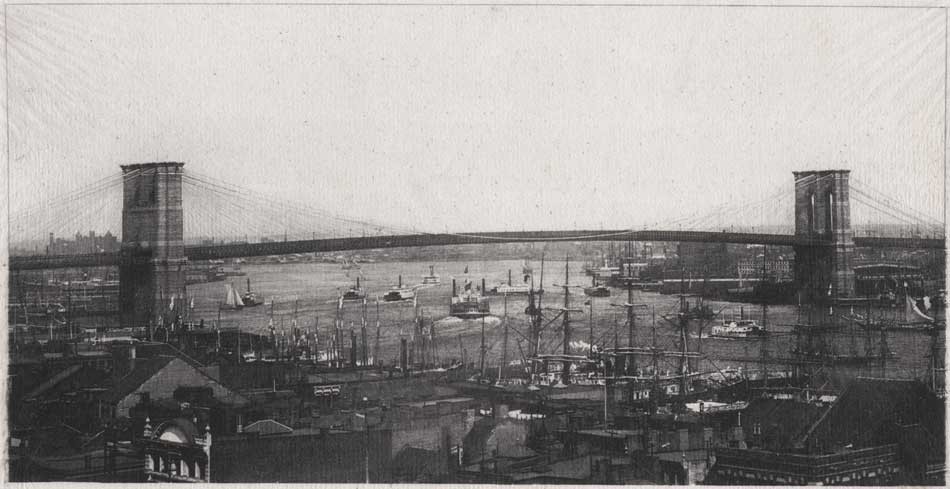 “Brooklyn Bridge”: Adolph A. Wittemann, American (1845-1938). Vintage Japan-tissue photogravure: 1889: printed ca. 1897-1900: Photogravure and Color Co. (New York): 8.8 x 17.1 | 12.6 x 19.7 cm | supports: 20.6 x 28.0 | 22.2 x 29.1 cm. Ferries and other marine craft navigate the East River in this pictorial view emphasizing the span of the famous bridge by Wittemann. Conversely, in a gelatin silver variant held by the Museum of the City of New York: “Looking over New York toward the Brooklyn Bridge”, (x2010.11.3891) the foreground frame shows a greater concentration of buildings and less river activity. In 1890,The Getty Research Institute’s Art & Architecture Thesaurus notes, Adolph Wittemann and his brother Herman would found The Albertype Company, a Brooklyn-based publisher employing the collotype (or albertype) photographic process. “The company operated from 1890 to 1952 and produced over 25,000 prints. The Albertype Company both produced their own photographs (Adolph was a photographer), as well as reproduced photographic images produced by other companies or individual photographers. Using the prints, the company published postcards and viewbooks. Viewbooks, also known as souvenir albums or view albums, are books that contain commercially published groups of photographs depicting a place, activity, or event.” From: PhotoSeed Archive
“Brooklyn Bridge”: Adolph A. Wittemann, American (1845-1938). Vintage Japan-tissue photogravure: 1889: printed ca. 1897-1900: Photogravure and Color Co. (New York): 8.8 x 17.1 | 12.6 x 19.7 cm | supports: 20.6 x 28.0 | 22.2 x 29.1 cm. Ferries and other marine craft navigate the East River in this pictorial view emphasizing the span of the famous bridge by Wittemann. Conversely, in a gelatin silver variant held by the Museum of the City of New York: “Looking over New York toward the Brooklyn Bridge”, (x2010.11.3891) the foreground frame shows a greater concentration of buildings and less river activity. In 1890,The Getty Research Institute’s Art & Architecture Thesaurus notes, Adolph Wittemann and his brother Herman would found The Albertype Company, a Brooklyn-based publisher employing the collotype (or albertype) photographic process. “The company operated from 1890 to 1952 and produced over 25,000 prints. The Albertype Company both produced their own photographs (Adolph was a photographer), as well as reproduced photographic images produced by other companies or individual photographers. Using the prints, the company published postcards and viewbooks. Viewbooks, also known as souvenir albums or view albums, are books that contain commercially published groups of photographs depicting a place, activity, or event.” From: PhotoSeed Archive
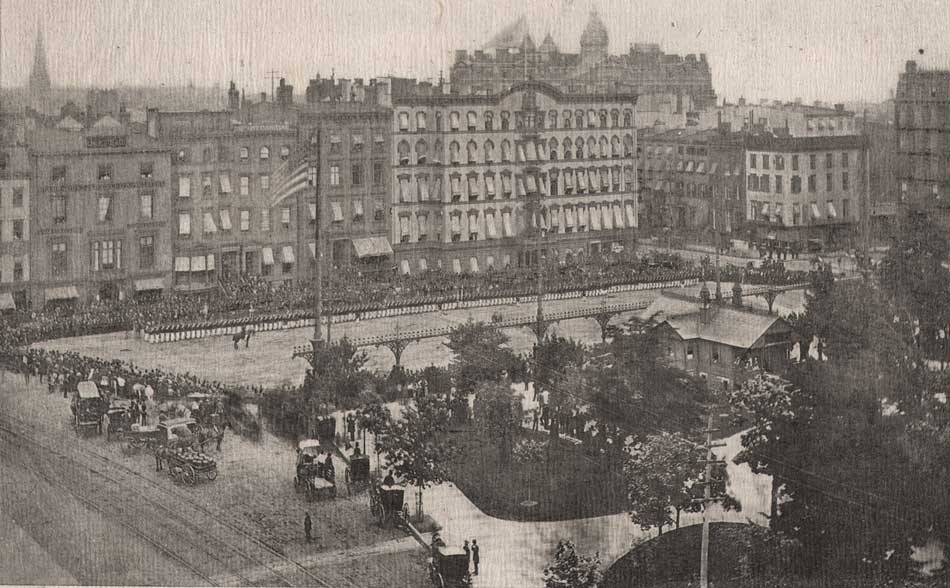 Detail: “Union Square”: unknown American photographer. Vintage Japan-tissue photogravure: ca. 1880-1900: printed ca. 1897-1900: Photogravure and Color Co. (New York): 10.8 x 16.4 | 14.5 x 18.8 cm | supports: 19.1 x 24.5 | 22.2 x 29.1 cm. Soldiers, possibly Cadets from the U.S. Military Academy at West Point, assemble in parade formation (Washington’s Birthday?) two abreast on the north side of Union Square in New York City. Everett House, a fine residential hotel that opened in 1853 at background center of photograph can be seen, and other clues might help a modern viewer more accurately date this view. They include an American flag flying at center, horse-drawn carriages at foreground left, a telegraph pole at foreground right and intact signs (upon close-magnification) on the building at far background left, directly behind the head of the line of soldiers. Located at 29 East 17th Street, it was the warehouse and shop for L. Marcotte & Co., a manufacturer and importer of fine carpets, furniture, and “looking glass plates, frames, gas fixtures, bronzes, and all articles of art”, according to an 1876 sales invoice, and is believed to have been at this location as early as 1860. From: PhotoSeed Archive
Detail: “Union Square”: unknown American photographer. Vintage Japan-tissue photogravure: ca. 1880-1900: printed ca. 1897-1900: Photogravure and Color Co. (New York): 10.8 x 16.4 | 14.5 x 18.8 cm | supports: 19.1 x 24.5 | 22.2 x 29.1 cm. Soldiers, possibly Cadets from the U.S. Military Academy at West Point, assemble in parade formation (Washington’s Birthday?) two abreast on the north side of Union Square in New York City. Everett House, a fine residential hotel that opened in 1853 at background center of photograph can be seen, and other clues might help a modern viewer more accurately date this view. They include an American flag flying at center, horse-drawn carriages at foreground left, a telegraph pole at foreground right and intact signs (upon close-magnification) on the building at far background left, directly behind the head of the line of soldiers. Located at 29 East 17th Street, it was the warehouse and shop for L. Marcotte & Co., a manufacturer and importer of fine carpets, furniture, and “looking glass plates, frames, gas fixtures, bronzes, and all articles of art”, according to an 1876 sales invoice, and is believed to have been at this location as early as 1860. From: PhotoSeed Archive
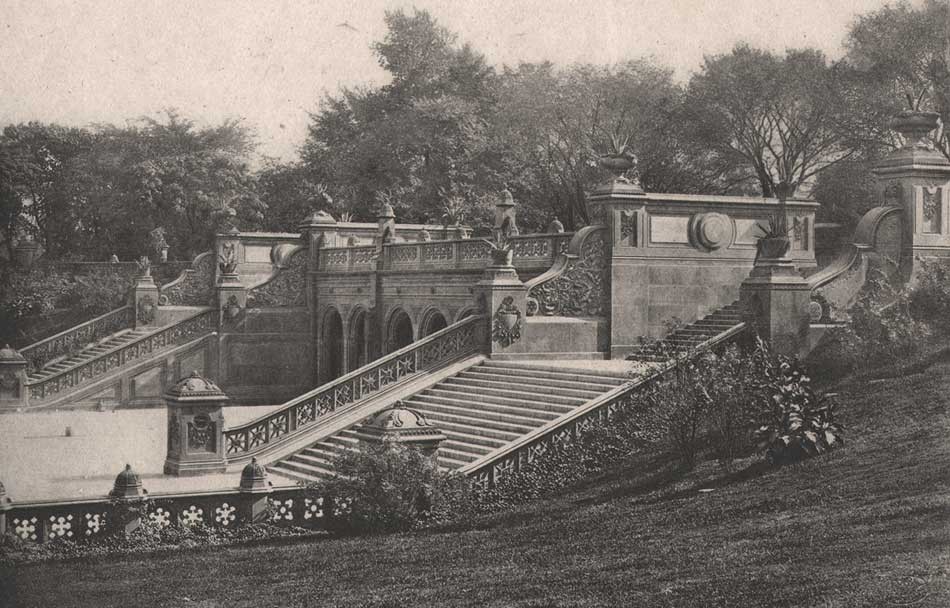 “Central Park” (Bethesda Terrace Steps): unknown American photographer. Vintage Japan-tissue photogravure: ca. 1885-1888: printed ca. 1897-1900: Photogravure and Color Co. (New York): 11.2 x 16.5 | 14.7 x 19.3 cm | supports: 19.8 x 25.3 | 22.2 x 29.1 cm. The Central Park Conservancy considers Bethesda Terrace- “the heart of Central Park and is, by design, its singular formal feature. Overlooking the Lake, it stands at the end of the Park’s long, tree-lined promenade known as the Mall. A grand staircase descends into the subterranean Arcade, which offers a welcome respite from rain and heat.” Shown in this photograph are the two flanking grand staircases for the terrace, designed by park architects Calvert Vaux with sculptural details by Jacob Wrey Mould. Although American commercial photographer John S. Johnston (c.1839-1899) was known to have documented features in Central Park in 1893-94, albeit with people in his views, this photograph, titled “Central Park-The Terrace and Grand Stairway”, first appeared in 1888 in the volume The Empire State: Its Industries and Wealth. (p.45) Later, it was included as part of a series of four architectural studies of Central Park bridges in the 1896 volume The Engineering Magazine, Vol. 11. (“The Terrace”: p. 863) The work was further published as “Terrace Steps, Central Park”- an offset color lithograph print souvenir inserted within the pages of The New York Recorder newspaper between 1891-96: see New York Public Library catalog ID (B-number): b17094307. From: PhotoSeed Archive
“Central Park” (Bethesda Terrace Steps): unknown American photographer. Vintage Japan-tissue photogravure: ca. 1885-1888: printed ca. 1897-1900: Photogravure and Color Co. (New York): 11.2 x 16.5 | 14.7 x 19.3 cm | supports: 19.8 x 25.3 | 22.2 x 29.1 cm. The Central Park Conservancy considers Bethesda Terrace- “the heart of Central Park and is, by design, its singular formal feature. Overlooking the Lake, it stands at the end of the Park’s long, tree-lined promenade known as the Mall. A grand staircase descends into the subterranean Arcade, which offers a welcome respite from rain and heat.” Shown in this photograph are the two flanking grand staircases for the terrace, designed by park architects Calvert Vaux with sculptural details by Jacob Wrey Mould. Although American commercial photographer John S. Johnston (c.1839-1899) was known to have documented features in Central Park in 1893-94, albeit with people in his views, this photograph, titled “Central Park-The Terrace and Grand Stairway”, first appeared in 1888 in the volume The Empire State: Its Industries and Wealth. (p.45) Later, it was included as part of a series of four architectural studies of Central Park bridges in the 1896 volume The Engineering Magazine, Vol. 11. (“The Terrace”: p. 863) The work was further published as “Terrace Steps, Central Park”- an offset color lithograph print souvenir inserted within the pages of The New York Recorder newspaper between 1891-96: see New York Public Library catalog ID (B-number): b17094307. From: PhotoSeed Archive
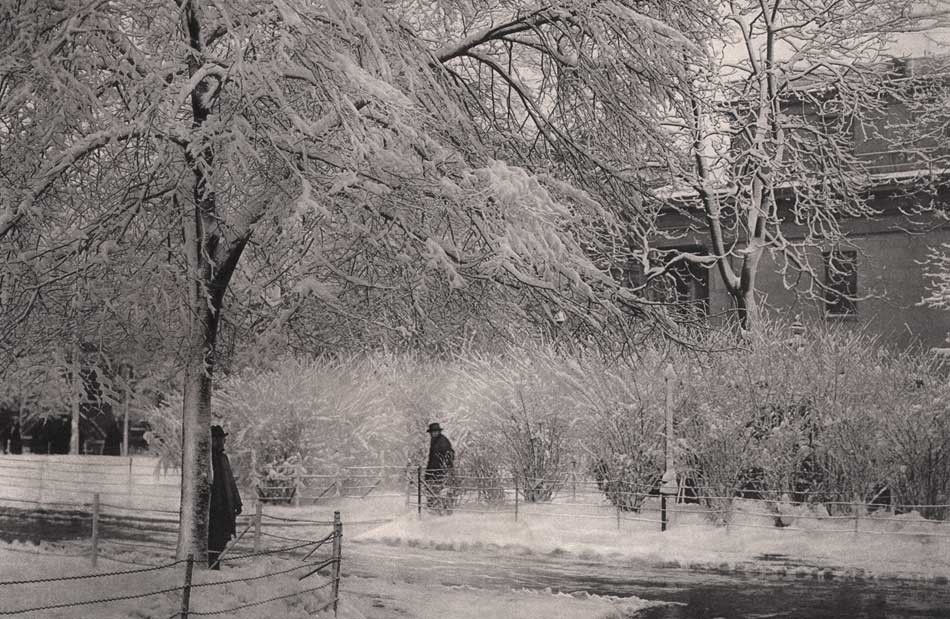 “City Hall Park, New York, March 2, 1896”: William H. Cooper, American. Vintage hand-pulled photogravure by the N.Y. Photogravure Co.: 18.0 x 22.9 | 27.6 x 34.8 cm. Plate issued with the March, 1896 Whole # 91 monthly issue of “Sun and Shade, An Artistic Periodical”. Snow from a late Winter storm coats trees and nearly everything else in New York City’s City Hall Park. From Wikipedia: “City Hall Park is a public park surrounding New York City Hall in the Civic Center of Manhattan. It was the town commons of the nascent city of New York… During the pre-Revolutionary and Revolutionary eras, City Hall Park was the site of many rallies and movements.” Photographer William H. Cooper was the President of the Department of Photography at the Brooklyn Institute of Arts and Science when this photograph was published. The editors of Sun and Shade commented on this work: “The present picture, taken it may be noted for technical readers, by a 2A Zeiss lens, is, without exception, one of the most remarkable productions, so far, which photography has produced. Every one who has seen the strange and peculiar aspect of leafless trees, when showered with fleecy snow, has longed to carry in his mind the memory of the pretty sight: but, until now, it is doubtful if such a weird aspect has ever been perpetuated; certainly not by the hand of a painter, for it would be far and away beyond any artist’s powers.” From: PhotoSeed Archive
“City Hall Park, New York, March 2, 1896”: William H. Cooper, American. Vintage hand-pulled photogravure by the N.Y. Photogravure Co.: 18.0 x 22.9 | 27.6 x 34.8 cm. Plate issued with the March, 1896 Whole # 91 monthly issue of “Sun and Shade, An Artistic Periodical”. Snow from a late Winter storm coats trees and nearly everything else in New York City’s City Hall Park. From Wikipedia: “City Hall Park is a public park surrounding New York City Hall in the Civic Center of Manhattan. It was the town commons of the nascent city of New York… During the pre-Revolutionary and Revolutionary eras, City Hall Park was the site of many rallies and movements.” Photographer William H. Cooper was the President of the Department of Photography at the Brooklyn Institute of Arts and Science when this photograph was published. The editors of Sun and Shade commented on this work: “The present picture, taken it may be noted for technical readers, by a 2A Zeiss lens, is, without exception, one of the most remarkable productions, so far, which photography has produced. Every one who has seen the strange and peculiar aspect of leafless trees, when showered with fleecy snow, has longed to carry in his mind the memory of the pretty sight: but, until now, it is doubtful if such a weird aspect has ever been perpetuated; certainly not by the hand of a painter, for it would be far and away beyond any artist’s powers.” From: PhotoSeed Archive
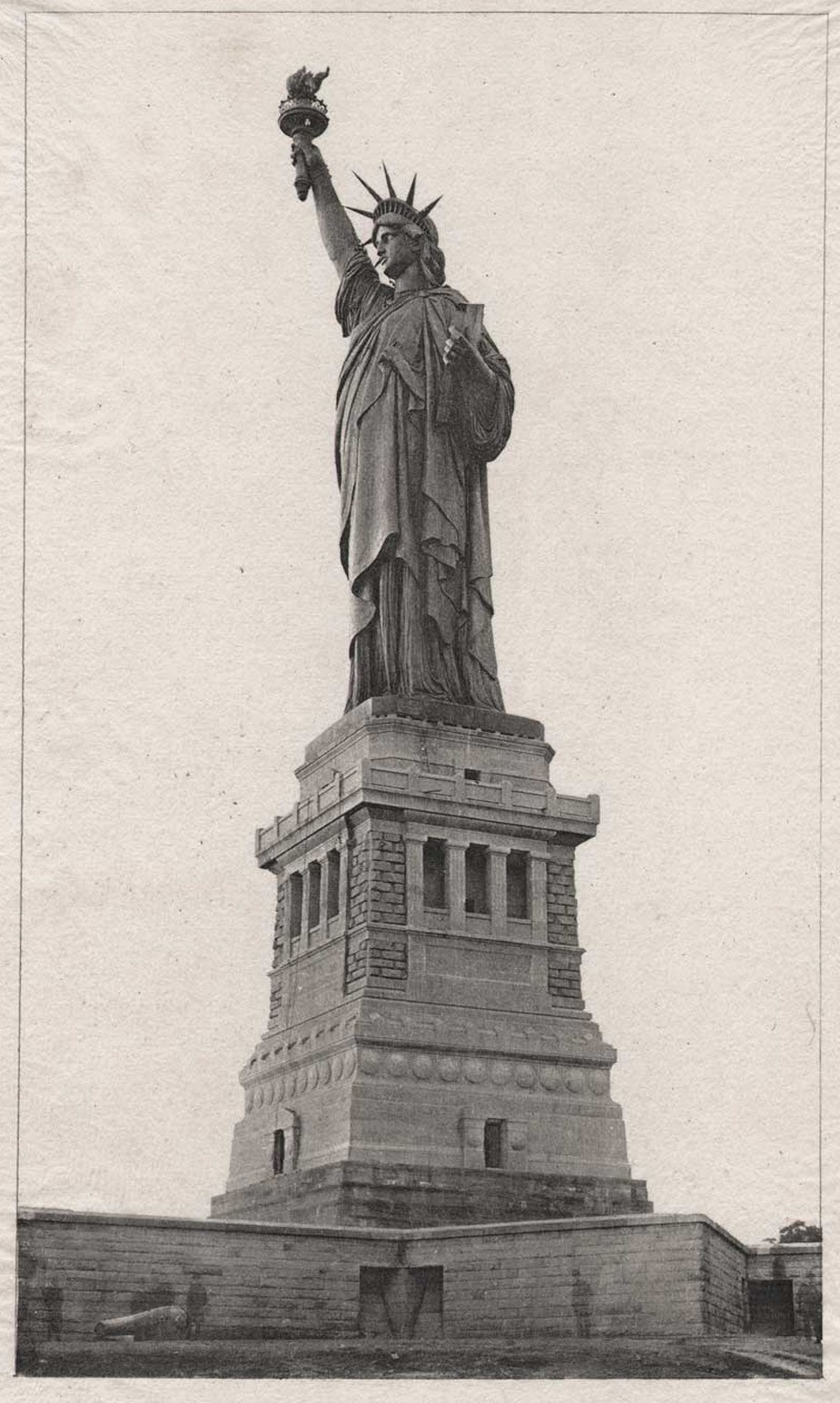 “Statue of Liberty”: Edward H. Hart, American photographer. Vintage Japan-tissue photogravure: 1886: printed ca. 1897-1900: Photogravure and Color Co. (New York): 17.2 x 10.1 | 20.9 x 12.5 cm | supports: 23.5 x 20.0 | 29.0 x 22.2 cm. This rare view of the Statue of Liberty (Liberty Enlightening the World) in New York Harbor was taken in the year it was officially dedicated, which took place October 28, 1886. E.H. Hart was a New York City based photographer with a studio at 1162 Broadway when contracted by the Photo-Gravure Co. of New York in 1886 to make several views of the statue. The company copyrighted one of these that year, titling it “Liberty”. A surviving example in the form of a mounted woodburytype process photograph is held by the National Archives at College Park in the U.S. state of Maryland. (Identifier: 45701938) This variant view by Hart includes the intriguing presence of six people who appear as “ghosts” at the base of the pedestal to the statue, their likeness due to movement during the long time-exposure required. The photographer billed himself an official U.S. Naval photographer, although it’s unclear if he was actually an employee of the Federal Government. A contract photographer for the Detroit Publishing Company in the late 19th Century, he was the author and publisher of the 1898 volume “The Authentic Photographic Views of the United States Navy”. From: PhotoSeed Archive
“Statue of Liberty”: Edward H. Hart, American photographer. Vintage Japan-tissue photogravure: 1886: printed ca. 1897-1900: Photogravure and Color Co. (New York): 17.2 x 10.1 | 20.9 x 12.5 cm | supports: 23.5 x 20.0 | 29.0 x 22.2 cm. This rare view of the Statue of Liberty (Liberty Enlightening the World) in New York Harbor was taken in the year it was officially dedicated, which took place October 28, 1886. E.H. Hart was a New York City based photographer with a studio at 1162 Broadway when contracted by the Photo-Gravure Co. of New York in 1886 to make several views of the statue. The company copyrighted one of these that year, titling it “Liberty”. A surviving example in the form of a mounted woodburytype process photograph is held by the National Archives at College Park in the U.S. state of Maryland. (Identifier: 45701938) This variant view by Hart includes the intriguing presence of six people who appear as “ghosts” at the base of the pedestal to the statue, their likeness due to movement during the long time-exposure required. The photographer billed himself an official U.S. Naval photographer, although it’s unclear if he was actually an employee of the Federal Government. A contract photographer for the Detroit Publishing Company in the late 19th Century, he was the author and publisher of the 1898 volume “The Authentic Photographic Views of the United States Navy”. From: PhotoSeed Archive
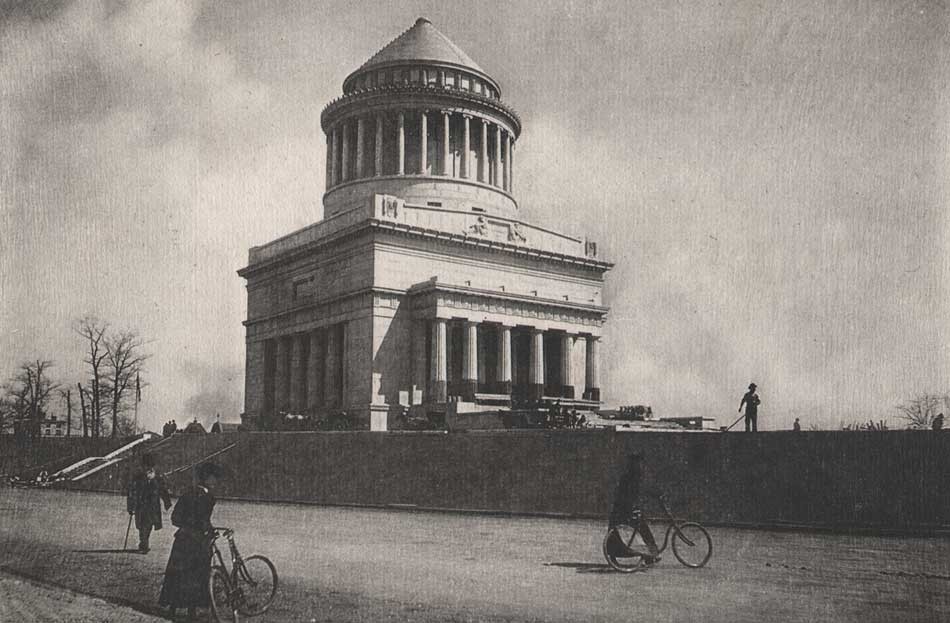 “Grant Memorial”: John S. Johnston, American photographer, born England or Ireland. (c.1839-1899). Vintage Japan-tissue photogravure: 1897: printed ca. 1897-1900: Photogravure and Color Co. (New York): 10.6 x 14.8 | 14.5 x 17.4 cm | supports: 19.5 x 24.5 | 22.2 x 29.0 cm. Taken in early 1897, this New York City view shows bicyclists on Riverside Drive with the soon to be opened General Grant National Memorial in the background. Known more commonly as Grant’s Tomb, it is located in the Morningside Heights neighborhood of Upper Manhattan. The massive domed mausoleum in the Neoclassical style is the final resting place for American Civil War General and 18th President of the United States Ulysses S. Grant. (1822-1885) Grant led the Union Army as Commanding General of the United States Army in winning the American Civil War. A close inspection of this photograph reveals ongoing work to the front stairwell area to the memorial, with large boards erected lengthwise against the base of the large columns. It was dedicated on April 27, 1897, the 75th-anniversary ceremony of Grant's birth on April 27, 1822. A known variant giving credit to Johnston is held privately, along with another more frontal view of the memorial and one example believed to be this very image at The Library of Congress. The library holds approximately 750 dry plate glass negatives of yachts and other marine craft views taken by Johnston when he was a contract photographer for the Detroit Publishing Company. A New York Times obituary for the photographer noted he “made a specialty of scenic photography. He photographed most of the United States warships during the war with Spain. He also photographed all of the international yacht races during the past ten years.” From: PhotoSeed Archive
“Grant Memorial”: John S. Johnston, American photographer, born England or Ireland. (c.1839-1899). Vintage Japan-tissue photogravure: 1897: printed ca. 1897-1900: Photogravure and Color Co. (New York): 10.6 x 14.8 | 14.5 x 17.4 cm | supports: 19.5 x 24.5 | 22.2 x 29.0 cm. Taken in early 1897, this New York City view shows bicyclists on Riverside Drive with the soon to be opened General Grant National Memorial in the background. Known more commonly as Grant’s Tomb, it is located in the Morningside Heights neighborhood of Upper Manhattan. The massive domed mausoleum in the Neoclassical style is the final resting place for American Civil War General and 18th President of the United States Ulysses S. Grant. (1822-1885) Grant led the Union Army as Commanding General of the United States Army in winning the American Civil War. A close inspection of this photograph reveals ongoing work to the front stairwell area to the memorial, with large boards erected lengthwise against the base of the large columns. It was dedicated on April 27, 1897, the 75th-anniversary ceremony of Grant's birth on April 27, 1822. A known variant giving credit to Johnston is held privately, along with another more frontal view of the memorial and one example believed to be this very image at The Library of Congress. The library holds approximately 750 dry plate glass negatives of yachts and other marine craft views taken by Johnston when he was a contract photographer for the Detroit Publishing Company. A New York Times obituary for the photographer noted he “made a specialty of scenic photography. He photographed most of the United States warships during the war with Spain. He also photographed all of the international yacht races during the past ten years.” From: PhotoSeed Archive
Window Gazing
Posted April 2020 in New Additions
Patience - A Haiku
Premonition bound
A great, hopeful patience sleeps
beyond the window
⎯ Apologies: Poem Generator
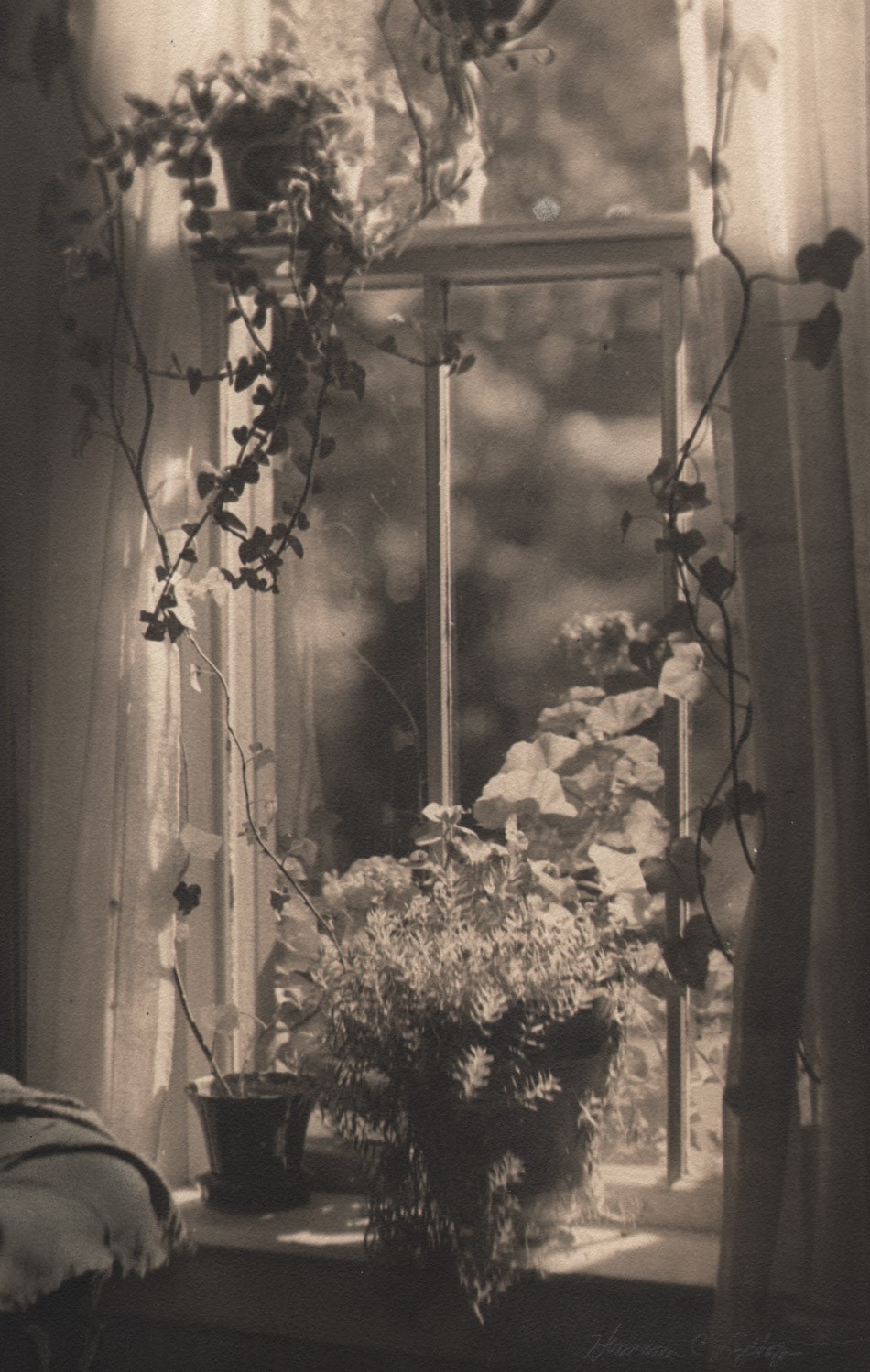 Detail: “The Winter Garden” Hermann Charles Lythgoe (1874-1962), American: vintage unmounted bromide print ca. 1920-40: (31.2 x 16.9 cm) Houseplants and flowers compete for sunlight on interior windowsills in this study by accomplished Boston-area amateur photographer Hermann Lythgoe. A chemist by training, he graduated from the Massachusetts Institute of Technology (MIT) in 1896 and went on to become the longtime Director for the Division of Food and Drugs at the Massachusetts Department of Public Health in Boston. From: PhotoSeed Archive
Detail: “The Winter Garden” Hermann Charles Lythgoe (1874-1962), American: vintage unmounted bromide print ca. 1920-40: (31.2 x 16.9 cm) Houseplants and flowers compete for sunlight on interior windowsills in this study by accomplished Boston-area amateur photographer Hermann Lythgoe. A chemist by training, he graduated from the Massachusetts Institute of Technology (MIT) in 1896 and went on to become the longtime Director for the Division of Food and Drugs at the Massachusetts Department of Public Health in Boston. From: PhotoSeed ArchiveMarch Madness: Old School
Posted March 2020 in Alternate Processes, Documentary Photography, Sports Photography, Unknown Photographers
March Madness, the fanciful right of passage in the U.S. crowning a men’s and women’s national collegiate basketball champion, got cancelled this year. Instead, this aforesaid Madness has become a perfect descriptor for a reality that is the ongoing global pandemic caused by the COVID-19 coronavirus. Obviously, what little PhotoSeed contributes during this time of uncertainty are mere diversions, yet ones curated with the intent of promoting positivity for our shared love of the universal language that is Photography.
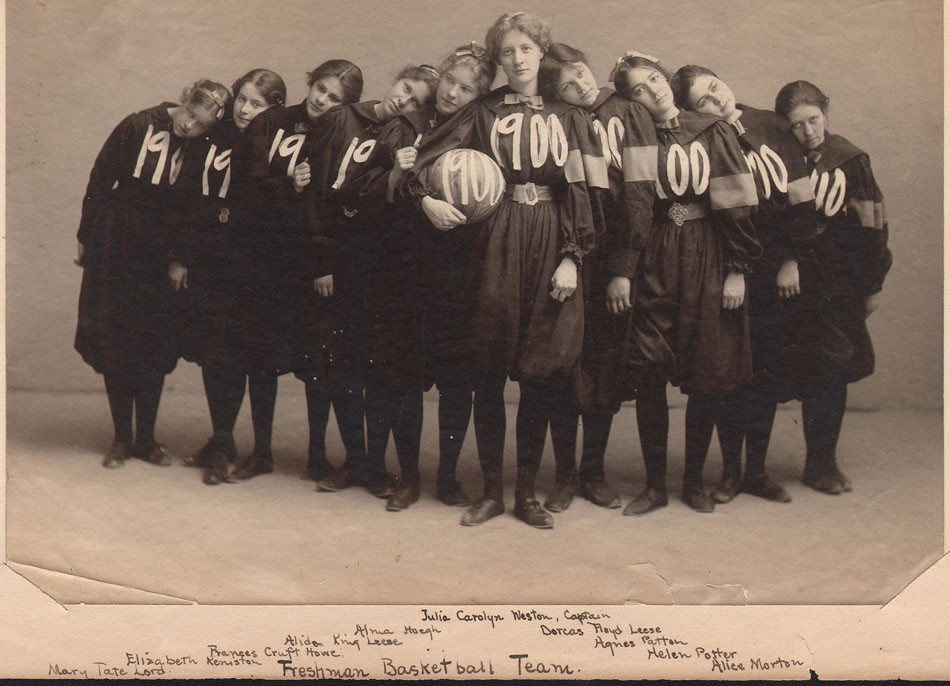 Detail: “Freshman Basket ball Team” (Smith College) Unknown American commercial photographer (possibly Amand Joseph “A.J. Schillare: 1856-1917 of Northampton who advertised “groups and dramatics a specialty” in the 1899 Class Book): Gelatin Silver print: ca. 1897 (15.9 x 21.1 cm | 18.2 x 27.5 cm loosely inserted within thin, manilla album leaf) These ten young women made up the Smith College Basket Ball Team for the 1900 graduating class. The photograph was taken approximately 4 years earlier, when they would have been freshmen. At center holding the ball is team captain Julia Carolyn Weston, (1877-1937) whose future daughter, Julia Child, (1912-2004: Smith College, class of 1934) became the legendary chef and famed American television personality. Known by her nickname “Caro”, Julia Weston was “known for her red hair, outspoken opinions, and sense of humor.” (source: Julia Child: My Life in France) This unique photograph is further annotated on the verso in graphite by team members in their own hand. Players left to right: Mary Tate Lord, Elizabeth Keniston, Frances Cruft Howe, Alida King Leese, Alma Hoegh, Carolyn Weston, Dorcas Floyd Leese, Agnes Patton, Helen Potter, Alice Morton. From: PhotoSeed Archive
Detail: “Freshman Basket ball Team” (Smith College) Unknown American commercial photographer (possibly Amand Joseph “A.J. Schillare: 1856-1917 of Northampton who advertised “groups and dramatics a specialty” in the 1899 Class Book): Gelatin Silver print: ca. 1897 (15.9 x 21.1 cm | 18.2 x 27.5 cm loosely inserted within thin, manilla album leaf) These ten young women made up the Smith College Basket Ball Team for the 1900 graduating class. The photograph was taken approximately 4 years earlier, when they would have been freshmen. At center holding the ball is team captain Julia Carolyn Weston, (1877-1937) whose future daughter, Julia Child, (1912-2004: Smith College, class of 1934) became the legendary chef and famed American television personality. Known by her nickname “Caro”, Julia Weston was “known for her red hair, outspoken opinions, and sense of humor.” (source: Julia Child: My Life in France) This unique photograph is further annotated on the verso in graphite by team members in their own hand. Players left to right: Mary Tate Lord, Elizabeth Keniston, Frances Cruft Howe, Alida King Leese, Alma Hoegh, Carolyn Weston, Dorcas Floyd Leese, Agnes Patton, Helen Potter, Alice Morton. From: PhotoSeed Archive
Today’s post concerns the early history of women’s basketball, a game commonly spelled in the late 19th and early 20th centuries as two words: “basket ball”. What follows are a series of vintage photographs ✻ from the PhotoSeed archive showcasing the origins of the collegiate game as it evolved on the campus of Smith College in Northampton, Massachusetts.
It was here, in 1892, less than one year after James Naismith invented the game in nearby Springfield, that newly appointed Smith College school gymnastics instructor Senda Berenson Abbott (1868-1954) would adapt the rules of the new game for women. By 1893, she had organized the first college game in history, between players from the sophomore class of 1895 and the freshman class of 1896. In so doing, Berenson changed history, and forever became known as the “Mother of Women’s Basketball”. A wonderful video on the dawn of the game at Smith featuring Senda’s accomplishments was written and produced by Kate Lee and can be found here on YouTube. Another link shows the earliest known film footage of the game played at Missouri Valley College in 1904. Enjoy our gallery! -David Spencer
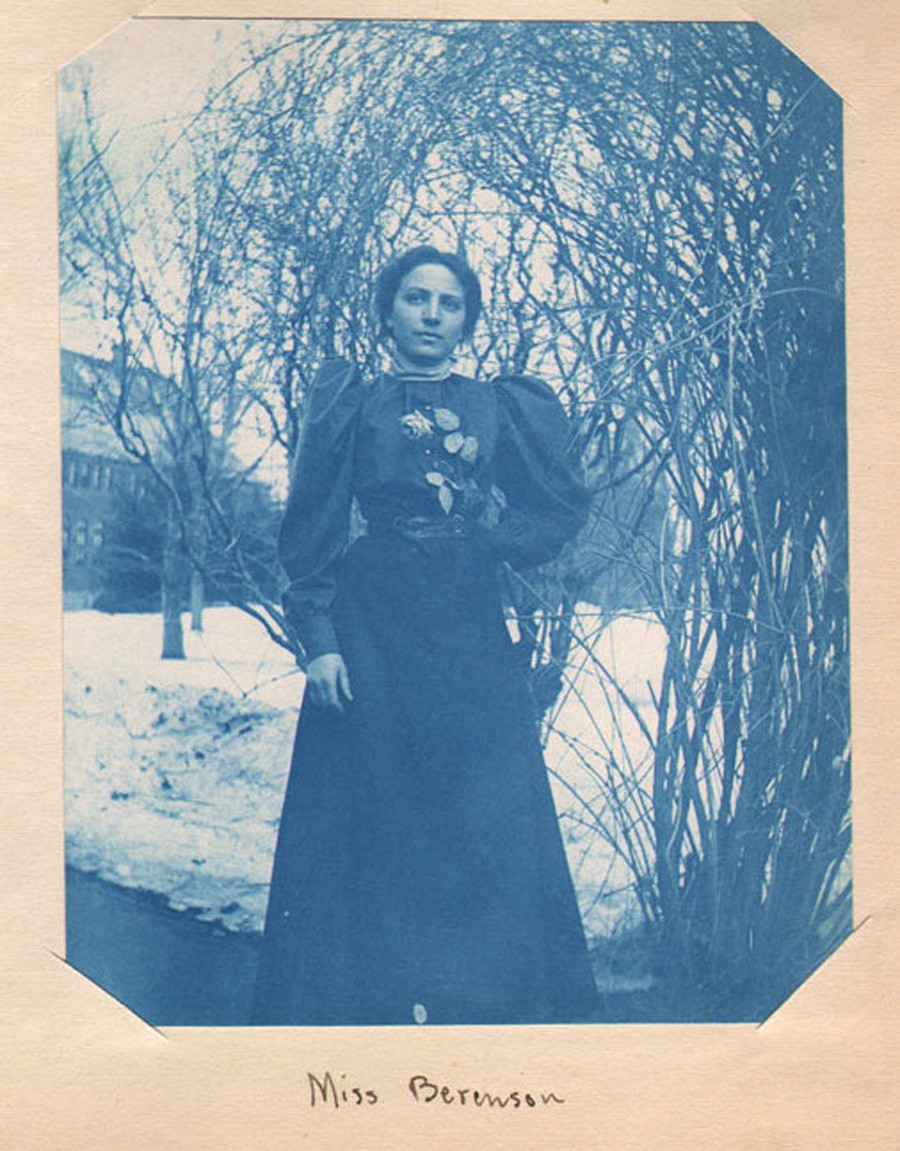 "Miss Berenson” (Senda Berenson Abbott: 1868-1954) Unknown American photographer: cyanotype: ca. 1897-99 (11.5 x 9.0 cm | 18.2 x 27.5 cm loosely inserted within thin, manilla album leaf) Known as the ‘’Mother of Women's Basketball'' Berenson was first hired as a gymnastics instructor at Smith College before becoming the Director of the Gymnasium and Instructor of Physical Culture there, adapting the first rules of women's basketball in 1892. The game had been invented less than a year earlier by James Naismith in nearby Springfield, Mass. By 1899, Berenson had codified her rules for the women’s game, and in 1901, they were published in the volume “Basket Ball for Women” by Spalding’s Athletic Library. From: PhotoSeed Archive
"Miss Berenson” (Senda Berenson Abbott: 1868-1954) Unknown American photographer: cyanotype: ca. 1897-99 (11.5 x 9.0 cm | 18.2 x 27.5 cm loosely inserted within thin, manilla album leaf) Known as the ‘’Mother of Women's Basketball'' Berenson was first hired as a gymnastics instructor at Smith College before becoming the Director of the Gymnasium and Instructor of Physical Culture there, adapting the first rules of women's basketball in 1892. The game had been invented less than a year earlier by James Naismith in nearby Springfield, Mass. By 1899, Berenson had codified her rules for the women’s game, and in 1901, they were published in the volume “Basket Ball for Women” by Spalding’s Athletic Library. From: PhotoSeed Archive
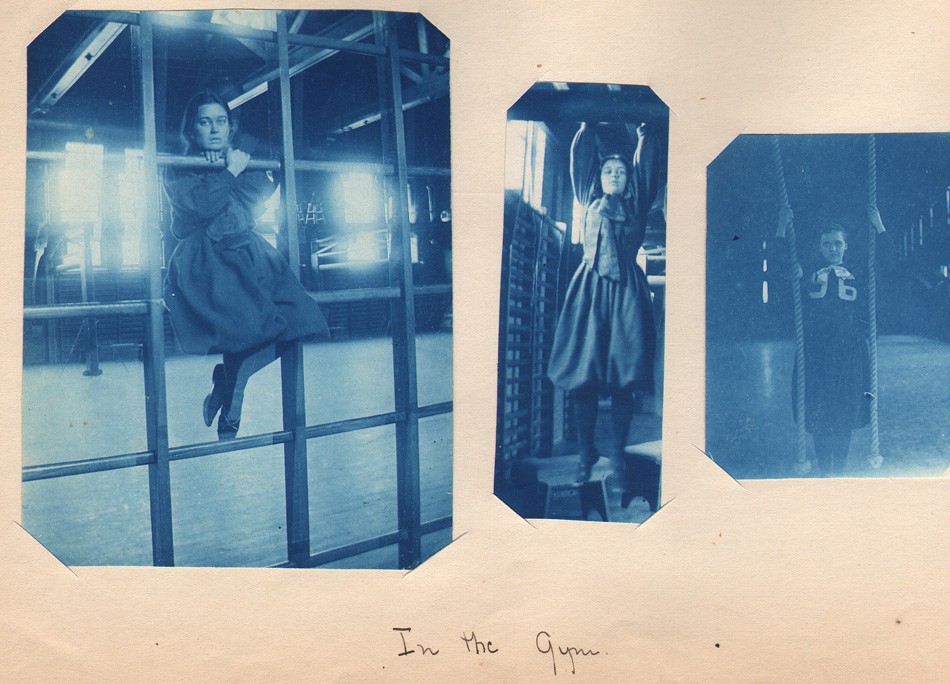 “In the Gym” (Smith College: Northampton, Mass.) Unknown American photographer(s): cyanotypes: ca. 1897-99 (L: 11.9 x 9.1 cm | M: 9.3 x 3.5 cm | R: Detail: 7.3 x 9.7 cm) (18.2 x 27.5 cm loosely inserted within thin, manilla album leaf) Smith College students using the exercise and gymnastics equipment in Alumnae Gymnasium on campus are shown. Physical education for women was an important component of a collegiate education at Smith, especially after the college had built this new facility in 1890, one of the finest of its’ type in the country. Public sentiment however, beginning from Senda Berenson’s early tenure at Smith in the early 1890’s, was something she pushed back against- with obvious success. From her Wikipedia page: “Although the physical facilities were in fine shape, the notion that women should engage in physical exercise, much less be required to do so, was not then well-established. The prevailing atmosphere did not support the notion that women should engage in physical activity. Berenson would write, in 1894: “Until recent years, the so-called ideal woman was a small waisted, small footed, small brained damsel, who prided herself on her delicate health, who thought fainting interesting, and hysterics fascinating.” From: PhotoSeed Archive
“In the Gym” (Smith College: Northampton, Mass.) Unknown American photographer(s): cyanotypes: ca. 1897-99 (L: 11.9 x 9.1 cm | M: 9.3 x 3.5 cm | R: Detail: 7.3 x 9.7 cm) (18.2 x 27.5 cm loosely inserted within thin, manilla album leaf) Smith College students using the exercise and gymnastics equipment in Alumnae Gymnasium on campus are shown. Physical education for women was an important component of a collegiate education at Smith, especially after the college had built this new facility in 1890, one of the finest of its’ type in the country. Public sentiment however, beginning from Senda Berenson’s early tenure at Smith in the early 1890’s, was something she pushed back against- with obvious success. From her Wikipedia page: “Although the physical facilities were in fine shape, the notion that women should engage in physical exercise, much less be required to do so, was not then well-established. The prevailing atmosphere did not support the notion that women should engage in physical activity. Berenson would write, in 1894: “Until recent years, the so-called ideal woman was a small waisted, small footed, small brained damsel, who prided herself on her delicate health, who thought fainting interesting, and hysterics fascinating.” From: PhotoSeed Archive
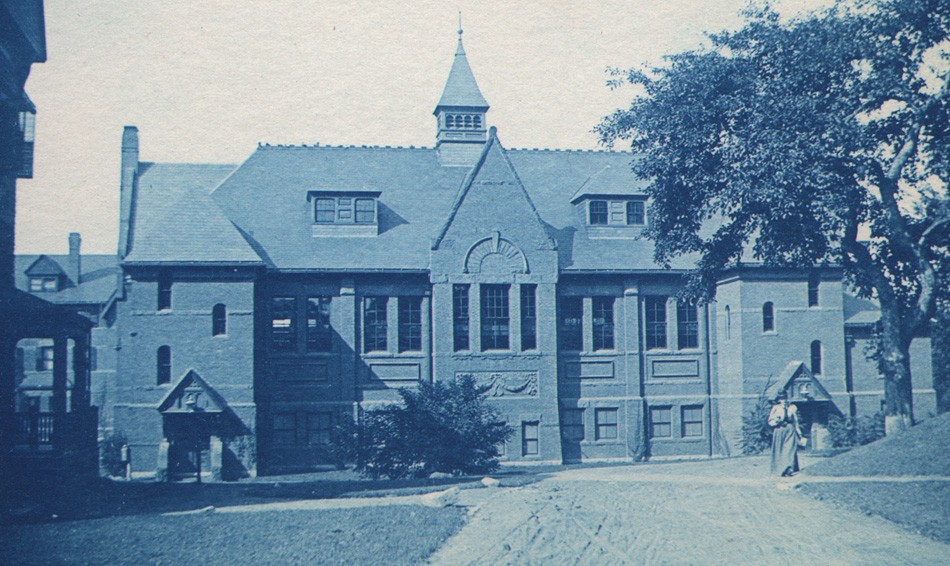 Detail: “The Alumnae Gymnasium” (Smith College: Northampton, Mass.) Unknown American photographer: cyanotype: ca. 1897-1900 (9.3 x 12.0 cm | 18.2 x 27.5 cm loosely inserted within thin, manilla album leaf) It was in this building that the first women’s college basketball game in history took place on March 22, 1893 between players from the Smith College sophomore class of 1895 and the freshman class of 1896. The sophomores won, 5-4, during two, 15-minute halves under Naismith rules. The Late Gothic style building was built from red brick with brownstone trim and designed by architect William C. Brocklesby of Hartford, CT. Today it houses the Smith College Archives, and was saved from demolition in 1977 when it was moved 200’ from its original location in order to comply with a campus expansion. From: PhotoSeed Archive
Detail: “The Alumnae Gymnasium” (Smith College: Northampton, Mass.) Unknown American photographer: cyanotype: ca. 1897-1900 (9.3 x 12.0 cm | 18.2 x 27.5 cm loosely inserted within thin, manilla album leaf) It was in this building that the first women’s college basketball game in history took place on March 22, 1893 between players from the Smith College sophomore class of 1895 and the freshman class of 1896. The sophomores won, 5-4, during two, 15-minute halves under Naismith rules. The Late Gothic style building was built from red brick with brownstone trim and designed by architect William C. Brocklesby of Hartford, CT. Today it houses the Smith College Archives, and was saved from demolition in 1977 when it was moved 200’ from its original location in order to comply with a campus expansion. From: PhotoSeed Archive
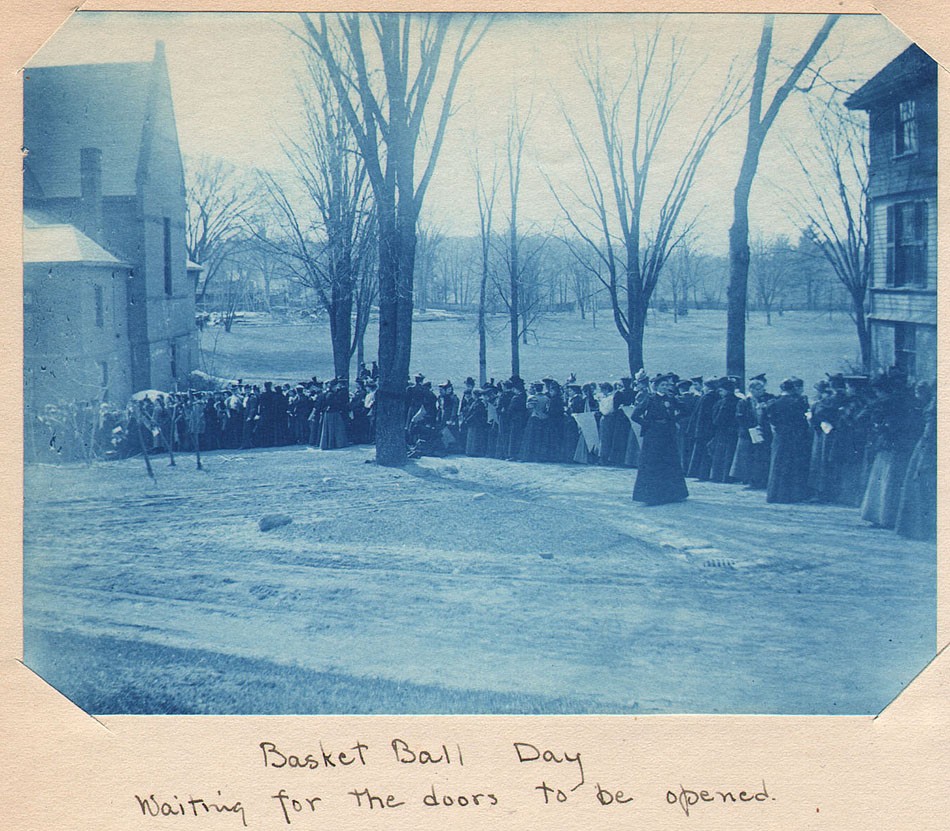 “Basket Ball Day - Waiting for the Doors to be Opened” (Smith College: Northampton, Mass.) Unknown American photographer: cyanotype: ca. 1897-1900 (9.4 x 12.3 cm | 18.2 x 27.5 cm loosely inserted within thin, manilla album leaf) With some students holding class pennants used to cheer their team on, a long line of Smith women’s basketball fans wait two and three deep for the doors to be opened at Alumnae Gymnasium at far left. At far right is the former gym, a much smaller wooden structure, which originally opened in 1879 soon after the school opened. From: PhotoSeed Archive
“Basket Ball Day - Waiting for the Doors to be Opened” (Smith College: Northampton, Mass.) Unknown American photographer: cyanotype: ca. 1897-1900 (9.4 x 12.3 cm | 18.2 x 27.5 cm loosely inserted within thin, manilla album leaf) With some students holding class pennants used to cheer their team on, a long line of Smith women’s basketball fans wait two and three deep for the doors to be opened at Alumnae Gymnasium at far left. At far right is the former gym, a much smaller wooden structure, which originally opened in 1879 soon after the school opened. From: PhotoSeed Archive
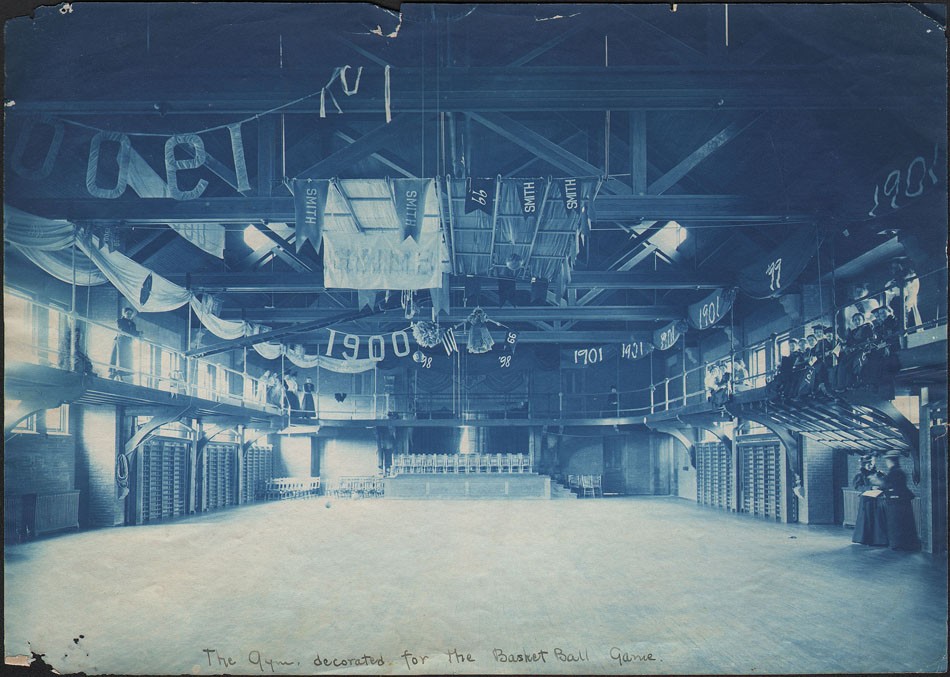 “The Gym, decorated for the Basket Ball Game” (Smith College: Northampton, Mass.) Unknown American commercial photographer: cyanotype: ca. 1898 (17.4 x 24.4 cm found loose within disassembled album with leaves each measuring 18.2 x 27.5 cm) Alumnae Gymnasium, opened in 1890, is shown decorated with bunting above the second level at left and at far right with the different class years represented: 98’, 99’, 1900, 1901. The occasion is believed to be a game between teams from the 1900 and 1901 classes, which took place on March 26, 1898. (1900 team won, 30-11⅓) In the early years when this photograph was taken around 1898, basketball as a women’s sport was played on the intramural level, with the various class years from the same college playing against each other. Wikipedia states Senda “Berenson herself opposed intercollegiate play for women, and prioritized the health and fitness benefits for a larger goal”. From: PhotoSeed Archive
“The Gym, decorated for the Basket Ball Game” (Smith College: Northampton, Mass.) Unknown American commercial photographer: cyanotype: ca. 1898 (17.4 x 24.4 cm found loose within disassembled album with leaves each measuring 18.2 x 27.5 cm) Alumnae Gymnasium, opened in 1890, is shown decorated with bunting above the second level at left and at far right with the different class years represented: 98’, 99’, 1900, 1901. The occasion is believed to be a game between teams from the 1900 and 1901 classes, which took place on March 26, 1898. (1900 team won, 30-11⅓) In the early years when this photograph was taken around 1898, basketball as a women’s sport was played on the intramural level, with the various class years from the same college playing against each other. Wikipedia states Senda “Berenson herself opposed intercollegiate play for women, and prioritized the health and fitness benefits for a larger goal”. From: PhotoSeed Archive
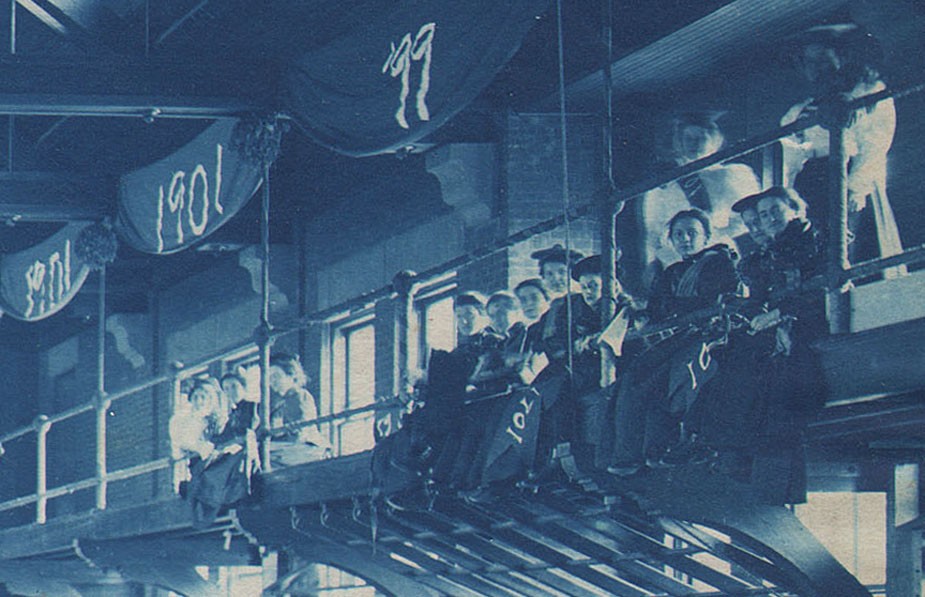 Detail: “The Gym, decorated for the Basket Ball Game” (Smith College: Northampton, Mass.) Unknown American commercial photographer: cyanotype: ca. 1898 (17.4 x 24.4 cm found loose within disassembled album with leaves each measuring 18.2 x 27.5 cm) Seated along a second level railing in Alumnae Gymnasium with their legs dangling over the side of the court are a group of women with one having a strong resemblance to Senda Berenson (third from right with 01 usher standing behind her) along with upperclassmen and most likely several teachers. From: PhotoSeed Archive
Detail: “The Gym, decorated for the Basket Ball Game” (Smith College: Northampton, Mass.) Unknown American commercial photographer: cyanotype: ca. 1898 (17.4 x 24.4 cm found loose within disassembled album with leaves each measuring 18.2 x 27.5 cm) Seated along a second level railing in Alumnae Gymnasium with their legs dangling over the side of the court are a group of women with one having a strong resemblance to Senda Berenson (third from right with 01 usher standing behind her) along with upperclassmen and most likely several teachers. From: PhotoSeed Archive
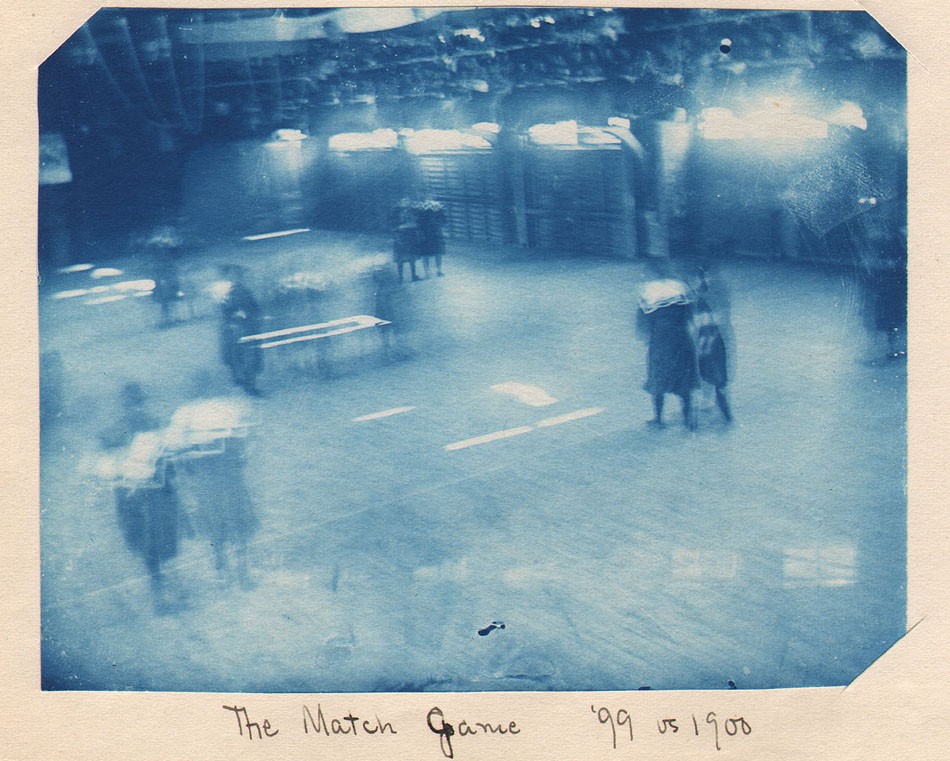 “The Match Game ’99 vs 1900” (Smith College: Northampton, Mass.) Unknown American photographer: cyanotype: ca. 1897 (9.6 x 12.2 cm | 18.2 x 27.5 cm loosely inserted within thin, manilla album leaf) This basketball game is believed to have been played on Saturday, March 27, 1897. This blurred view shows members of the Smith College class of 1899 and 1900 teams playing each other on the floor of Alumnae Gymnasium. The following description of some of the game rules were included in the article “Basket-Ball at Smith College” by Elizabeth Fisher Read published in The Outlook on September 26, 1896: “During the winter the games are played in the Alumnae Gymnasium. The floor of the gymnasium is marked off into three divisions, each of which forms the territory of a certain number of the players on each side. In each of the end divisions is a goal—an eighteen-inch cylinder or basket, the mouth of which is ten feet from the floor. The object of the game is to get the ball into the basket. At Smith a regulation Rugby football is used. Each basket is protected by three "homes"—players on the side to which that goal belongs, whose object is to get the ball into the basket. In the same territory stand three "guards," players on the other side, who try to prevent their opponents from scoring. In the middle division the "centers," four in number, play. The center players on each side try to get the ball when the referee puts it into play by tossing it out among them, and to pass it along from one member of the team to another, until it reaches the homes, and a goal is scored. The side scoring the most goals in forty minutes wins the game. The game is played in two halves of twenty minutes each, with ten minutes' intermission.” (p 557) From: PhotoSeed Archive
“The Match Game ’99 vs 1900” (Smith College: Northampton, Mass.) Unknown American photographer: cyanotype: ca. 1897 (9.6 x 12.2 cm | 18.2 x 27.5 cm loosely inserted within thin, manilla album leaf) This basketball game is believed to have been played on Saturday, March 27, 1897. This blurred view shows members of the Smith College class of 1899 and 1900 teams playing each other on the floor of Alumnae Gymnasium. The following description of some of the game rules were included in the article “Basket-Ball at Smith College” by Elizabeth Fisher Read published in The Outlook on September 26, 1896: “During the winter the games are played in the Alumnae Gymnasium. The floor of the gymnasium is marked off into three divisions, each of which forms the territory of a certain number of the players on each side. In each of the end divisions is a goal—an eighteen-inch cylinder or basket, the mouth of which is ten feet from the floor. The object of the game is to get the ball into the basket. At Smith a regulation Rugby football is used. Each basket is protected by three "homes"—players on the side to which that goal belongs, whose object is to get the ball into the basket. In the same territory stand three "guards," players on the other side, who try to prevent their opponents from scoring. In the middle division the "centers," four in number, play. The center players on each side try to get the ball when the referee puts it into play by tossing it out among them, and to pass it along from one member of the team to another, until it reaches the homes, and a goal is scored. The side scoring the most goals in forty minutes wins the game. The game is played in two halves of twenty minutes each, with ten minutes' intermission.” (p 557) From: PhotoSeed Archive
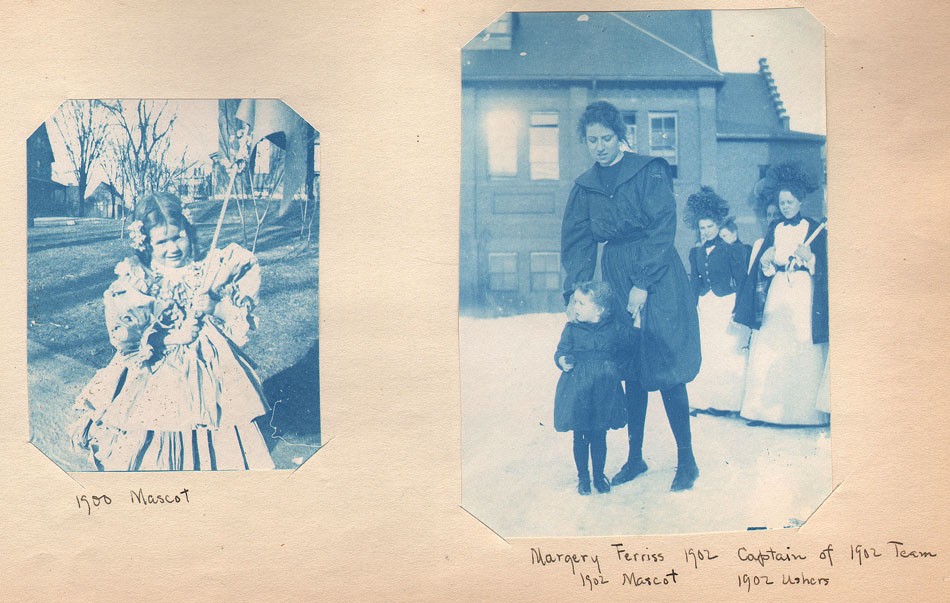 Left: “1900 Mascot” Right: “Margery Ferriss Captain of 1902 Team (along with) 1902 Mascot & 1902 Ushers” (Smith College: Northampton, Mass.) Unknown American photographer(s): cyanotype: ca. 1897-1899 (Left: 8.4 x 6.6 cm Right: 11.9 x 8.4 cm | 18.2 x 27.5 cm loosely inserted within thin, manilla album leaf) Team spirit for the new game of Basket Ball at Smith was ever present, with fans and students wearing distinctive colors on the big day. Each class even had their own “Mascot” : a young child dressed up for the occasion. At left, the 1900 class mascot wears a fancy child’s dress while holding a banner. By 1902, team captain Margery Ferriss, standing in front of Alumnae Gym, holds the hand of the class year Mascot, sporting a miniature version of the team outfit that she herself wears. The following description of game spirit at Smith was included in the article “Basket-Ball at Smith College” by Elizabeth Fisher Read published in The Outlook on September 26, 1896: “While waiting for the teams to come out, the students while away the time by singing songs gotten up for the occasion. These songs consist of lines appropriate to the situation, in praise of the class or the team, set to some popular melody. From time to time both sides join in singing some song of general interest. As each member of the Faculty comes in, he is greeted with cheers and with his verse of the "Faculty song." During the actual playing no singing is permitted, but in the intermission it is renewed with increased vigor, the winning side trying to express their approval and pleasure, the losers trying to cheer up their team to greater efforts. After the game cheers, songs, and a triumphal parade end the contest.” (p. 558) From: PhotoSeed Archive
Left: “1900 Mascot” Right: “Margery Ferriss Captain of 1902 Team (along with) 1902 Mascot & 1902 Ushers” (Smith College: Northampton, Mass.) Unknown American photographer(s): cyanotype: ca. 1897-1899 (Left: 8.4 x 6.6 cm Right: 11.9 x 8.4 cm | 18.2 x 27.5 cm loosely inserted within thin, manilla album leaf) Team spirit for the new game of Basket Ball at Smith was ever present, with fans and students wearing distinctive colors on the big day. Each class even had their own “Mascot” : a young child dressed up for the occasion. At left, the 1900 class mascot wears a fancy child’s dress while holding a banner. By 1902, team captain Margery Ferriss, standing in front of Alumnae Gym, holds the hand of the class year Mascot, sporting a miniature version of the team outfit that she herself wears. The following description of game spirit at Smith was included in the article “Basket-Ball at Smith College” by Elizabeth Fisher Read published in The Outlook on September 26, 1896: “While waiting for the teams to come out, the students while away the time by singing songs gotten up for the occasion. These songs consist of lines appropriate to the situation, in praise of the class or the team, set to some popular melody. From time to time both sides join in singing some song of general interest. As each member of the Faculty comes in, he is greeted with cheers and with his verse of the "Faculty song." During the actual playing no singing is permitted, but in the intermission it is renewed with increased vigor, the winning side trying to express their approval and pleasure, the losers trying to cheer up their team to greater efforts. After the game cheers, songs, and a triumphal parade end the contest.” (p. 558) From: PhotoSeed Archive
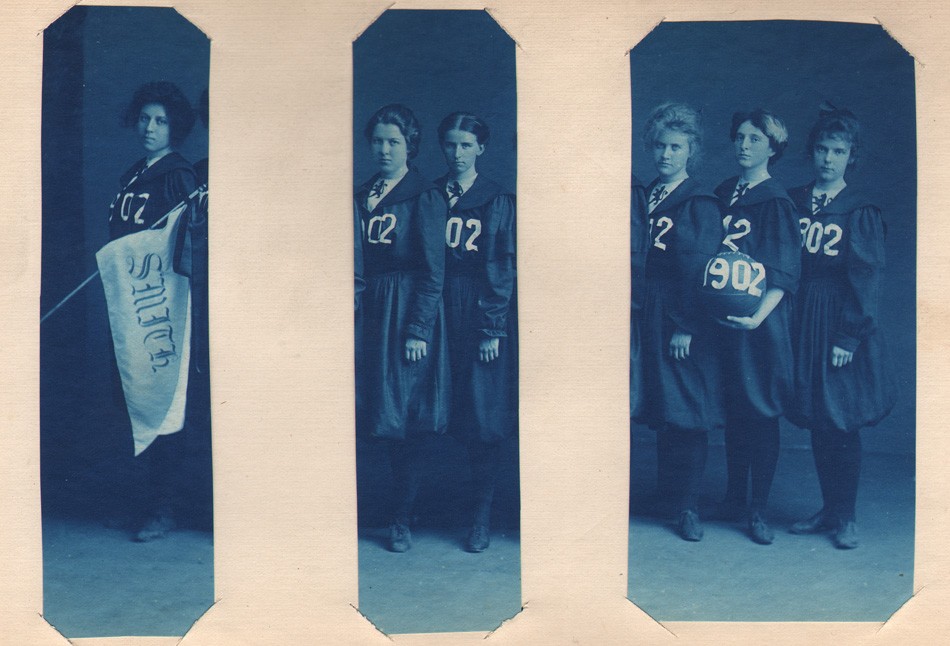 “1902 Freshman Basket-Ball Team” (Smith College: Northampton, Mass.) Unknown American commercial photographer (possibly Amand Joseph “A.J.” Schillare: 1856-1917 of Northampton who advertised “groups and dramatics a specialty” in the 1899 Class Book): cyanotype presented as triptych within album leaf : ca. 1898 (Left: 13.2 x 3.6 cm Middle: 13.1 x 3.4 cm | Right: 12.6 x 6.0 cm | 18.2 x 27.5 cm thin, manilla album leaf) In this unusual variant from one published featuring 11 players in the 1902 Smith Class Book, only six players are shown. At far left, team captain Margery Ferriss holds the Smith pennant. Margery May Ferriss Semple (1880-1950) was originally from St. Louis, MO. 1902 team members were: Homes: Juliet Patten, Constance Patton, Helen Walbridge; Guards: Margery Ferriss, Harriet Emmons, Louise Vanderbilt; Centres: Eda Bruné, Agnes Inglis, Mary Glover, Katherine Harter. From: PhotoSeed Archive
“1902 Freshman Basket-Ball Team” (Smith College: Northampton, Mass.) Unknown American commercial photographer (possibly Amand Joseph “A.J.” Schillare: 1856-1917 of Northampton who advertised “groups and dramatics a specialty” in the 1899 Class Book): cyanotype presented as triptych within album leaf : ca. 1898 (Left: 13.2 x 3.6 cm Middle: 13.1 x 3.4 cm | Right: 12.6 x 6.0 cm | 18.2 x 27.5 cm thin, manilla album leaf) In this unusual variant from one published featuring 11 players in the 1902 Smith Class Book, only six players are shown. At far left, team captain Margery Ferriss holds the Smith pennant. Margery May Ferriss Semple (1880-1950) was originally from St. Louis, MO. 1902 team members were: Homes: Juliet Patten, Constance Patton, Helen Walbridge; Guards: Margery Ferriss, Harriet Emmons, Louise Vanderbilt; Centres: Eda Bruné, Agnes Inglis, Mary Glover, Katherine Harter. From: PhotoSeed Archive
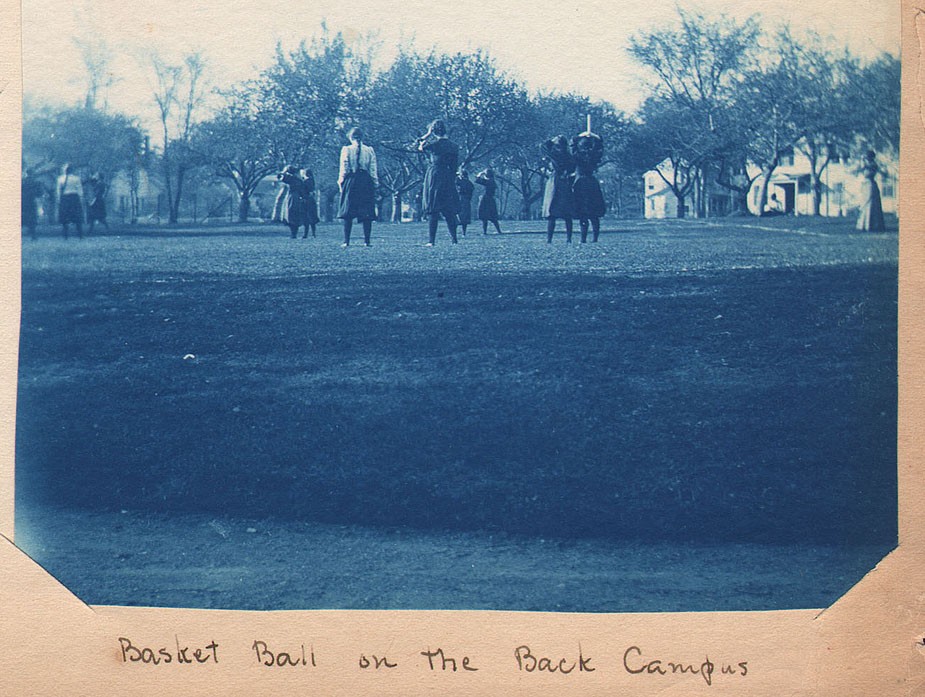 “Basket Ball on the Back Campus” (Smith College: Northampton, Mass.) Unknown American photographer: cyanotype: ca. 1898-1900 (9.1 x 11.7 cm | 18.2 x 27.5 cm loosely inserted within thin, manilla album leaf) It is unclear if this view shows a basketball game in progress or perhaps a practice, since no goals are seen. The student at front right holds some type of cylinder on top of her head-possibly signifying the placement for where the goal would be located? The following description describes basketball played during the Spring at Smith, included in the article “Basket-Ball at Smith College” by Elizabeth Fisher Read published in The Outlook on September 26, 1896: “In the spring the playing is done on a ground laid out on the campus. The pictures accompanying this article were taken on this out-of-door ground. The gymnasium suit shown in the pictures is the dress worn by all the gymnasium classes. It consists of a blouse with Turkish trousers. These out-of-door games are very popular with the students. The ground is nearly always surrounded by interested spectators when a game is going on.” (p. 558) From: PhotoSeed Archive
“Basket Ball on the Back Campus” (Smith College: Northampton, Mass.) Unknown American photographer: cyanotype: ca. 1898-1900 (9.1 x 11.7 cm | 18.2 x 27.5 cm loosely inserted within thin, manilla album leaf) It is unclear if this view shows a basketball game in progress or perhaps a practice, since no goals are seen. The student at front right holds some type of cylinder on top of her head-possibly signifying the placement for where the goal would be located? The following description describes basketball played during the Spring at Smith, included in the article “Basket-Ball at Smith College” by Elizabeth Fisher Read published in The Outlook on September 26, 1896: “In the spring the playing is done on a ground laid out on the campus. The pictures accompanying this article were taken on this out-of-door ground. The gymnasium suit shown in the pictures is the dress worn by all the gymnasium classes. It consists of a blouse with Turkish trousers. These out-of-door games are very popular with the students. The ground is nearly always surrounded by interested spectators when a game is going on.” (p. 558) From: PhotoSeed Archive
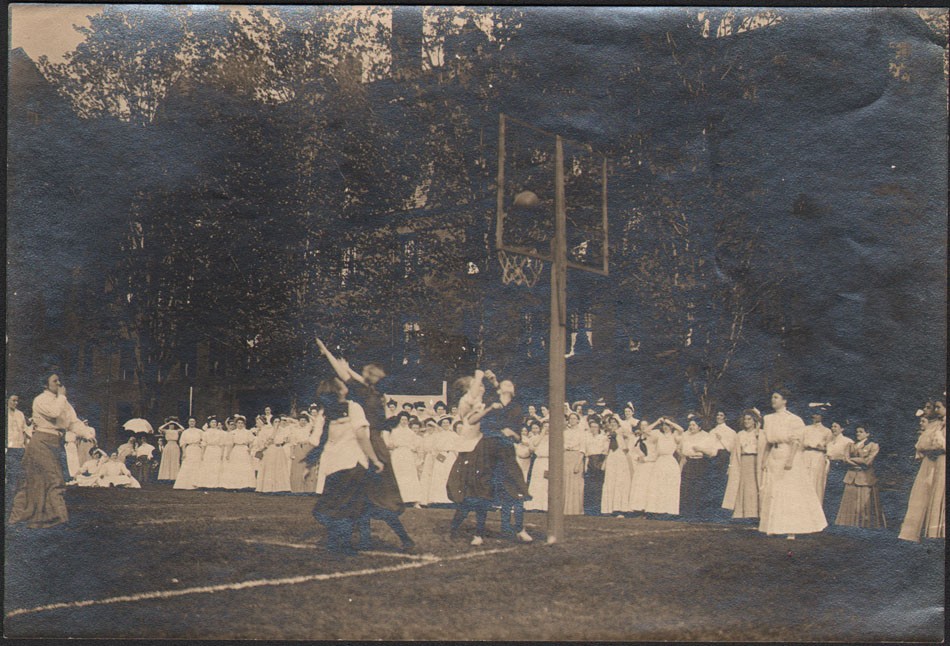 “Women’s outdoor Basket Ball Game: New England or Mid-Atlantic States” Unknown American photographer: gelatin silver print: ca. 1905-10 (11.4 x 17.0 cm - photograph enclosed within gummed manilla postal envelope engraved with spot hand-coloring on recto: “Kodak shots and postal cards Of many a pleasant view - Will bring the golden memories back Of happy days to you”) A rare surviving photograph featuring outdoor basketball action between two women’s collegiate teams is shown. Notice the ball aloft just above one of the suspended nets near the center of the composition, featuring an open-style backboard. A throng of fashionably dressed young women (and a lone gentleman) watch and cheer on the sidelines in the background. This game may have taken place as part of popular “Field Day” exercises colleges were known to host in the early Spring. Women’s basketball as a sport that in turn promoted good physical conditioning may have started at Smith in the early 1890’s but soon spread rapidly around the country: “Soon thereafter women at Wellesley, Vassar, Radcliff, and other women’s colleges and “normal schools” in the Northeast took up the sport. It was only a matter of time before basketball was being played by girls and women at high schools and colleges across America-including Montana.” (Source: “The Girls’ Basketball Team from Fort Shaw” by Linda Peavy and Ursula Smith in: Native Athletes in Sport and Society: edited by C. Richard King: University of Nebraska Press, 2005. (p. 44) From: PhotoSeed Archive
“Women’s outdoor Basket Ball Game: New England or Mid-Atlantic States” Unknown American photographer: gelatin silver print: ca. 1905-10 (11.4 x 17.0 cm - photograph enclosed within gummed manilla postal envelope engraved with spot hand-coloring on recto: “Kodak shots and postal cards Of many a pleasant view - Will bring the golden memories back Of happy days to you”) A rare surviving photograph featuring outdoor basketball action between two women’s collegiate teams is shown. Notice the ball aloft just above one of the suspended nets near the center of the composition, featuring an open-style backboard. A throng of fashionably dressed young women (and a lone gentleman) watch and cheer on the sidelines in the background. This game may have taken place as part of popular “Field Day” exercises colleges were known to host in the early Spring. Women’s basketball as a sport that in turn promoted good physical conditioning may have started at Smith in the early 1890’s but soon spread rapidly around the country: “Soon thereafter women at Wellesley, Vassar, Radcliff, and other women’s colleges and “normal schools” in the Northeast took up the sport. It was only a matter of time before basketball was being played by girls and women at high schools and colleges across America-including Montana.” (Source: “The Girls’ Basketball Team from Fort Shaw” by Linda Peavy and Ursula Smith in: Native Athletes in Sport and Society: edited by C. Richard King: University of Nebraska Press, 2005. (p. 44) From: PhotoSeed Archive
✻ The provenance for these photographs with the exception of the final one taken outdoors were part of a disassembled album that formerly belonged to Mary Ruth Perkins, a 1900 graduate of Smith who was Chairman of the 1900 class yearbook committee. Three students are given credit in the 1900 Class Book as having contributed photographs: Alma Hoegh, Cornelia Amey Kingman, Ora Mabelle Lewis.
Photograph: Meet Frame
Posted February 2020 in Conservation, Framing, New Additions, Photographic Preservation, PhotoSeed, Significant Photographers
Last August I had the uncommon opportunity to purchase five photographs ca. 1905-1910 that were still in their original picture frames taken by William T. Knox, (1863-1927) then president of the Brooklyn Camera Club.
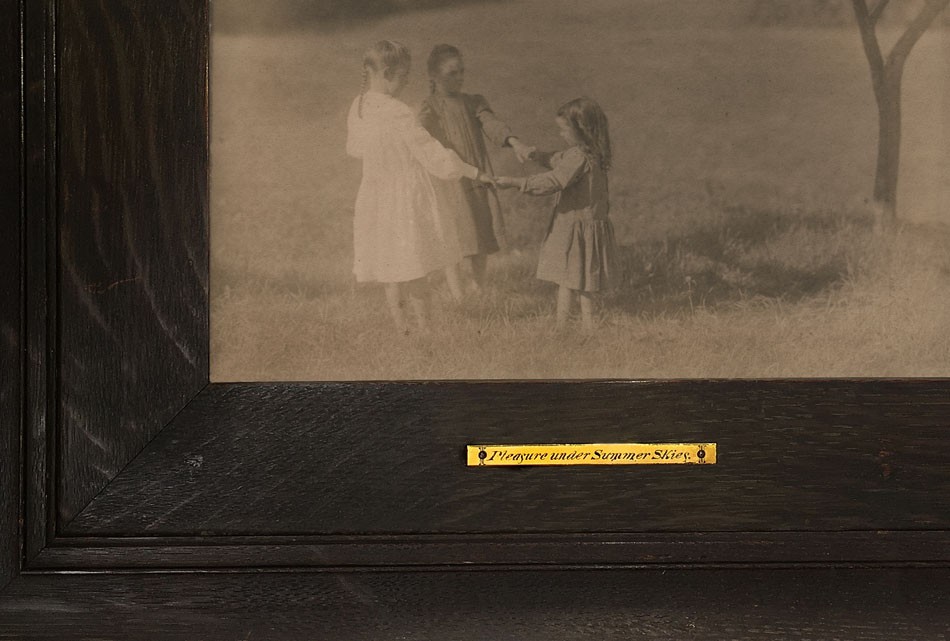 Detail: “Pleasure Under Summer Skies”: William T. Knox, American: (1863-1927) Vintage sepia Platinum print ca. 1905-10; 19.6 x 24.5 | 19.6 x 24.5 cm (flush-mounted on Bristol-board type matrix). Photograph framed in quarter-sawn oak frame with brass title nameplate made by James Engle Underhill, American: (1870-1914) two-piece integrated: 34.5 x 39.5 x 2.0 cm shown with glass removed. “Pleasure Under Summer Skies” dates to 1905, and was initially exhibited in the Second American Photographic Salon, overseen by the American Federation of Photographic Societies under President Curtis Bell. At the time, William Knox was Federation Secretary. From: PhotoSeed Archive
Detail: “Pleasure Under Summer Skies”: William T. Knox, American: (1863-1927) Vintage sepia Platinum print ca. 1905-10; 19.6 x 24.5 | 19.6 x 24.5 cm (flush-mounted on Bristol-board type matrix). Photograph framed in quarter-sawn oak frame with brass title nameplate made by James Engle Underhill, American: (1870-1914) two-piece integrated: 34.5 x 39.5 x 2.0 cm shown with glass removed. “Pleasure Under Summer Skies” dates to 1905, and was initially exhibited in the Second American Photographic Salon, overseen by the American Federation of Photographic Societies under President Curtis Bell. At the time, William Knox was Federation Secretary. From: PhotoSeed Archive
Additionally, three of them were in beautiful wood frames made by his fellow club member James E. Underhill, 1870-1914, who I discovered had made his living as a fine picture framer since around 1900 in New York City at his shop at 33 John Street, at the corner of Nassau Street.
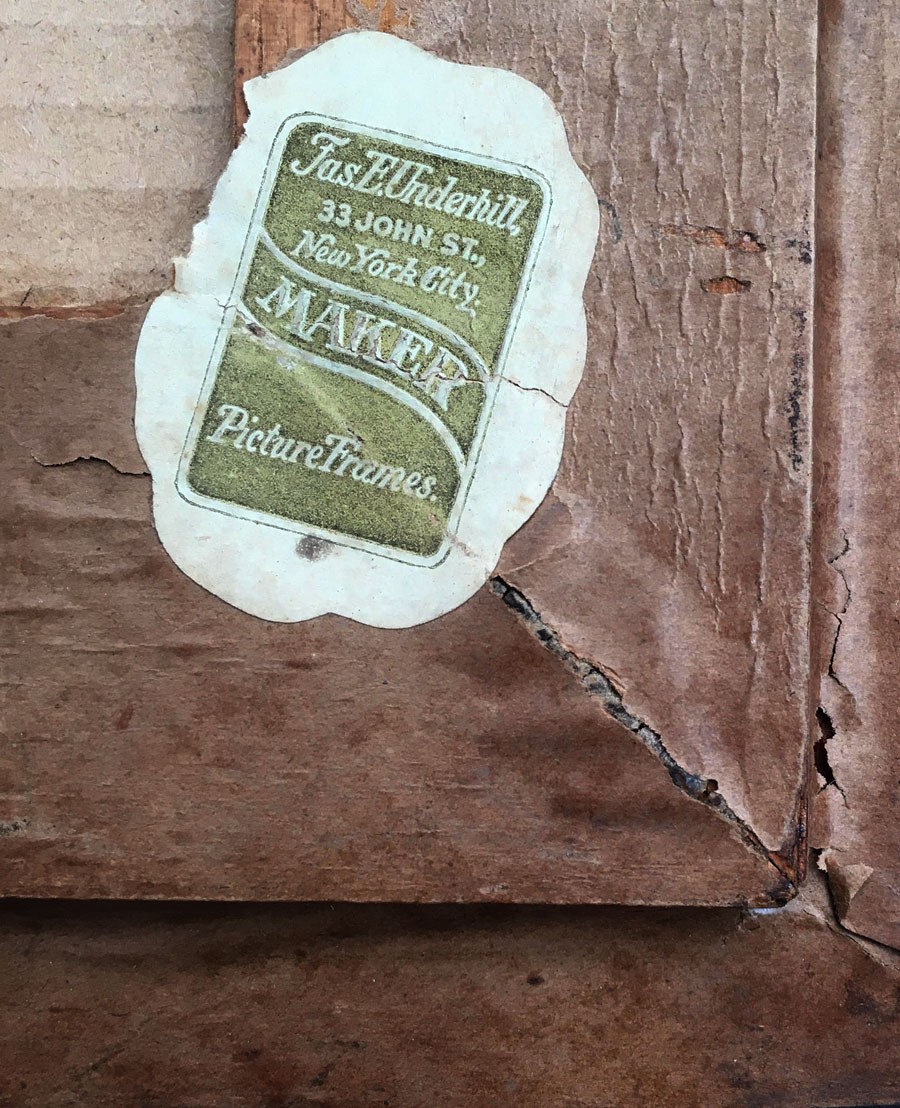 Before limited conservation, the original James E. Underhill white-paper letterpress label in olive-green (2.9 x 2.0 | 4.3 x 3.2 cm) is seen affixed to the frame backing verso of his oak frame enclosing the William T. Knox photograph “Pleasure Under Summer Skies”. Conservation treatment by this archive carefully left this label in place. James Engle Underhill was a fellow member along with Knox at the Brooklyn Camera Club when this photograph was taken and framed. (ca. 1905-10) Underhill’s picture framing shop: “Jas.E.Underhill, 33 John St., New York City. MAKER PictureFrames.” was in operation at this location (corner Nassau) from around 1900 to his death in 1914. From: PhotoSeed Archive
Before limited conservation, the original James E. Underhill white-paper letterpress label in olive-green (2.9 x 2.0 | 4.3 x 3.2 cm) is seen affixed to the frame backing verso of his oak frame enclosing the William T. Knox photograph “Pleasure Under Summer Skies”. Conservation treatment by this archive carefully left this label in place. James Engle Underhill was a fellow member along with Knox at the Brooklyn Camera Club when this photograph was taken and framed. (ca. 1905-10) Underhill’s picture framing shop: “Jas.E.Underhill, 33 John St., New York City. MAKER PictureFrames.” was in operation at this location (corner Nassau) from around 1900 to his death in 1914. From: PhotoSeed Archive
In my 20+ years of collecting photography, and with a definite impression the “bloom is off the rose” when it comes to the intersection of internet commerce, it seems to me today more difficult to acquire vintage photographs of artistic note still in their original frames. This is a pity, because framed photographs left undisturbed from 100+ years ago can often reveal the more honest intent photographers wished for their work to be seen and appreciated- for the time they were created no doubt, but also on a higher aesthetic level.
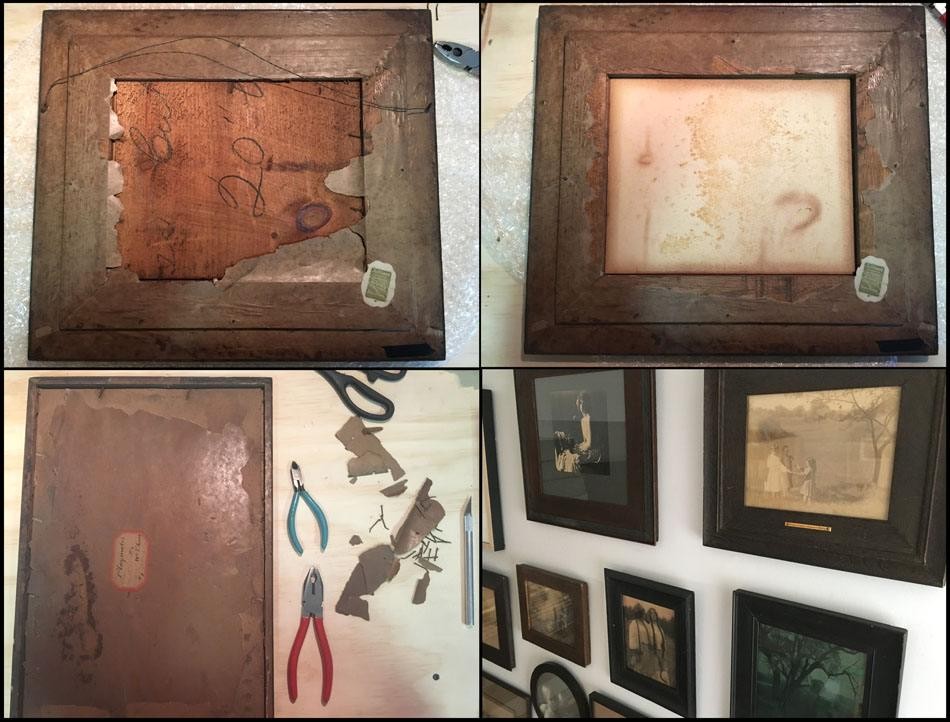 Upper left: When first received by PhotoSeed after purchase in late August, 2019, the verso of the framed William T. Knox photograph “Pleasure Under Summer Skies” is seen in its’ original James E. Underhill oak frame. As was common in framed works from the late 19th and early 20th centuries, a thin sheet of pine wood veneer was used as a backing board, secured by small nails. Upper Right: Conservation treatment on the framed work included removal of this wood backing board along with rusted screw-eyes and wiring used for hanging as well as some of the frame backing paper. The original Underhill framing label is carefully left undisturbed at lower right and the Bristol-board type matrix with flush-mounted photograph on recto is revealed, showing the “burning in” of several wood knot holes from the recto of the original sheet of wood veneer. Next steps included the thorough cleaning of the original framing glass and then cutting a piece of acid-free, 4-ply mat board that would be sandwiched between the photographic matrix and new piece of cardboard backing board. Finally, a Fletcher brand framing gun was used to secure glass, mounted photograph and the two separate backing matrixes using new metal framer’s points to the inside perimeter of the frame verso. Lower Left: Tools at right including small pliers and a wire-cutter were used to remove the original verso framing nails from the William T. Knox photograph “Playmates”, along with an X-Acto knife at far right to cut away the delicate and very acidic backing paper. A unique paper label signed and titled by the artist in the middle of the paper was then carefully removed and preserved within a newly encapsulated frame using a piece of acid-free mat board. New flush-mounted hanging hardware (screw-eyes not recommended!) and braided wire were also installed. Lower Right: A selection shows vintage frames with photographs from the PhotoSeed Archive, including the William T. Knox photograph “Pleasure Under Summer Skies”, now re-installed within its’ original James E. Underhill frame at upper right. To the left of it is a separate frame made by Underhill’s contemporary, George F. Of Jr. (1876-1954) From: PhotoSeed Archive
Upper left: When first received by PhotoSeed after purchase in late August, 2019, the verso of the framed William T. Knox photograph “Pleasure Under Summer Skies” is seen in its’ original James E. Underhill oak frame. As was common in framed works from the late 19th and early 20th centuries, a thin sheet of pine wood veneer was used as a backing board, secured by small nails. Upper Right: Conservation treatment on the framed work included removal of this wood backing board along with rusted screw-eyes and wiring used for hanging as well as some of the frame backing paper. The original Underhill framing label is carefully left undisturbed at lower right and the Bristol-board type matrix with flush-mounted photograph on recto is revealed, showing the “burning in” of several wood knot holes from the recto of the original sheet of wood veneer. Next steps included the thorough cleaning of the original framing glass and then cutting a piece of acid-free, 4-ply mat board that would be sandwiched between the photographic matrix and new piece of cardboard backing board. Finally, a Fletcher brand framing gun was used to secure glass, mounted photograph and the two separate backing matrixes using new metal framer’s points to the inside perimeter of the frame verso. Lower Left: Tools at right including small pliers and a wire-cutter were used to remove the original verso framing nails from the William T. Knox photograph “Playmates”, along with an X-Acto knife at far right to cut away the delicate and very acidic backing paper. A unique paper label signed and titled by the artist in the middle of the paper was then carefully removed and preserved within a newly encapsulated frame using a piece of acid-free mat board. New flush-mounted hanging hardware (screw-eyes not recommended!) and braided wire were also installed. Lower Right: A selection shows vintage frames with photographs from the PhotoSeed Archive, including the William T. Knox photograph “Pleasure Under Summer Skies”, now re-installed within its’ original James E. Underhill frame at upper right. To the left of it is a separate frame made by Underhill’s contemporary, George F. Of Jr. (1876-1954) From: PhotoSeed Archive
On a technical note, PhotoSeed does minimum conservation on framed works when they enter the collection. The mantra of “do no harm” as well as the realization of being temporary custodians of an archive is embraced. When in doubt about proceeding with photographic conservation, advice given me many years ago from a George Eastman Museum conservator to basically just leave things alone when unsure of how to proceed is something I’ve always kept in mind. Of course, the financial realities of proper conservation standards will always be at the forefront for collectors, both private and institutional.
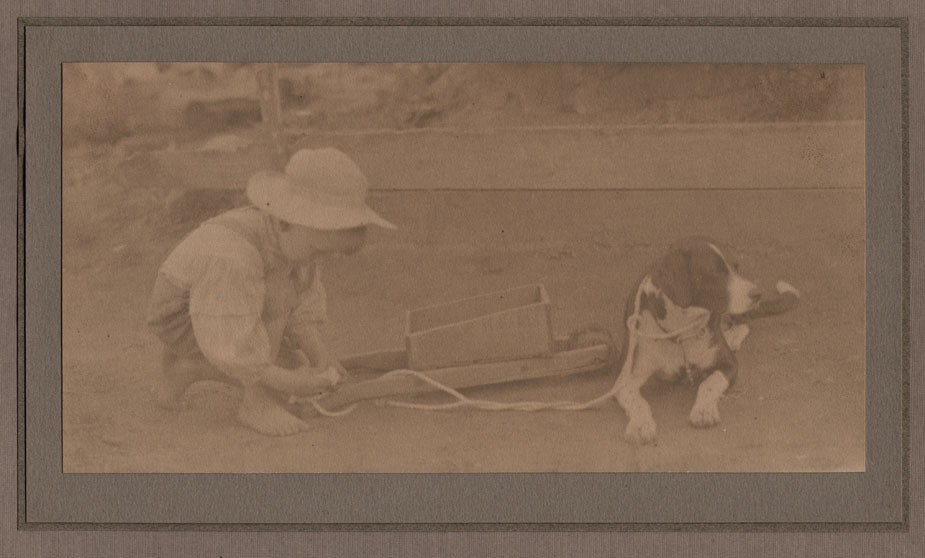 “Playmates”: William T. Knox, American: (1863-1927) Vintage sepia Platinum print ca. 1905-10; image: 12.0 x 23.5 mounted on fine art papers: 19.6 x 24.5 | 19.6 x 24.5 cm. This fine children’s genre study by Brooklyn Camera Club president William T. Knox dates to 1905 or slightly before as it was known to have been exhibited in the Second American Photographic Salon that year. It shows a young child attaching a leash from his faithful canine companion to his toy wooden wheelbarrow. From: PhotoSeed Archive
“Playmates”: William T. Knox, American: (1863-1927) Vintage sepia Platinum print ca. 1905-10; image: 12.0 x 23.5 mounted on fine art papers: 19.6 x 24.5 | 19.6 x 24.5 cm. This fine children’s genre study by Brooklyn Camera Club president William T. Knox dates to 1905 or slightly before as it was known to have been exhibited in the Second American Photographic Salon that year. It shows a young child attaching a leash from his faithful canine companion to his toy wooden wheelbarrow. From: PhotoSeed Archive
Frame Conservation: A Few Ideas
For framed works, conservation on my end typically includes the removal of acidic frame backing materials and replacement with acid-free mounting materials that come into direct contact with the physical print. Embedded dirt and other foreign matter is then carefully removed and or wiped away from the frame itself, with original finishes showing the passing of decades left deliberately intact and never stripped off. Finally, everything is put back together for storage or display: the original glass from the frame is also cleaned on both sides and then carefully put back into place. If cracks are discovered or worse, replacement with a custom cut piece of window glass will typically suffice.
Digital Presentation on PhotoSeed
For digital presentation on this website, the frame is then photographed separately and the print scanned. I use Photoshop to combine the two-leaving the original framing glass out. Purists may object to this but I’m not changing the physical object in any way-just taking advantage to present you with an optimum web experience. Of course, the joy of collecting is being able to appreciate a vintage photograph in the very best form possible: in person. Never the less, I’ve included a small photo along with three other conservation snaps in this post showing a small display of conserved and “reframed” works from this archive. Other examples can be found here.
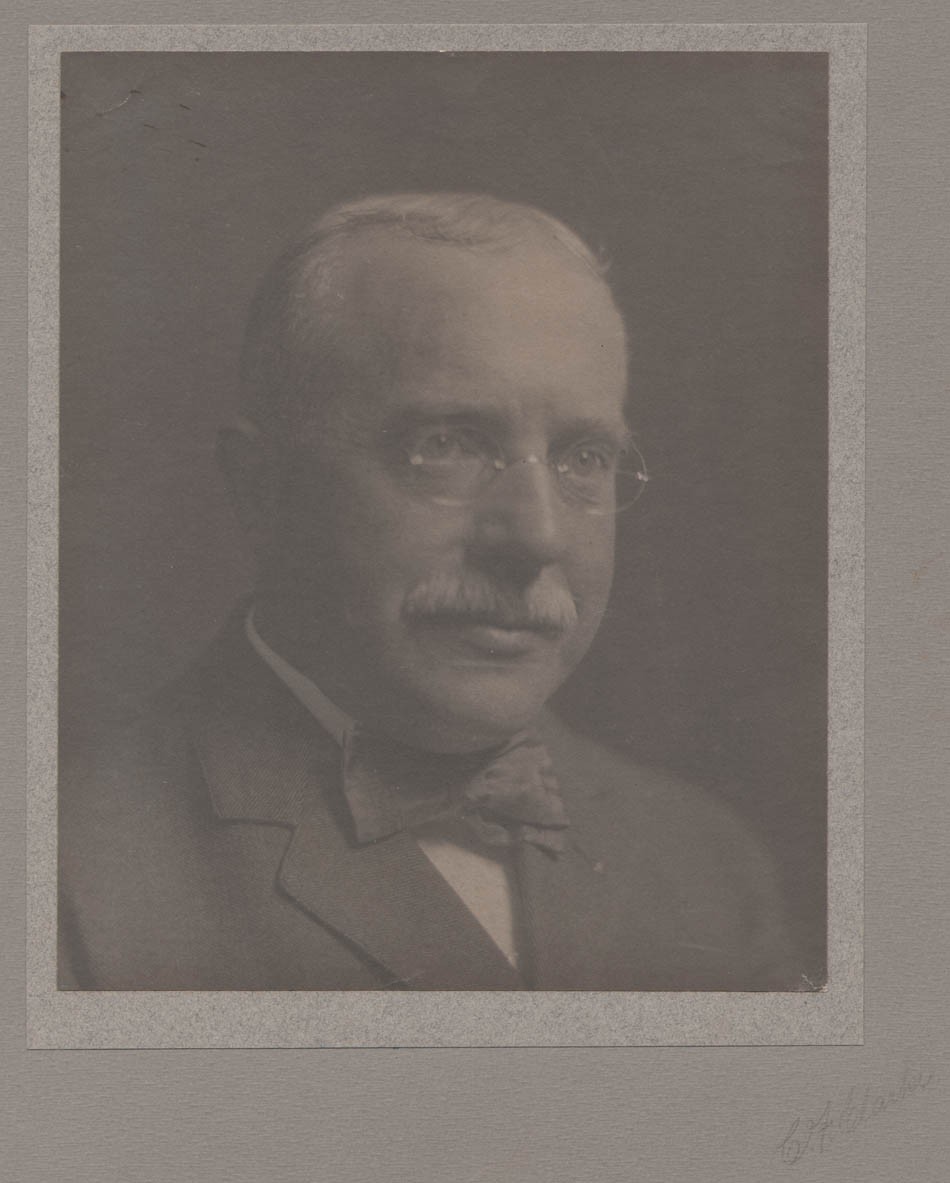 “Portrait: Brooklyn Camera Club President William T. Knox”: Charles Frederick Clarke, American, born Nova Scotia: (1865-1912) image: 21.7 x 17.8 cm; supports: light-gray art paper 23.7 x 19.4 | 36.4 x 29.5 cm; Vintage platinum print ca. 1905-10. William T. Knox (1863-1927) was an important American amateur photographer and promoter of photography from Brooklyn, New York. From at least 1891-1915, he was a partner of McCormick, Hubbs & Co., importers and commission merchants in West India and Florida Fruits and Produce with offices at 279 Washington Street in New York City. (Manhattan) From: PhotoSeed Archive
“Portrait: Brooklyn Camera Club President William T. Knox”: Charles Frederick Clarke, American, born Nova Scotia: (1865-1912) image: 21.7 x 17.8 cm; supports: light-gray art paper 23.7 x 19.4 | 36.4 x 29.5 cm; Vintage platinum print ca. 1905-10. William T. Knox (1863-1927) was an important American amateur photographer and promoter of photography from Brooklyn, New York. From at least 1891-1915, he was a partner of McCormick, Hubbs & Co., importers and commission merchants in West India and Florida Fruits and Produce with offices at 279 Washington Street in New York City. (Manhattan) From: PhotoSeed Archive
Intriguingly, I have owned a platinum portrait of William T. Knox, showing him to be quite the dapper gentleman- mustachioed, and sporting a bow tie taken about the same time he was club president, for many years prior to my collecting any of his actual photographs. This was by Charles F. Clarke, 1865-1912, (American, born Nova Scotia) an amateur and business agent for the Forbes Lithograph Company of Springfield, MA.
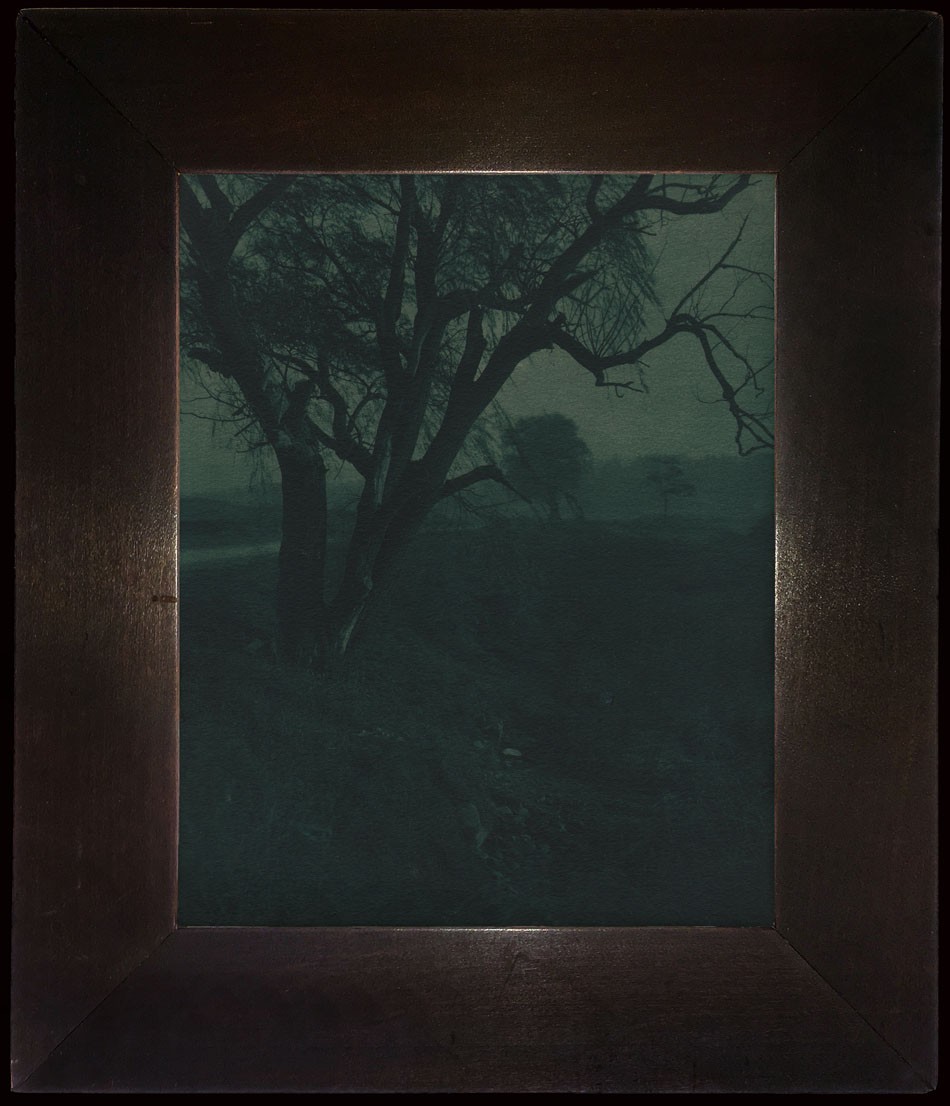 “Landscape in Green Carbon”: attributed to William T. Knox, American: (1863-1927) Vintage green Carbon print ca. 1905-10; image: 23.4 x 19.7 cm flush mounted to thick, Bristol-board type matrix: 23.6 x 19.7 cm shown within its’ original oak frame: 32.6 x 28.6 x 2.0 cm (with glass removed) by James E. Underhill (1870-1914) of New York City. Knox and Underhill were members of the Brooklyn Camera Club when this photograph was taken and framed. From: PhotoSeed Archive
“Landscape in Green Carbon”: attributed to William T. Knox, American: (1863-1927) Vintage green Carbon print ca. 1905-10; image: 23.4 x 19.7 cm flush mounted to thick, Bristol-board type matrix: 23.6 x 19.7 cm shown within its’ original oak frame: 32.6 x 28.6 x 2.0 cm (with glass removed) by James E. Underhill (1870-1914) of New York City. Knox and Underhill were members of the Brooklyn Camera Club when this photograph was taken and framed. From: PhotoSeed Archive
You can see all of Mr. Knox’s framed works in the collection here, which includes a professional chronology for his friend the framer and fellow Brooklyn Camera Club member James E. Underhill. Happy hunting! -David Spencer